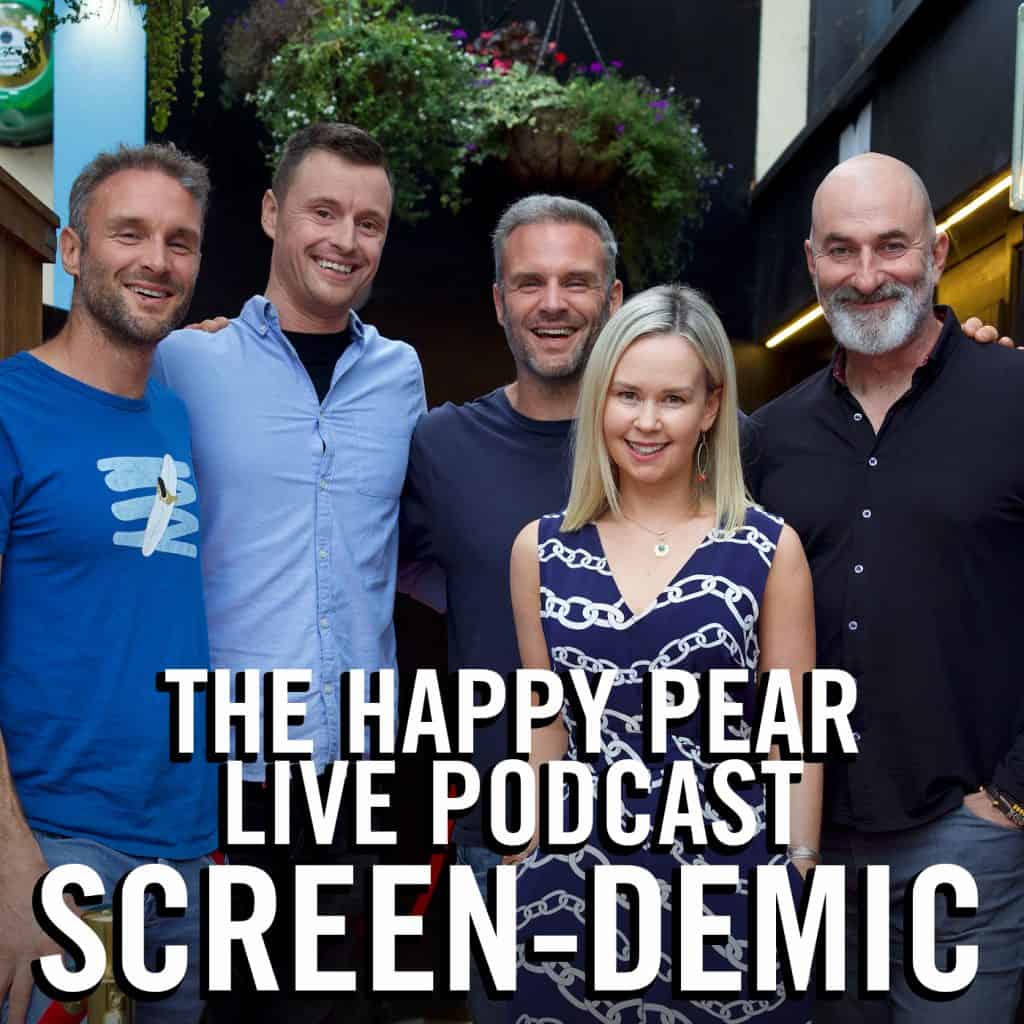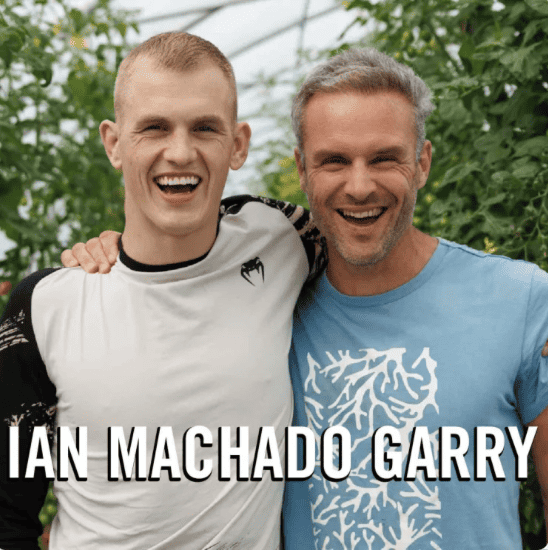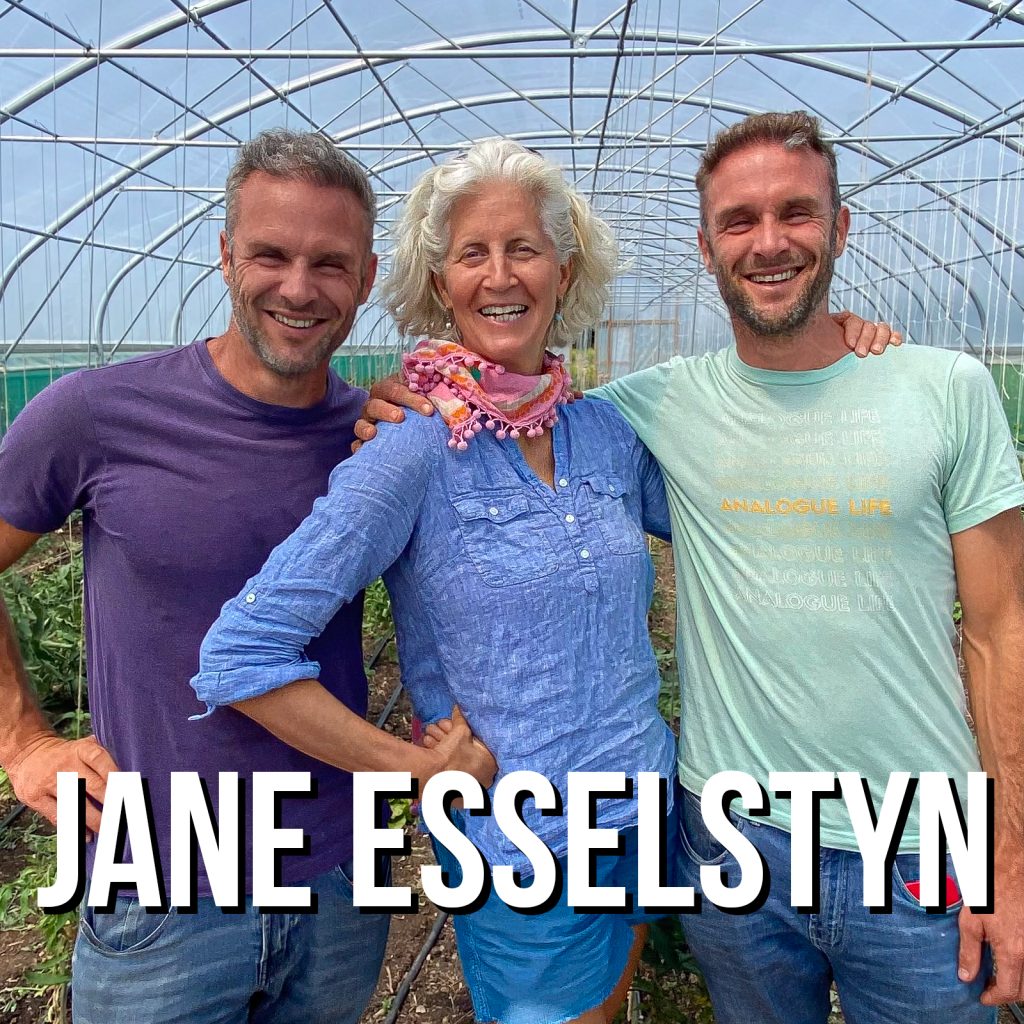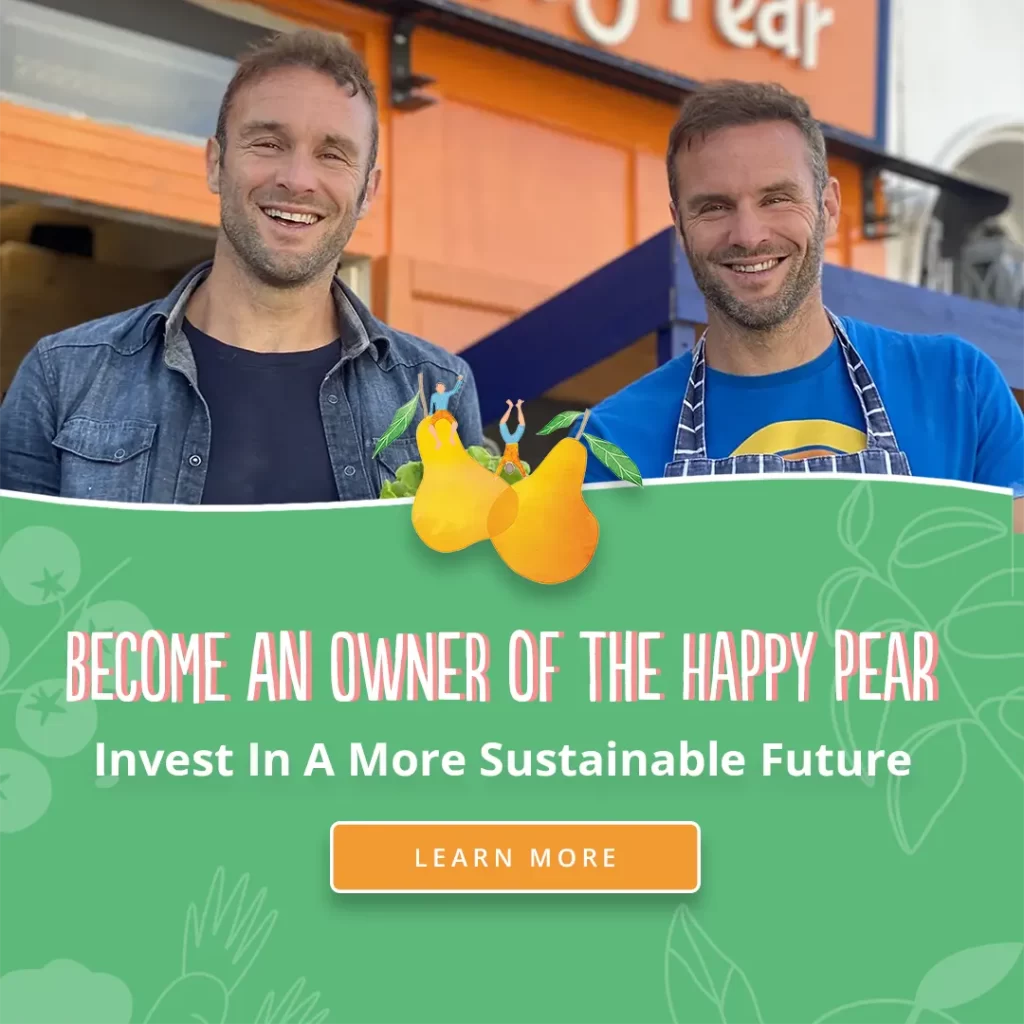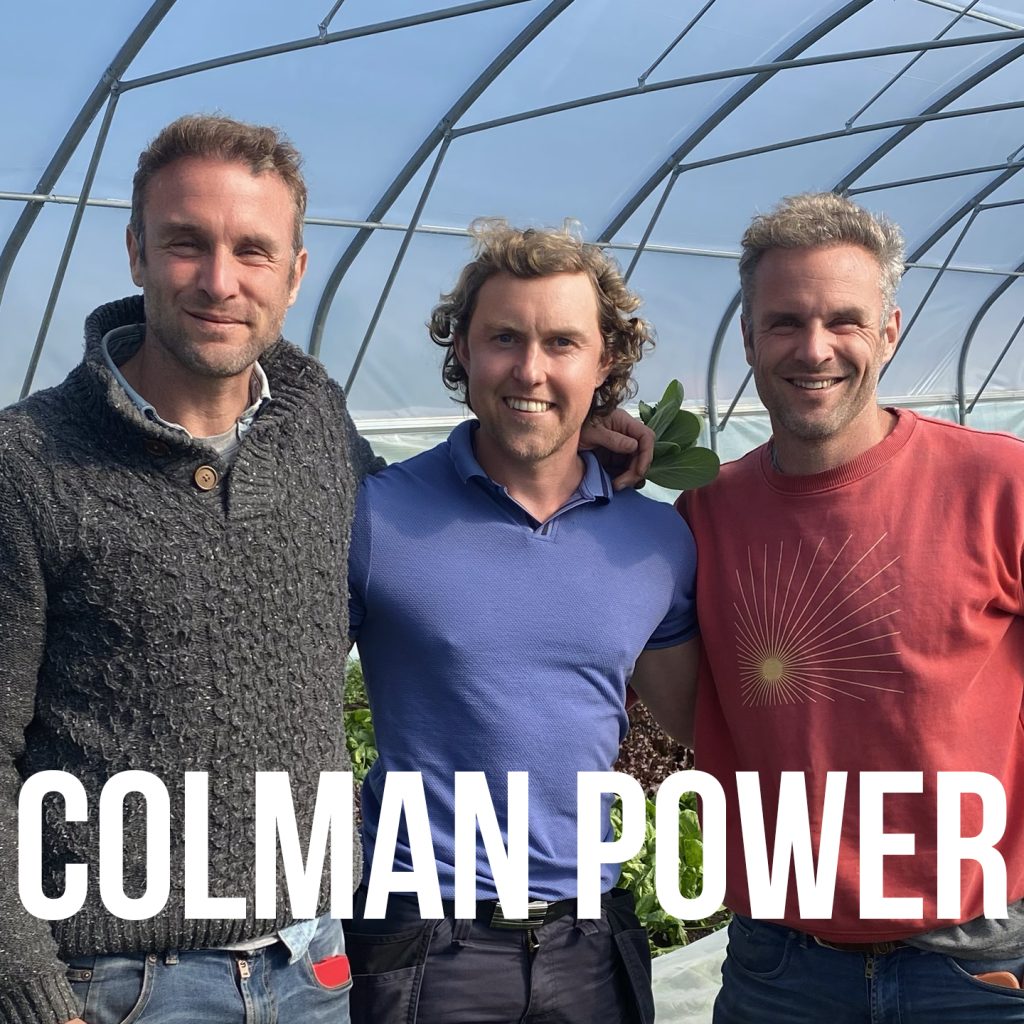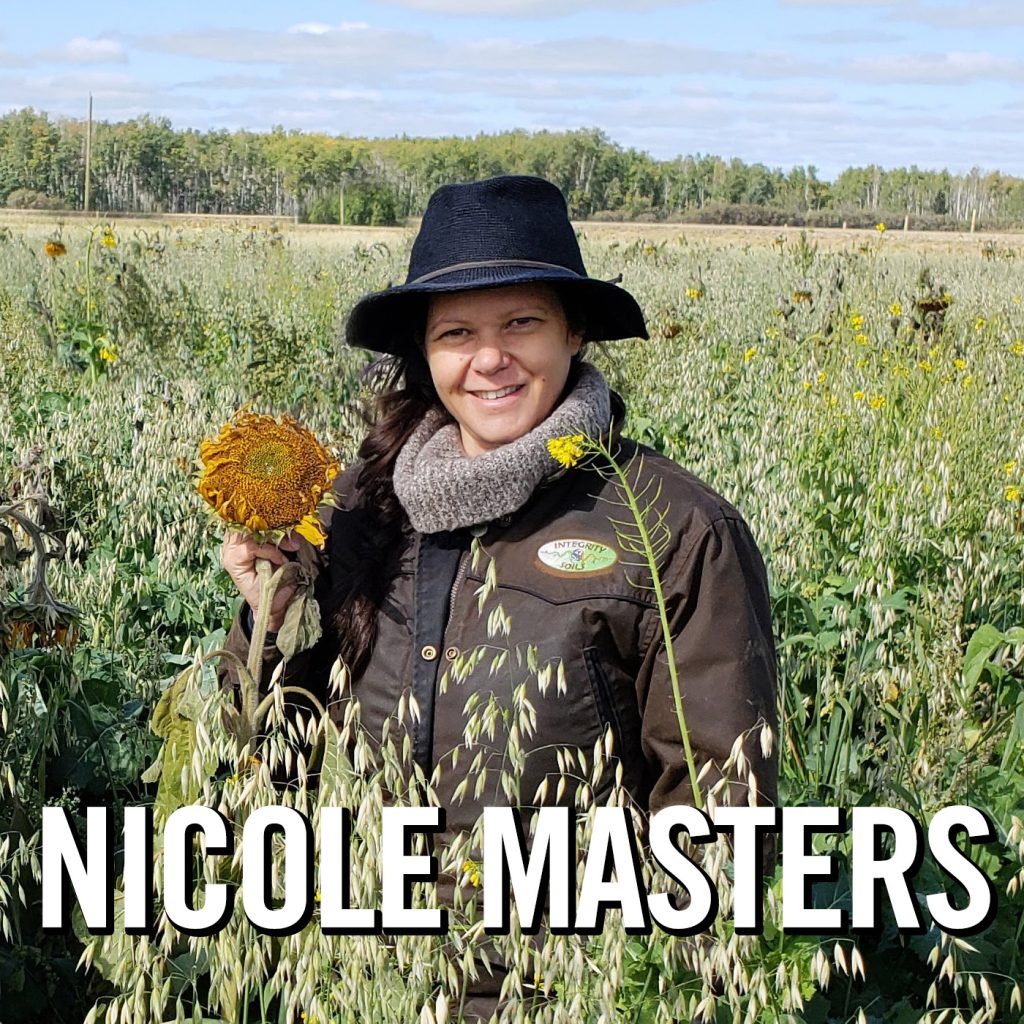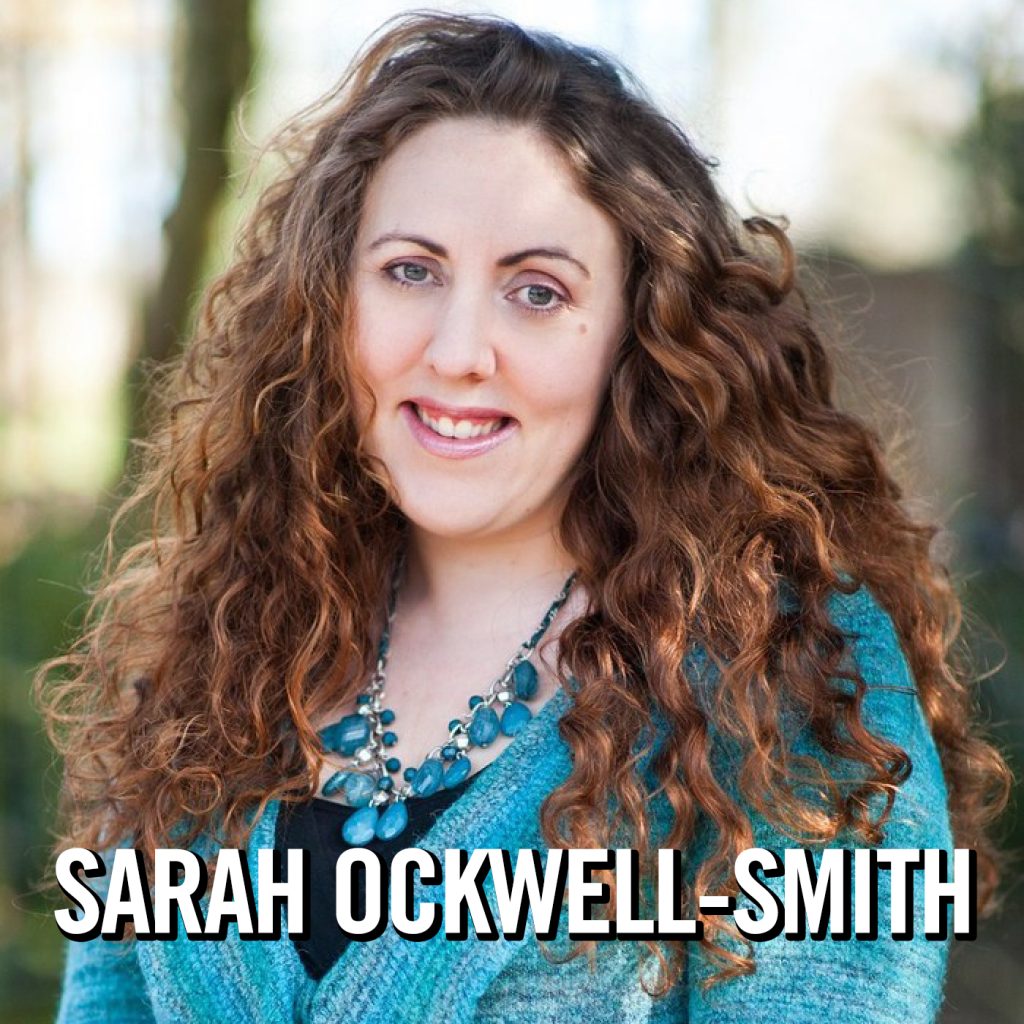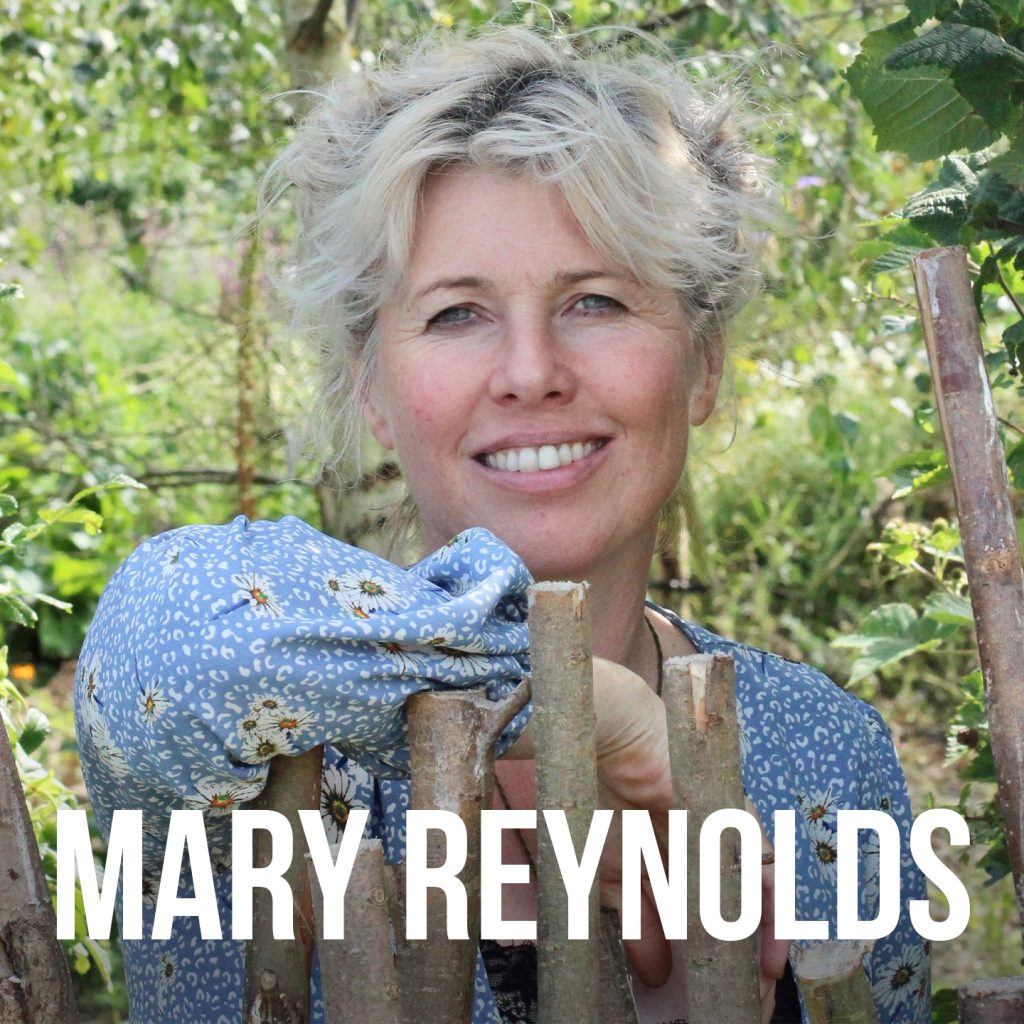The Happy Pear Podcast
This week’s episode is with Dr. Dani Gordon, with an impressive background, holding certifications from the American Board of Integrative Medicine (ABOIM) and the American Board of Integrative Holistic Medicine (ABIHM).
Episode 145
With a passion for comprehensive healthcare, Dr. Gordon has become a sought-after expert in the field of Integrative Medicine. Her dedication to exploring alternative and holistic approaches to healthcare has positioned her as a leader in the global medical community.
Our conversation with Dr. Dani covers a spectrum of vital topics. We begin by exploring burnout, with Dr. Gordon providing keen insights into recognising the signs and offering practical strategies for prevention. The discussion transitions into the realm of chronic diseases, where we delve into the intersection of Integrative Medicine and effective management of chronic health conditions.
A significant portion of our conversation is dedicated to the critical role of sleep in maintaining overall well-being. Dr. Gordon shares actionable tips on optimising sleep patterns and enhancing sleep quality, offering valuable advice for our listeners seeking better sleep hygiene.
Further, we uncover why Dr. Dani Gordon is the go-to expert for medical professionals when faced with challenging cases. Her unique perspectives and methodologies in Integrative Medicine has earned her a reputation as the person doctors turn to when conventional answers fall short.
For those eager to stay connected with Dr. Dani Gordon, visit her website at London Resilience Clinic and follow her on Twitter @DrDaniGordon and Instagram @DrDaniGordon.
Lots of Love,
Dave & Steve
BLACK FRIDAY SPECIAL
Our sponsors, Instant Brands have an amazing Black Friday offer, availbale until the 27th Novemeber!
Savings of up to 40% off across their range of Instant Vortex Air Fryers – lowest prices ever.
The Vortex VersaZone is now £80 off, only £119.99 from £199.99 – Choose your basket size – use as an XXL 8.5L basket for roasting big joints, tray bakes or batch cooking, or split into 2 x 4.2L zones to cook two foods two ways, ready at the same time. Visit the following LINK to avail of this offer.
We, The Happy Pear, are thrilled to announce our massive Black Friday sale, featuring a 50% discount on all our online courses, including membership to our app. Whether you aim to enhance your heart, gut, skin, or overall health, grappling with menopause, aspiring to master sourdough baking, or delving into plant-based cooking and more, we’ve collaborated with experts in their respective fields to present these extraordinary courses. Don’t miss out on this limited offer—visit the following LINK
Sign up to our Newsletter for updates on our latest recipes, events, and news.
Produced by Sean Cahill & Sara Fawsitt
Available now from all good podcast providers:
High protein falafel wrap!! Super easy to make and genuinely delicious! We use tempeh or tofu as the extra protein hit, add in more chilli or spices for a more punchy flavour. When we made these first we ended up eating them for brekkie and they went down a treat!
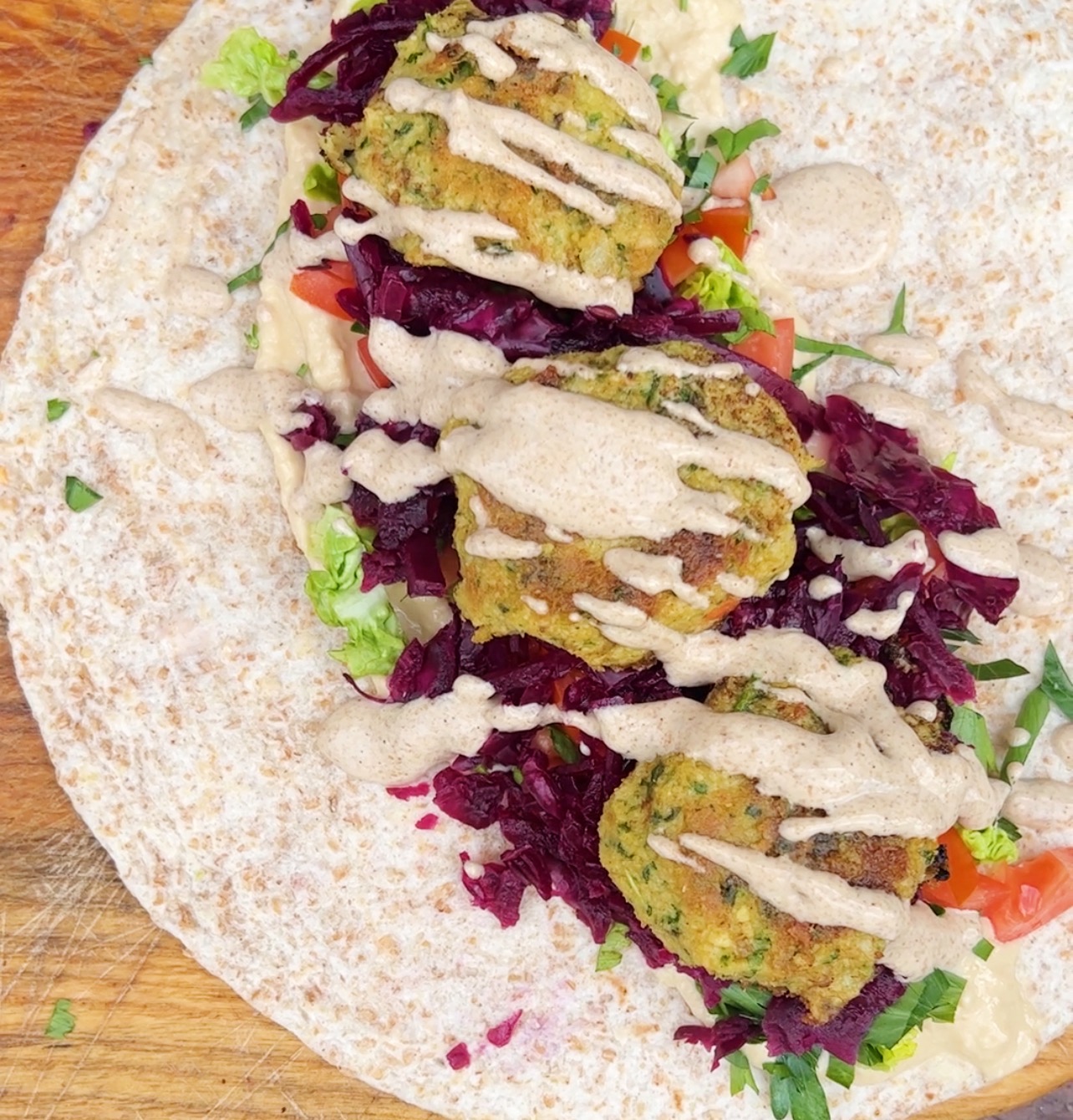
High Protein Falafel Wrap
Takes 13 minutes
Serves 23
Ingredients
Falafel
- 400 g chickpeas
- 1/2 onion
- 2 cloves garlic
- 2 tsp ground cumin
- handful fresh parsley
- 150 tempeh
- 1 lemon juice
- 1/2 tsp salt
- 1/4 tsp ground black pepper
- 2 tbsp oil for frying
To assemble
- 2 wholemeal tortilla
- 350 g hummus
- 1 tomato
- 1 baby gem lettuce
- 100 g red sauerkraut
- 3 tbsp tahini
- 6 tbsp yoghurt we used coconut!
- 15 g fresh parsley
Instructions
- Drain and rinse the chickpeas. Peel the onion and garlic and roughly chop.
- Dice the parsley and roughly chop the tempeh and add them all to a food processor or blender along with the lemon juice, salt, black pepper, cumin and pulse/ blend until it comes together but not too much.
- Using a spoon or clean hands shape into small balls.You can cook them in a deep fat fryer for a crispier, more authentic falafel, or shallow fry them in a non-stick pan with the 2 tbsp of oil and else bake them in an air fryer or oven for a lower fat version. Cook the falafel till lightly brown on the outside.
- Dice the tomato, slice the lettuce. For the tahini cream, mix the tahini along with the yoghurt with juice of 1/2 a lemon until it comes together into a lovely cream that can drizzle nicely.
- To bring together, on a wrap or tortilla add a generous spread of hummus, some tomato, lettuce, sauerkraut, the falafel, drizzle over the tahini cream and finish with some pickled red onions for a nice acidic pop! Wrap up and enjoy!
Nutrition
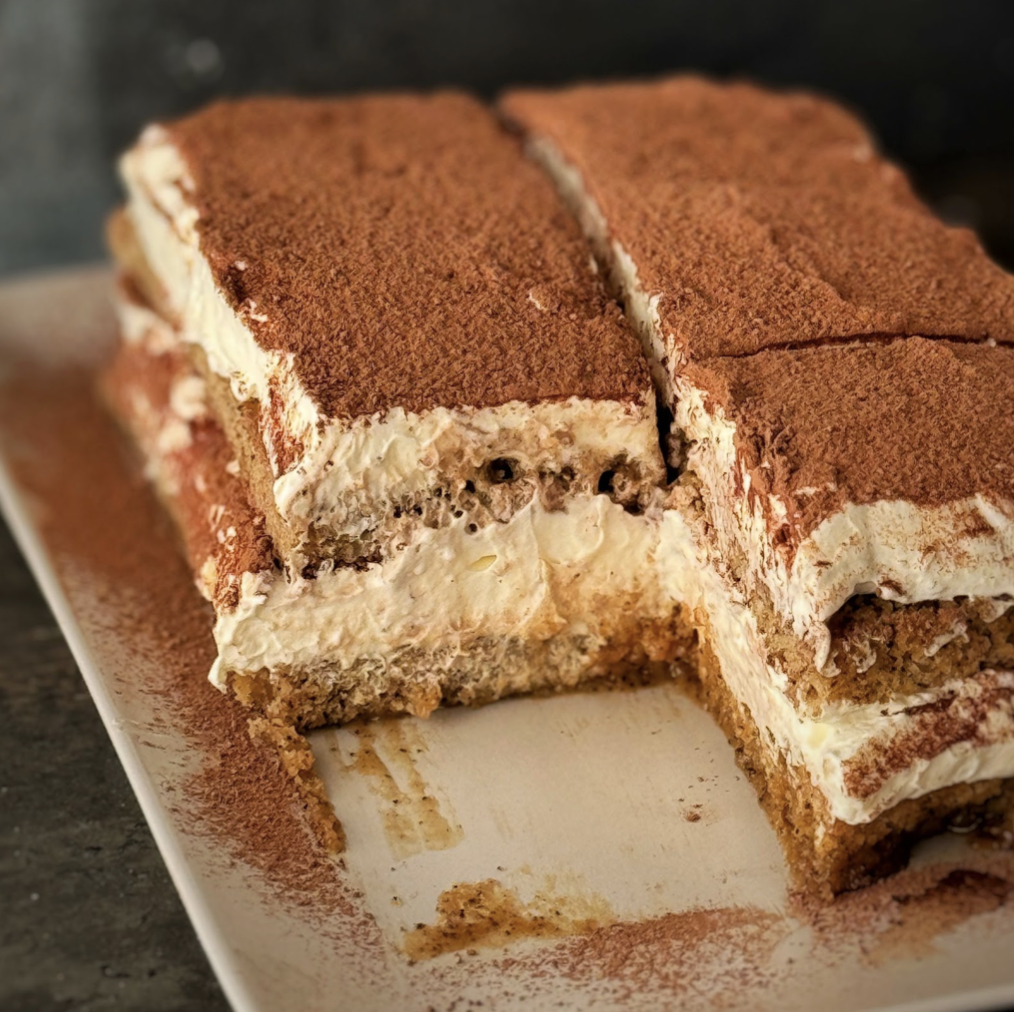
Tiramisu
Takes 40 minutes
Serves 10
Ingredients
For the Vegan Lady Fingers (Sponge):
- 200 g white flour
- 150 g caster sugar
- 1 tbsp baking powder
- ¼ tsp baking soda
- 150 ml oat milk or other plant milk of choice
- 50 ml neutral oil e.g., sunflower or vegetable oil
- ½ tbsp vinegar
- ½ tsp vanilla essence
For the Coffee Mixture:
- 300 ml strong coffee
- 50 ml brandy marsala, Kahlua, or additional vanilla essence
For the Cream Layer:
- 900 g coconut cream or 200 g vegan cream cheese & 250 g vegan double cream
- 100 g icing sugar
- ¾ tsp vanilla essence
For Topping:
- 2 tbsp cocoa powder
- 30 g grated dark chocolate
Instructions
- Preheat and Prepare the Pans:Preheat the oven to 180°C (fan).Line two 25 x 35 cm brownie trays with parchment paper.
- Make the Vegan Lady Fingers:In a large mixing bowl, combine the flour, caster sugar, baking powder, and baking soda. Sift the dry ingredients to remove any lumps.In a separate bowl, mix the oat milk, oil, vinegar, and vanilla essence.Create a well in the centre of the dry ingredients and pour in the wet mixture. Mix gently using a spatula or hand mixer until just combined.Divide the batter evenly between the two prepared trays, spreading it into a thin, even layer.Bake for 25 minutes, then remove from the oven and allow the sponge to cool completely.Once cooled, slice the sponge into 16 fingers (approx. 3 cm wide and 10 cm long).Return the sliced sponge fingers to the oven for an additional 10 minutes to dry out slightly, then set aside to cool fully.
- Prepare the Cream Layer:If using coconut cream, chill the coconut milk in the fridge beforehand to separate the cream layer.Scoop the thick coconut cream from the top of the can, add the icing sugar and vanilla essence, and mix gently until smooth, avoiding over-mixing as this may cause curdling.If using vegan cream cheese and double cream, whip the double cream until it reaches soft peaks, then fold in the cream cheese, icing sugar, and vanilla essence. Mix until a thick, smooth consistency is achieved.
- Prepare the Coffee Mixture:In a shallow bowl, combine the strong coffee and brandy (or your chosen alternative) and stir to mix.
- Assemble the Tiramisu:Quickly dip each sponge finger into the coffee mixture, ensuring they’re soaked but not overly saturated.Layer half of the soaked lady fingers on the base of a serving dish.Spread half of the cream mixture evenly over the lady fingers.Add a second layer of soaked lady fingers, followed by the remaining cream. Smooth the top evenly with a spatula.Place the assembled tiramisu in the fridge to chill for 20 minutes to 1 hour, allowing it to firm up.
- Finish and Serve:Before serving, dust the top with 2 tablespoons of cacao powder through a fine sieve.Sprinkle the grated dark chocolate evenly over the top.For a variation, garnish with freeze-dried raspberries or strawberries if available.
- Enjoy:Serve chilled and enjoy this creamy, indulgent tiramisu!
The Happy Pear Podcast
Adam Guthrie, a distinguished plant-based chef and health advocate, shares his incredible journey on this latest episode.
Episode 144
Adam’s life took a dramatic turn when he embraced a plant-based lifestyle that not only saved his life but also became the cornerstone of his mission to help others achieve wellness. With a personal transformation story that’s both inspiring and compelling, Adam’s experience navigating the world of plant-based cuisine is truly remarkable. He channels his expertise into empowering individuals to shed weight and reclaim their health through tailored courses and rejuvenating retreats.
In this episode we dive into a captivating conversation with Adam Guthrie. Discover the pivotal moments that led him to adopt a plant-based lifestyle, learning how this choice became the catalyst for his personal and professional transformation. Through this episode, explore how Adam transitioned from a life-changing health experience to becoming a leading figure in the realm of plant-based culinary arts. His dedication to guiding others in embracing a healthier lifestyle through his courses and retreats is both insightful and inspirational.
Prepare to be inspired and motivated to embark on your own path towards a healthier, plant-powered life.
Lots of Love,
Dave & Steve
Episode Sponsors & Discount Codes:
Instant Brands: One of our favourite kitchen accessories! Instant Brands have a number of amazing products that make cooking easier, tastier and accessible to all. For a limited time only (Until the 23rd of November) click THIS LINK to get up to 30% off on some of their amazing products!
Sign up to our Newsletter for updates on our latest recipes, events, and news.
Produced by Sean Cahill & Sara Fawsitt
Available now from all good podcast providers:
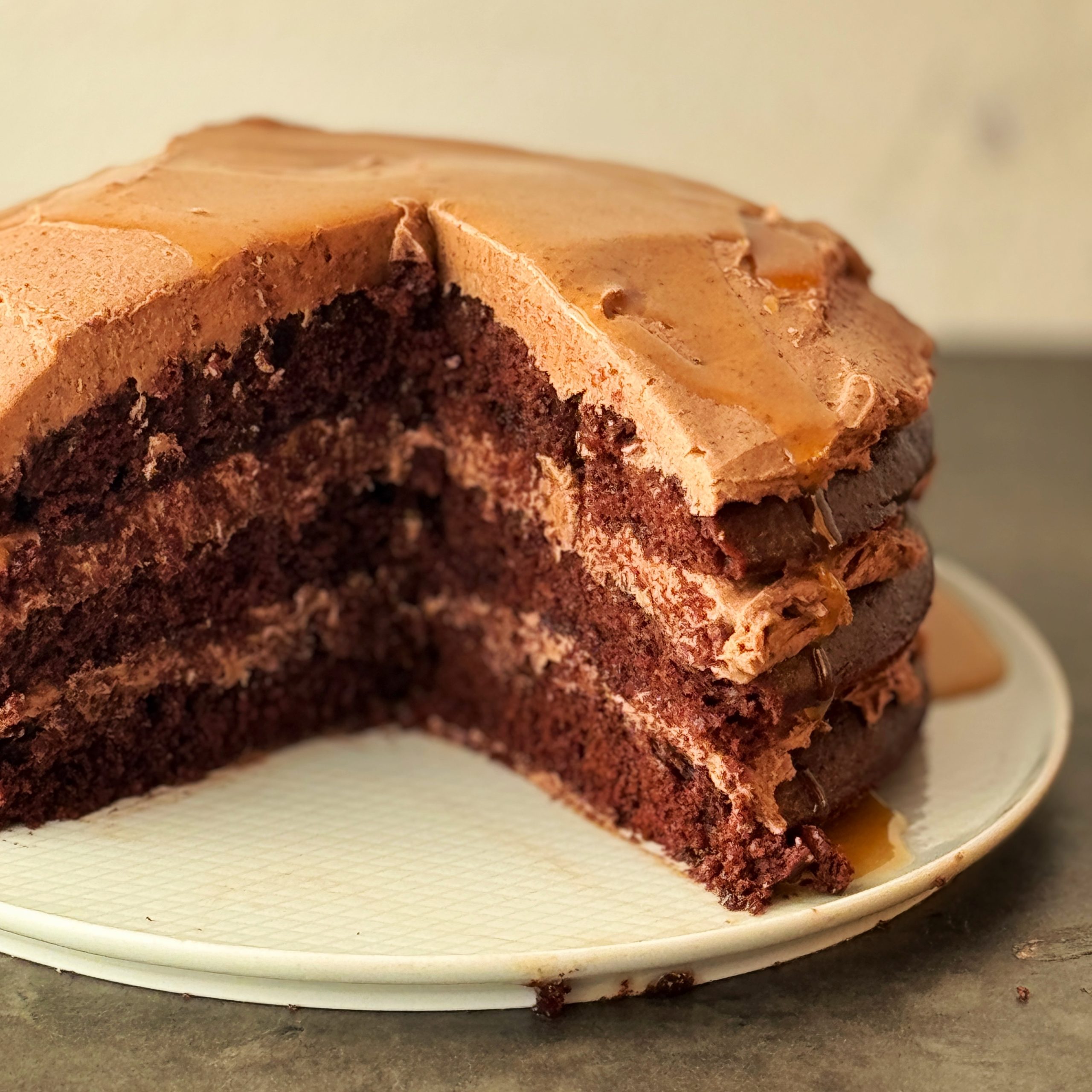
Chocolate, coffee caramel 3 tiered cake
Takes 59 minutes
Serves 16
Ingredients
Chocolate sponge
- 300 g self raising flour
- 250 g sugar
- 70 g cacao powder
- 1 tsp baking powder
- ¼ tsp baking soda
- 300 ml strong black coffee
- 100 g vegetable oil
- 1 tsp vanilla essence
- 100 g coconut yoghurt
Caramel sauce
- 200 g sugar
- 50 g plant based butter
- 100 ml coconut cream the fat from 1 tin of coconut milk
Buttercream
- 300 g vegan block butter
- 580 g icing sugar
- 4 tbsp cocoa powder
- 2 tbsp ground coffee powder
- 2 tbsp plant milk
Instructions
- Method;
- Preheat oven to 180 C degrees fan
- Grease and line 3 x 20cm (or 8 inch) springform cake tins with baking parchment on the base.
- In a large mixing bowl, Sieve in all the dry ingredients, the flour, sugar, cacao powder, baking powder and baking soda and mix well. Make a well in the centre.
- In a jug mix the coffee, coconut yoghurt, vegetable oil, and the vanilla essence.
- Add the wet ingredients to the dry ingredients and mix well until they just come together into a nice smooth uniform batter using a spatula.
- Split the mixture between the three lined cake tins and smooth it so it’s level on top. Place in the preheated oven for 20-26 minutes rotating half-way through cooking time to ensure they cook evenly. To check if cooked by placing a skewer in the centre, it should come out clean, if not put back in the oven and cook a little longer until the skewer comes out clean and dry. Remove cakes from the oven and set aside on a rack to cool fully.
- While the cakes are cooling, prepare the butter cream and caramel.
- For the Chocolate buttercream – Add the vegan butter to a large bowl and using an electric whisk or fork cream the butter, sift in the icing sugar and the cacao powder, coffee and 2 tbsp of plant milk. Using a fork or whisk, bring it all together. Alternatively you can use an electric mixer or stand mixer but a fork will also work fine too!
- To make the caramel, add the caster sugar to a medium sized saucepan, along with 3 tbsp of water, give it a mix till it comes together and looks a little like a syrup. Put on a high heat and do not stir it again, leave to cook for approx 5-6 mins until the edges start to go lightly golden. Cut 50g of plant based butter into 6 cubes and carefully add them in, next add in the 100g of coconut cream. Turn the caramel off the heat and use a whisk to bring it together to a smooth silky golden caramel.
- Once the 3 cakes have cooled, use a serrated knife to level the 3 cakes
- To assemble the cake, choose the base and add 2 tbsp of butter cream to a flat plate or cake board and spread it out and add the base layer, add ⅓ of the buttercream to the top of this base cake, gently spreading evenly using a spatula to the edge.
- Add a generous drizzle of caramel on top of the butter cream, ensuring not to go over the edges and gently place the second cake on top, pressing it down lightly so the filling just comes to the edge. Then add another ⅓ of the butter cream to the top of the cake, again working your way from the centre, spreading the butter cream to the edge. Add a good drizzle of caramel on top of this butter cream and add the final cake on top, followed by the remaining butter cream and finish by carefully drizzling some caramel over the top (not too much but enough to create some lovely droplets. Keep any remaining caramel to serve.
- Slice into big door stopper slices and enjoy!

Golden Cauliflower florets with almond cream and pomegranate jus
Takes 30 minutes
Serves 4
Ingredients
- 1 cauliflower
- 1 tsp ground turmeric
- 1 tbsp oil
Almond cream
- 500 ml natural soy yoghurt
- 5 tbsp almond butter
- Juice of 1/2 Lemon
- Pinch of salt
Pomegranate quick jus
- 1 pomegranate
- 1 tbsp maple syrup
- 2 tbsp tararmi/ soy sauce
- 1/2 tsp chilli powder optional
To serve
- 1 pomegranate
- 15 g fresh coriander
- Crackers or toasted sourdough
Instructions
- Preheat oven to 200 degrees C
- Fill and boil the kettle. Cut the cauliflower into bite size florets while keeping some of the smaller leaves and add to a medium sauce pan and cover with just boiled water. Add a generous pinch of salt and the tsp of turmeric powder and mix and bring to a boil, reduce to a simmer and leave to cook for 8 mins. Drain and add to a baking tray along with a generous pinch of salt and 1 tbsp of oil and mix well. Bake for 10-14 mins until it starts to charr around the edges. Take out and set aside.
- For the pomegranate jus cut the pomegranate in half and place over a medium sized bowl and squeeze all the juice you can out of it including the seeds and pulp. Add to a small saucepan along with the tamari/ soy sauce, maple syrup and chilli powder and bring it to a boil, reduce to a simmer while stirring continuously and allow it to reduce for 4-5 mins. Pour through a sieve into a bowl to remove the seeds. It should be the texture of a nice syrup or a pomegranate molasses and have a real strong taste.
- For the almond cream add the yoghurt to a bowl along with the almond butter, lemon juice and salt and mix until it comes together into a nice cream. Taste and adjust the seasoning to your liking.
- Shook the seeds from the last remaining pomegranate and finely dice the coriander. Toast any bread.
- To plate up on a large plate pour on the almond cream and spread it out towards the edge of the plate leaving some room in the middle. Add in the roasted cauliflower, drizzle over the full pomegranate jus, sprinkle over some pomegranate seeds and the diced coriander.
- Enjoy!
The Happy Pear Podcast
We are thrilled to welcome back one of our favorite guests, Dr. Melanie Joy. Dr. Melanie Joy is a renowned psychologist and author, known for her groundbreaking work in the fields of relational literacy and the study of carnism.
Episode 143
Dr. Melanie Joy is a distinguished psychologist with a wealth of expertise in the domains of communication, relationships, and activism. Her insights have been transformative and enlightening, making her a sought-after authority on these subjects.
We had the privilege of recording in person with Dr. Melanie Joy. Together, we delved into the concept of relational literacy and how it plays a pivotal role in effective communication, not only on a personal level within your own relationships but also on a global scale within the realms of politics and activism. Dr. Mel has formulated a groundbreaking approach that dissects the components of relational literacy, offering you the keys to improved interpersonal connections and societal change.
We also explore the intriguing topic of carnism—what it is and how Dr. Melanie Joy first encountered it in her work. This discussion sheds light on the hidden mechanisms that underlie our attitudes toward eating animals and the food industry.
This episode is a treasure trove of invaluable takeaways that are universally applicable. Whether you’re seeking to enhance your work relationships, navigate your personal connections more effectively, or deepen your understanding of global issues, Dr. Melanie Joy’s insights offer a profound and practical guide.
Finally, don’t miss our discussion on Dr. Mel’s latest book, “How to End Injustice,” which we wholeheartedly recommend. Join us on this enlightening journey to unlock the power of relational literacy and gain a deeper understanding of the world we live in.
Lots of Love,
Dave & Steve
Episode Sponsors & Discount Codes:
Vivobarefoot Footwear. Vivobarefoot Footwear have given our listeners an exclusive 15% discount when you enter the code HAPPYPEAR15
Genuinely these are the lads favourite shoes, they wear them all the time!
Sign up to our Newsletter for updates on our latest recipes, events, and news.
Produced by Sean Cahill & Sara Fawsitt
Available now from all good podcast providers:
This Ginger and Sesame Noodles is a beautiful way to get anyone to eat more greens. Here we use boiling sesame oil to “cook” our base flavours resulting in an incredibly tasty meal! First time we made this Ned my 6 year old and I, ate it for breakfast! Literally ready in 10 minutes and really packed with flavour!
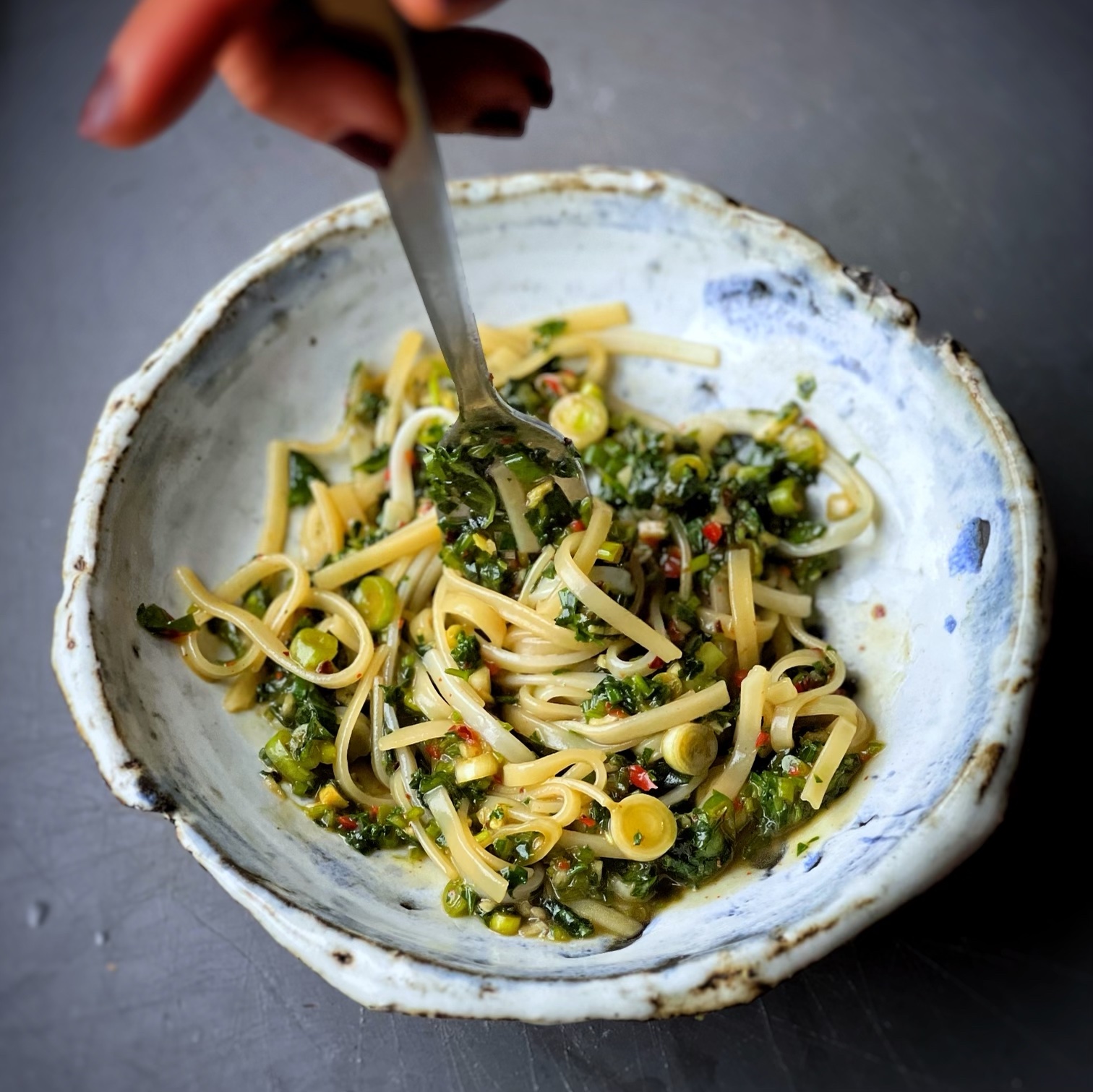
Sesame Ginger Noodles in 10 mins
Takes 10 minutes
Serves
Ingredients
- 200 g Rice noodles
- 2 tbsp seasme oil
- 1 tbsp maple syrup
- 2 tbsp Tamari
- 2 cloves garlic finely chopped
- 1 thumbsized piece ginger finely chopped
- 1 tsp chilli flakes
- pinch salt
- 100 g kale finely chopped
- handful coriander stalks finely chopped
- 1/2 red chilli
Instructions
- Cook noodles according to instructions and drain, reserving 4 tbsp of the noodle water water.
- Finely diced the ginger, garlic, scallion, coriander stalk and put into a heat proof bowl. Remove the stalk from the kale and finely dice it.
- In a small saucepan or small frying pan add the 4 tbsp of noodle water to the oil and tamari and allow to cook for a further min until its boiling hot.
- Carefully pour over the oil, tamari and pasta water onto the finely diced veg and leave to cook for 2 mins.Add in the cooked noodles and enjoy!
Super vibrant and full of flavour, these Mexican-inspired tacos are phenomenal, beautiful to look at, and equally delicious. We served them with pickled cabbage and a lacto-fermented chilli sauce to enhance the natural probiotics for better gut health. For a more authentic experience, you can make your own corn tacos – it takes longer but is fun and gives an amazing flavour.
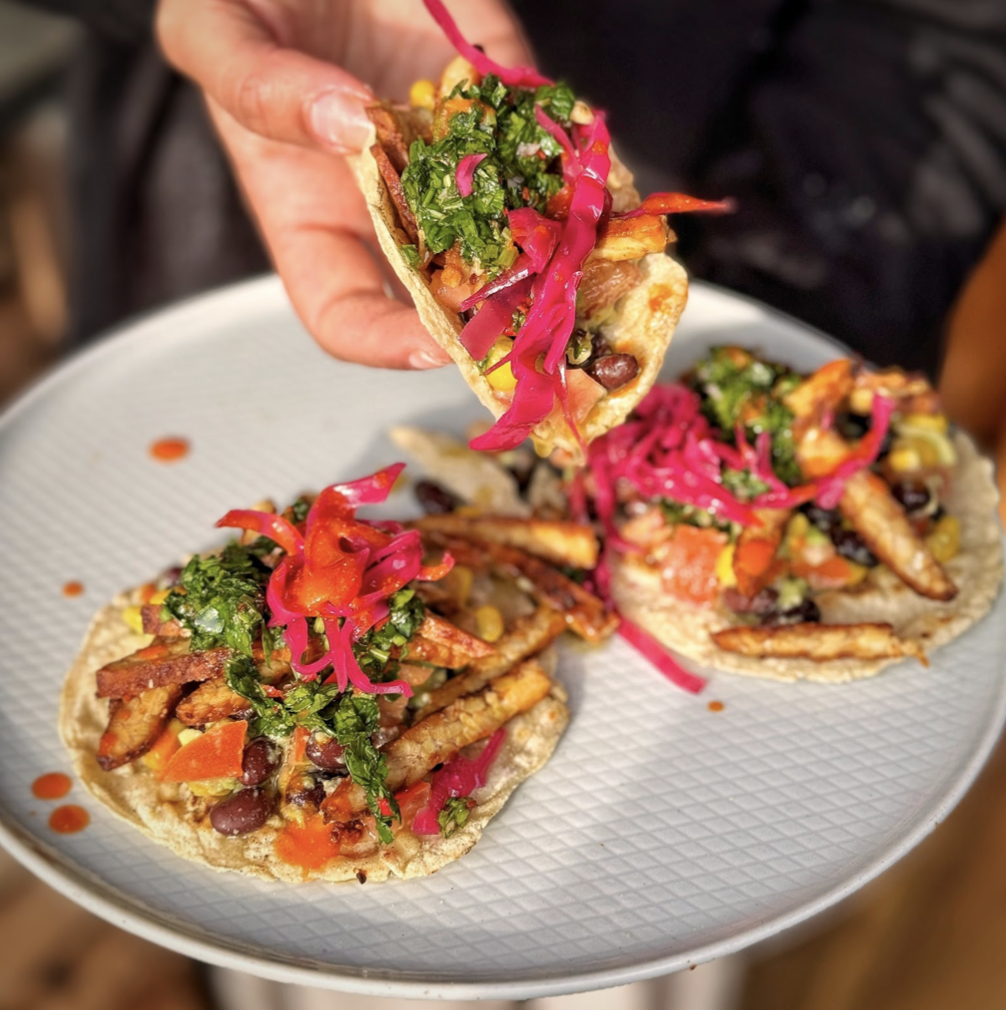
Mexican style corn tacos with chimichurri and a “meaty” black bean salsa
Takes 40 minutes
Serves 4
Ingredients
- 2 tbsp miso paste
- 1 tbsp maple syrup
- 1 tsp red wine vinegar
- 1 tsp smoked paprika
- 1/2 tsp chilli powder
- 1 tbsp oil
- 150 g tempeh
Chimchurri sauce
- 1/2 red chilli
- 1 clove garlic
- 10 g fresh coriander
- 5 g fresh flat parsley
- 40 ml red wine vinegar
- 60 ml olive oil
- generous pics of salt
Black bean salsa
- 250g tin black bean
- 150g tin sweet corn
- 2 tomatoes
- 1 acovado
- 1 lime
- pinch of salt
To serve
- 8 corn tacos
- Pickled red cabbage (sauerkraut)
- chilli sauce
Instructions
- Preheat the oven to 200°C (fan-assisted)
- Prepare the tempeh: Cut the tempeh into thin, long blocks about 1 cm thick. In a bowl, mix together the miso paste, smoked paprika, chilli powder, maple syrup, and red wine vinegar until smooth. Place the tempeh on a baking tray and brush one side with the paste, ensuring it's well covered. Spray with oil to help it caramelise. Bake for 8 minutes, then take it out, turn the tempeh, and brush the other side with the paste. Spray with oil again and bake for another 5 minutes. If there’s any remaining paste, brush it on and bake for a few more minutes until the tempeh looks dry on the outside. Leave to cool before slicing.
- Make the chimichurri: Finely chop the flat-leaf parsley, coriander, and red chilli. Peel and finely dice the garlic. Combine everything in a bowl with the salt, red wine vinegar, and olive oil. Mix well, taste, and adjust seasoning if needed. Set aside.
- Prepare the salsa: Cut the avocado, remove the skin and discard the stone. Dice the avocado and place it in a bowl with a pinch of salt and the lime juice. Mash with a fork until combined. Finely dice the tomatoes and add them to the avocado. Drain and rinse the black beans and sweetcorn, letting them dry briefly before adding them to the avocado and tomato mixture. Mix well and adjust the seasoning with more salt or lime juice to taste.
- Slice the tempeh: Once cooled, slice the baked tempeh into thin strips.
- Assemble the tacos: Add a generous spoonful of the black bean salsa to each taco, followed by about 6 slices of tempeh. Drizzle generously with the chimichurri sauce, and top with pickled cabbage and chilli sauce for extra flavour. Repeat with the remaining tacos until all fillings are used.
- Enjoy!
This is such a pretty, beautiful cake and surprisingly easy to make. The combination of chocolate and hazelnut is a delightful match. We added almond essence for a subtle flavour, but if you prefer not to include it, feel free to leave it out.
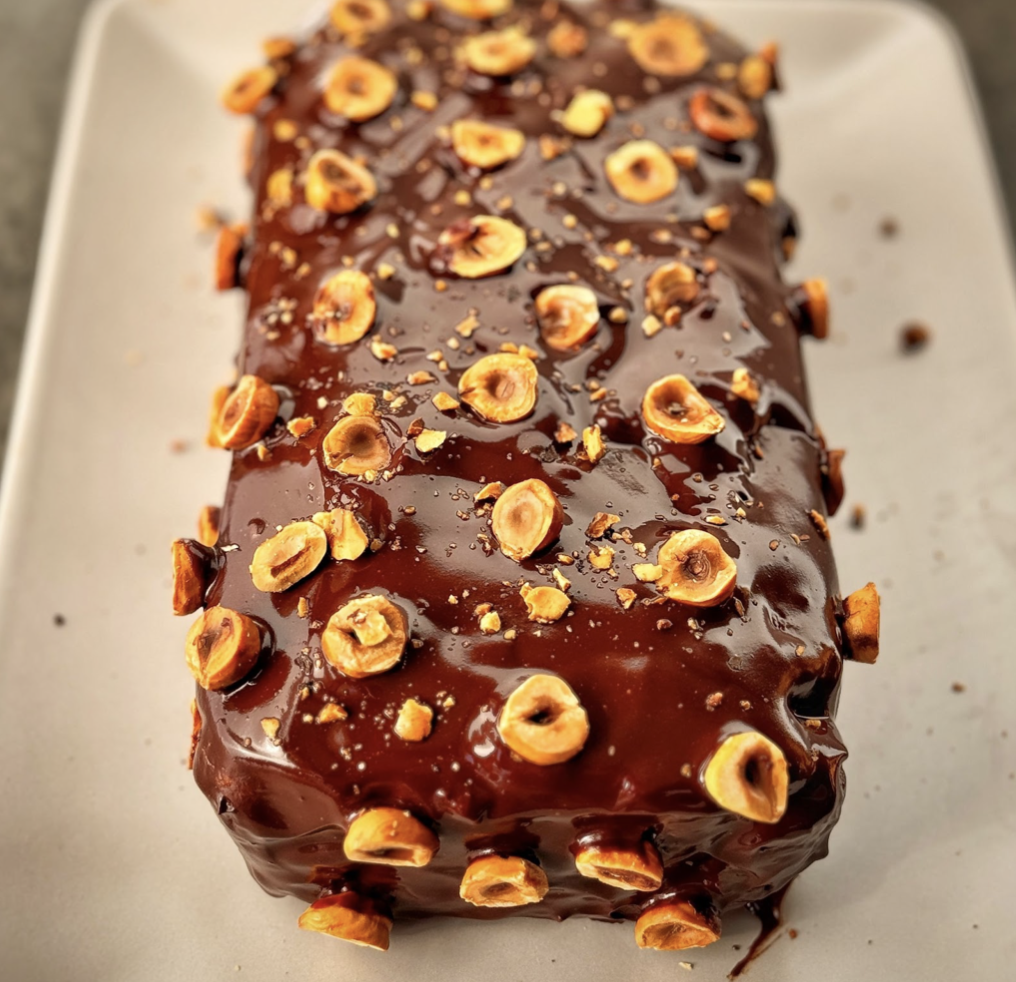
Chocolate Hazelnut loaf cake
Takes 1 hour
Serves 8
Ingredients
- 150 g self raising flour
- 100 g hazelnuts
- 150 g caster sugar
- 120 ml non dairy milk
- 120 g plant based butter
- 2 tbsp ground flax seeds
- pinch salt
- 1/2 tsp almond extract
Chocolate Coating
- 200 g dark chocolate
- 80 g plant based butter
- 50 g hazelnuts for garnish
Instructions
- Preheat the oven to 170°C (fan-assisted).
- Make the flax egg: Add the ground flax seeds to a bowl with 6 tbsp of water. Mix well and leave to sit for a few minutes to thicken. This will act as a binding agent for the cake.
- Toast the hazelnuts: Spread the 150g of hazelnuts on a baking tray and roast in the preheated oven for 15 minutes until golden. Remove from the oven, place the hazelnuts in a clean tea towel, and rub them together to remove the skins. Set aside ⅔ of the skinned hazelnuts and grind them in a food processor until they reach a coarse flour-like consistency.
- Melt the butter: In a saucepan over medium heat, melt the plant-based butter. Remove from the heat once melted.
- Combine the dry ingredients: In a large bowl, mix the self-raising flour, ground hazelnut flour, caster sugar, and a pinch of salt.
- Combine the wet ingredients: To the melted butter, add the flax egg, almond extract (if using), and non-dairy milk. Mix well until smooth.
- Mix wet and dry ingredients: Pour the wet mixture into the dry ingredients and stir until well combined.
- Prepare the tin: Line a 1lb loaf tin with baking parchment and pour the batter into the tin, smoothing the top.
- Bake: Place the tin in the preheated oven and bake for 45-50 minutes, or until a skewer inserted into the centre comes out clean. Leave the cake to cool completely in the tin.
- Prepare the chocolate coating: Cube the butter and chop the dark chocolate into small pieces. Add both to a saucepan and heat over medium heat, stirring constantly until melted and smooth.
- Coat the cake: Once the cake has cooled, carefully pour the melted chocolate mixture over the top, ensuring the cake is fully coated.
- Garnish: Cut the remaining toasted hazelnuts in half and press them gently into the chocolate coating around the cake. Sprinkle any leftover hazelnut crumbs on top for added texture.
- Serve: Slice and enjoy this beautiful chocolate hazelnut loaf!
The Happy Pear Podcast
Welcome back Dr. Alan Desmond, a Consultant Gastroenterologist, a friend, a collaborator and a true pioneer in the realm of gut health. With extensive experience and dedication to the field, he has become a respected authority on the gut microbiome. Dr. Al is on a mission to empower individuals to take control of their health by understanding the crucial role that the gut plays in our overall well-being.
Episode 142
He explains why your gut microbiome is essential to your health both physically and mentally.The discussion covers practical tips and strategies for nurturing a thriving gut microbiome. Listeners gain insights into the importance of a balanced diet that incorporates fiber-rich foods and pre & probiotics.
And what’s more, we have partnered with Dr. Al to create an exclusive online course known as “The Gut Health Revolution.” This transformative course guides participants on a journey to better gut health, offering expert insights and practical tools for a healthier, happier life. Those who join the course also get access to our membership with hours of food, movement, and mindfulness content.
Don’t miss this captivating episode, find out more about your gut and how you can take control of your well-being.
Lots of Love,
Dave & Steve
Episode Sponsors & Discount Codes:
Vivobarefoot Footwear. Vivobarefoot Footwear have given our listeners an exclusive 15% discount when you enter the code HAPPYPEAR15
Genuinely these are the only shoes you will see Dave & Steve wearing!
Produced by Sean Cahill & Sara Fawsitt
Available now from all good podcast providers:
One of the keys to gut health is to focus on diversity and to try to eat over 30 different types of plant based foods per week. This dish is packed full of plant diversity bringing a plant score of 17 meaning there are 17 different plants in this dish. Serve with your favourite grain and some pickle for a beautiful meal
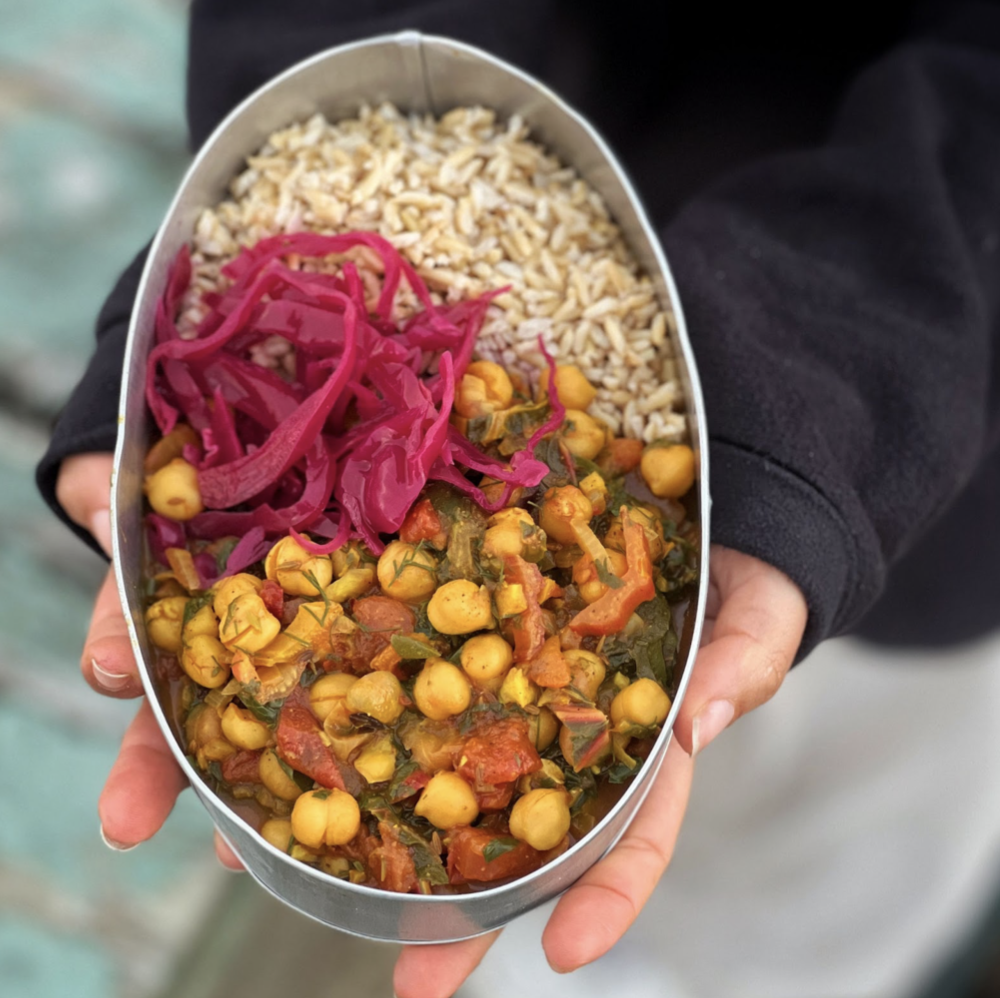
Chickpea, chard and coriander curry!
Takes 15 minutes
Serves 4
Ingredients
- 2 tins chickpeas
- 1 onion
- 1/2 thumb size piece of ginger
- 2 cloves garlic
- 1 tsp cumin seeds
- 1 tbsp ground coriander
- 1 tbsp ground turmeric
- 2 tbsp curry powder
- 1/2 tsp ground black pepper
- 1/2 red chilli
- 1 bunch rainbow chard 100g
- handfu; baby spinach
- handful fresh coriander
- handful fresh fennel fronds if available
- 1 tin chopped tomatoes
- 1 tin coconut mik
- 2 tbsp tamari
- pinch of salt
Instructions
- Peel and finely dice the onion, ginger and garlic.Finely slice the stalks of the rainbow chard and roughly chop the leaves.Finely dice the coriander and the fennel fronds.
- Heat a wide bottomed pan on high heat, once hot add 1 tsp of oil and the onion and ginger, fry for 3-4 mins until the onions start to brown.
- Next turn the heat down to medium and add the cumin seeds and the rest of the spices followed by the garlic and fry for another 2 mins mixing regularly.
- Drain and rinse the chickpeas and add to the pan along with the beautiful coloured chard stalks, the chopped tomatoes, coconut milk, and tamari and bring to a boil stirring regularly.
- Reduce to a simmer and season with salt and pepper and juice of the lime. Finish the dish with the fresh coriander and fennel fronds.
- Serve with some pickled cabbage or red onion and your favourite grain for a delicious nourishing meal!
The Happy Pear Podcast
In this exciting episode, we sit down with Professor Tim Spector, a distinguished researcher and the director of the Twins UK study. He’s also a Scientific co-founder at ZOE and a leading figure in the world of genetics and epidemiology. Tim, who initially trained in rheumatology and epidemiology, has authored the enlightening book, “Food for Life,” which delves into the intricate relationship between nutrition and health.
Episode 141
Join us as we embark on a fascinating journey through the realms of the microbiome, calory counting, supplements, and the personalised approach to diet. Tim unveils the truth about supplements and why they might not be the magic pill/powder they’re often implied. We explore how every individual is unique and how that uniqueness demands a slightly different dietary approach. Tim’s groundbreaking platform, ZOE.com, is at the forefront of this revolution, helping us tailor our nutrition to our specific needs.
In this captivating conversation, we also discuss the benefits of a predominantly whole-food plant-based diet. Discover why this approach could be the key to a healthier and happier life. We unravel the mysteries of our gut, the role of diversity in our diet, and how small changes can lead to big results in our overall well-being.
So, whether you’re a health enthusiast or just curious about how you can better fuel your body, this episode is packed with insights and practical tips that can help you make informed choices about your diet and nutrition.
Lots of Love,
Dave & Steve
Episode Sponsors & Discount Codes:
Instant Brands: Instant Brands new Instant Pot Duo Plus Whisper Quiet is out! And our listeners are currently getting £30 off! Simply follow this link to avail of the offer and select ‘Apply £30 voucher’:
Vivobarefoot Footwear. Vivobarefoot Footwear have given our listeners an exclusive 15% discount when you enter the code HAPPYPEAR15
Genuinely these are the only shoes you will see Dave & Steve wearing!
Produced by Sean Cahill & Sara Fawsitt
Available now from all good podcast providers:
We highly recommend giving these a try—they’re truly worth it! If you can’t find canned pumpkin, simply bake your own pumpkin, butternut squash, or sweet potato at 200ºC/400ºF/gas mark 6 for about 30 minutes. Remove the flesh from the skin and use that in place of canned pumpkin.
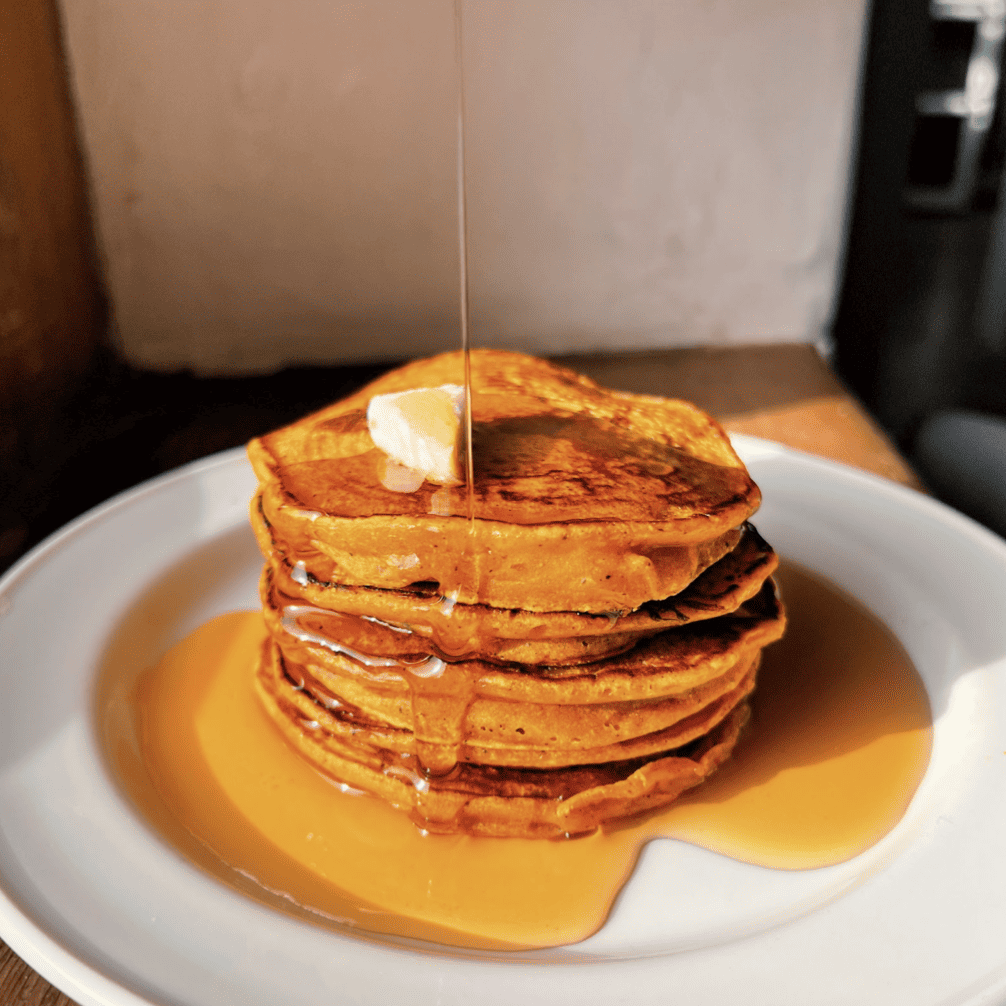
Pumpkin Spiced Latte Pancakes
Takes
Serves 3
Ingredients
- 175 g self raising flour
- 1/2 tsp salt
- 3 tbsp pumpkin puree
- 1 tbsp vanilla extract
- 2 tbsp maple syrup (or liquid sweetener)
- 1 tsp ground cinnamon
- 1 tsp ground ginger
- 1/2 tsp ground cardamom
- 1/2 tsp allspice
- 275 ml rice milk
- 1 tbsp finely ground coffee (optional but recommended)
Instructions
- Put all your ingredients in a blender and blend until smooth.
- Place a non-stick frying pan on high heat. Spray a small amount of oil onto the pan to prevent sticking. Once the oil heats up, reduce the heat to medium.
- Pour enough batter to lightly cover the surface of your pan (approximately 5 tablespoons for a large pancake or 2-3 tablespoons for smaller ones). Move the pan around to spread the batter evenly and make the pancake thin.
- Once bubbles start to form around the edges and middle, it’s time to flip the pancake over. Cook on the other side until browned. It’s done when both sides are golden.
- Repeat the process until all your pancakes are cooked. Once done, serve and enjoy!
Serving Suggestions:
- Maple syrup, banana, fresh berries, almond butter, coconut yogurt, fresh mango, passion fruit, cacao nibs, bee pollen, or goji berries.
The focus of this dish is to create a stew with a variety of plants to promote gut health while staying true to its traditional roots. We’ve included over 15 different plants! White miso, though not traditionally used, mimics parmesan rind, adding a deep umami note. This hearty, delicious stew is best served with toasted sourdough.

Ribollita tuscan white bean stew
Takes 30 minutes
Serves 4
Ingredients
- 1 tbsp olive oil
- 2 shallots / 1 medium onion
- 1 carrot
- 3 celery stalks
- 1 bulb fennel
- 3 cloves garlic
- 4 medium sized tomatoes / 1 can of chopped tomatoes (400g)
- 100 g dinosaur kaale
- 700 ml veggie stock
- 400 g 1 tin of cannellini beans
- 400 g 1 tin of butter beans
- 1 tbsp white miso instead of parmesan rind
- 1 tsp salt
- 1/2 tsp ground back pepper
To serve
- 5 g Flat Parsley
- 3 sprigs of thyme
- Some bread to serve
Instructions
- Peel and finely dice the shallots/onion and garlic. Dice the carrot and celery into ½ cm – 1 cm pieces. Finely dice the fennel. Roughly chop the tomatoes.
- Remove the kale from the centre stem and roughly chop.
- Heat a large saucepan over high heat and add olive oil. Once hot, add the diced shallots/onion and fry for 3-4 minutes, stirring regularly. Add the carrot, celery, fennel, and garlic, along with ½ tsp of salt. Cook for 1 minute, stirring occasionally.
- Add 50 ml of the veggie stock, cover with a lid, and allow the vegetables to steam for 5 minutes.
- Remove the lid, give the mixture a good stir, then add the drained and rinsed beans, chopped tomatoes, kale, remaining veggie stock, miso, ½ tsp black pepper, and 1 tsp salt. Take the thyme leaves from the sprigs and add them to the pot. Bring to a boil, then reduce the heat to a simmer.
- Roughly chop the flat parsley and add it to the pot just before serving.
- Taste and adjust the seasoning to your liking.
- Serve with toasted sourdough for a hearty, delicious meal!
We’ve played around with making our own plant based butter many times but never quite got it right, using shea butter, cacao butter but it never just seemed to be right. Recently I saw a video online and thought I’m going to try this. Miso in butter might sound crazy but it really works. Lecithin is an emulsifier that binds the milk and the coconut oil together to form that wonderful creamy taste. It melts like butter and tastes like butter!
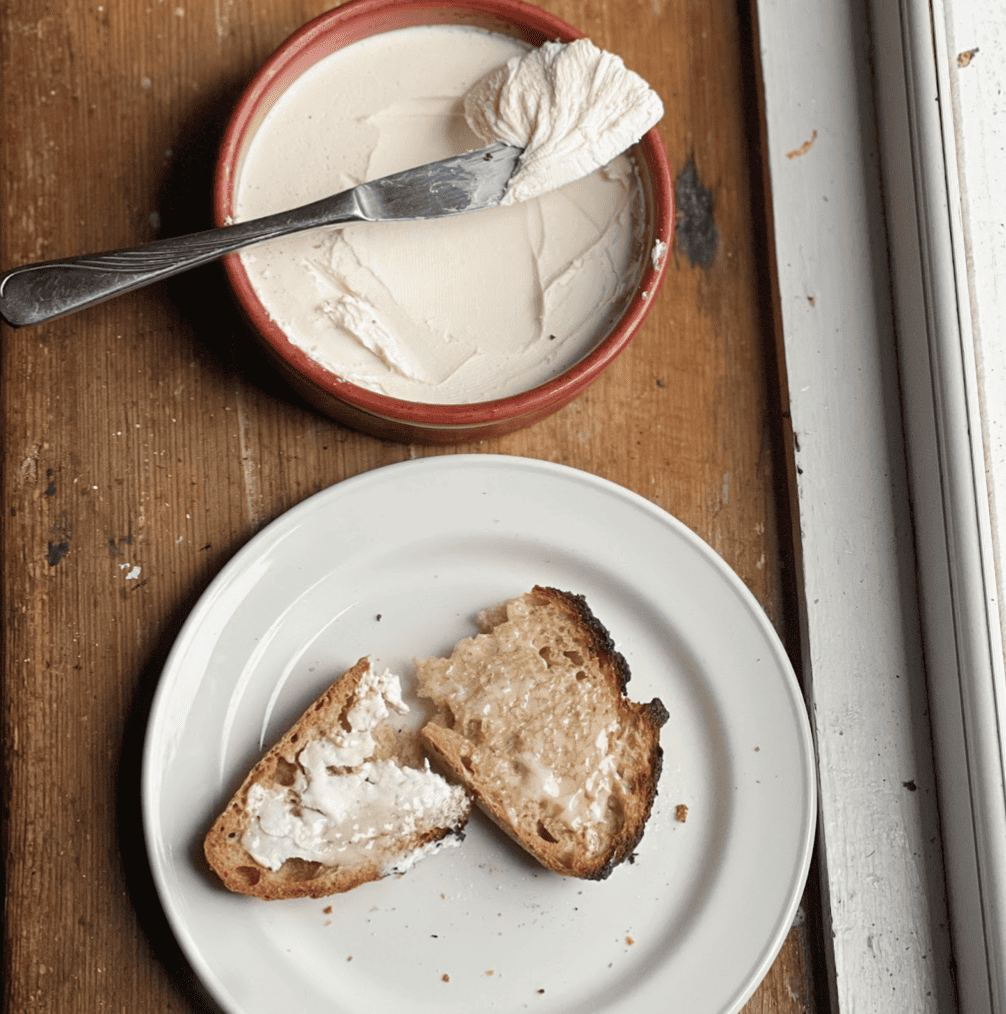
Vegan Butter
Takes 10 minutes
Serves 400
Ingredients
- 150 ml plant milk Happy Pear Oat Milk
- 200 ml coconut oil (odourless so there is no coconut flavour)
- 1 tbsp white miso
- 2 tbsp lecithin (we used soy)
- 1 juice lemon
- 1/2 tsp salt
Instructions
- Melt the Coconut Oil: Place the coconut oil in a saucepan. Heat the saucepan on high until the coconut oil is fully melted.
- Blend the Ingredients: Into a blender, add the melted coconut oil, 150ml plant milk, 1 tbsp white miso paste, 2 tbsp lecithin, juice of 1 lemon, and 3/4 tsp salt. Blend the mixture until it becomes super smooth, ensuring the lecithin is fully incorporated.
- Pour and Set: Once the mixture is blended and smooth, pour it into a large bowl, or divide it into a few smaller butter bowls. Place the mixture into the refrigerator and leave to set overnight.
- Enjoy Your Vegan Butter: After the butter has set overnight, remove it from the fridge. The butter is now ready to use. Spread it on your favourite dishes and enjoy the buttery taste!
Corn is a staple in Mexico, often referred to as “Elote.” In this recipe, we roast the corn until golden and slightly crispy to bring out a charred note. This soup is super easy to make and looks like liquid sunshine! The key is serving it with delicious toppings that make it exceptional.

Mexican Street Corn Soup
Takes 45 minutes
Serves 6
Ingredients
- 1 tbsp oil
- 600 g sweet corn (from tin)
- 1 onion
- 350 g potato
- 2 cloves garlic
- 900 ml veg stock
- 1/2 lime juice
- 1 green chilli
- 1 tsp smoked paprika
- 1 tbsp ground cumin
- 100 g cashew nuts
- 600 ml water
- salt and pepper to taste
Garnish
- Coconut or soy yogurt (natural flavour)
- 1 red chilli diced
- Small handful of fresh coriander
- Lime wedges
- Pickled red onion
- Toasted bread
Instructions
- Preheat the oven to 250°C.
- Drain the sweet corn and allow it to dry. Divide the corn between two baking trays and bake for 15-20 minutes until lightly golden. Set aside 50g (approximately 4 tbsp) for garnish.
- Peel and finely dice the onion and garlic. Finely chop the chilli and cut the potato into small pieces. Boil the kettle and, once boiled, cover the cashew nuts in boiling water and leave to soak for 10 minutes.
- Heat a large saucepan over high heat and add the oil. Once hot, add the onion and fry for 4-5 minutes until it begins to turn golden. Add the garlic, chilli, potato, 2 tbsp of vegetable stock, and a pinch of salt. Mix well, cover with a lid, and leave to sweat for 5 minutes.
- Remove the lid and give the mixture a good stir.
- Drain and rinse the cashew nuts, then add them to the saucepan along with the spices. Mix well and cook for 2-3 minutes. Add the vegetable stock, baked corn, and water, then bring to a boil. Reduce to a simmer and cook for 10 minutes, stirring occasionally.
- Using a stick blender or immersion blender, blend until smooth. If it’s too thick, add a little more water until you achieve the desired consistency. Taste and adjust the seasoning with salt, pepper, and the lime juice.
- Once you’re happy with the seasoning, divide the soup between 4 bowls. Garnish with the charred corn, pickled red onion, yogurt, chilli slices, and lime wedges. Serve with toasted bread and enjoy!
The Happy Pear Podcast
Join us for a delectable journey into the world of chocolate as we delve deep into the fascinating nuances of taste, flavor, and the art of chocolate making with our special guest, Spencer Hyman. As the co-founder of Cocoa Runners.com, Spencer is a true chocolate connoisseur and an expert in the field.
Episode 140
Spencer Hyman is a renowned super taster, co-founder of Cocoa Runners.com, and a passionate advocate for high-quality, ethically sourced chocolate. With a background in media and technology, Spencer embarked on an unexpected journey into the world of fine chocolate, driven by a deep curiosity and an unwavering commitment to explore the world of flavours.
An episode to sit back with a rich bar of chocolate and lean into the art of what it is to taste!
Lots of Love,
Dave & Steve
Episode Sponsors & Discount Codes:
Instant Brands: Instant Brands new Instant Pot Duo Plus Whisper Quiet is out! And our listeners are currently getting £30 off! Simply follow this link to avail of the offer and select ‘Apply £30 voucher’:
Vivobarefoot Footwear. Vivobarefoot Footwear have given our listeners an exclusive 15% discount when you enter the code HAPPYPEAR15
Genuinely these are the only shoes you will see Dave & Steve wearing!
Produced by Sean Cahill & Sara Fawsitt
Available now from all good podcast providers:
A tostada is where a tortilla is toasted to form the base of a dish and similar fillings can be used to a burrito or taco. Here we make 3 components to make a truly delicious meal, we make refried beans, a charred pineapple salsa and some smoked oyster mushrooms. The tortillas in some cases are deep fried however here we toast them in the oven for a lower fat version.

Epic Tostadas with smoky mushrooms and charred pineapple salsa
Takes 25 minutes
Serves 4
Ingredients
- 1 pack tortilla wraps
Refried beans
- 400 g kidney beans
- 1/2 red onion
- 2 cloves garlic
- 1 tsp ground cumin
- 1/2 tsp cumin seeds
- 1 tsp ground black pepper
- 1 tsp ground coriander
- 1/2 tsp ground chilli powder
- 150 ml water
- 1 lime juice
- 2 tbsp Tamari
- 1 avocado
Charred Pineapple Salsa
- 1 pineapple
- 12 cherry tomatoes
- 1/2 red onion
- 10 g fresh coriander
- 1 green chilli
- 1/2 tsp salt
Smokey mushrooms
- 250 g Oyster Mushrooms
- 3 tbsp tamari
- 1 tsp smoked paprika
To serve
- Avocado slices, Coconut yogurt, Pickled red onions, Coriander
Instructions
- Preheat the oven to 180 degrees. Add the tortillas to the oven so they are well spread out and bake for approx 5 mins each side until they go lightly golden and go crispy. Take out and set aside.
- For the refried beans, peel and dice the red onion and garlic. Drain and rinse the beans, heat a frying pan over a high heat and add 1 tsp of oil along with the diced onion and fry for 4 mins until it starts to golden around the edges, add in the garlic and the spices and cook for 1 minute stirring constantly. Add in 50ml of water and the drained beans and mix well and cook for 2-3 mins. Use the back of a wooden spoon to start to mash the beans. Add in the tamari and juice of 1 lime.. Mash the beans until it forms a paste-like texture. Add more water if it looks dry. You want the texture to be spreadable but not too thin and not too thick. Season with salt and black pepper to taste, It should have a strong base flavour.
- For the pineapple salsa, heat a griddle pan or clean frying pan on high heat. Peel and core the pineapple and cut the flesh into long fingers. Add them to the hot griddle pan or frying pan ensuring each piece is touching the bottom of the pan. Fry until it starts to char and turn and repeat on the other side. Remove from the heat and cut into small pieces approx 1 cm cubed. If there is any pineapple juice or residue left in the pan add 1-2 tbsp of water to deglaze the pan and cook off this residue until it reaches a light sauce like consistency and pour into a glass. Peel and finely dice the ½ red onion, finely dice the coriander, cut the cherry tomatoes into quarters and add to the pineapple and mix well. Season with a generous pinch of salt and pour over any of the pineapple deglaze juice (if you have any) and set aside.
- For the mushrooms; shred the mushrooms into long strips. Heat a clean frying pan on high heat and once hot add a single layer of mushrooms and ½ tsp of smoked paprika and mix well. Fry on hot heat for 1 minute and then use a clean saucepan that fits inside the frying pan to compress the mushrooms. This will encourage more charring and a more “meaty” texture as more of the water inside the mushrooms is forced to evaporate. Cook for 2 mins with the saucepan on top, then remove and turn the mushrooms and repeat for another 2 mins. Remove the saucepan and add in 1.5 tbsp of tamari and mix well. Taste the mushrooms they should taste like flavour bombs! Set these mushrooms aside and repeat with the remaining mushrooms if there are any left.
- Cut the avocado in half, remove the stone and the flesh and cut the flesh into thin strips.
- To bring together; Take the crispy tortillas or a tostada and add a generous layer of refried beans on the base, some avocado slices on top, followed by a good dollop of the pineapple salsa and top it off with some of the smoky mushrooms on top. Finish with a splash of some coconut yogurt and pickled red onions on top for a beautiful meal!
Marry Me Chickpeas
Legend has it that this creamy Italian dish is so irresistibly tasty, it makes you want to tie the knot. We’re recreating it with chickpeas and adding the goodness of our farm-fresh seasonal purple broccoli, leeks, and kale. It’s a quick, hearty meal, you can use plant based cream or natural yoghurt for a lower fat version.
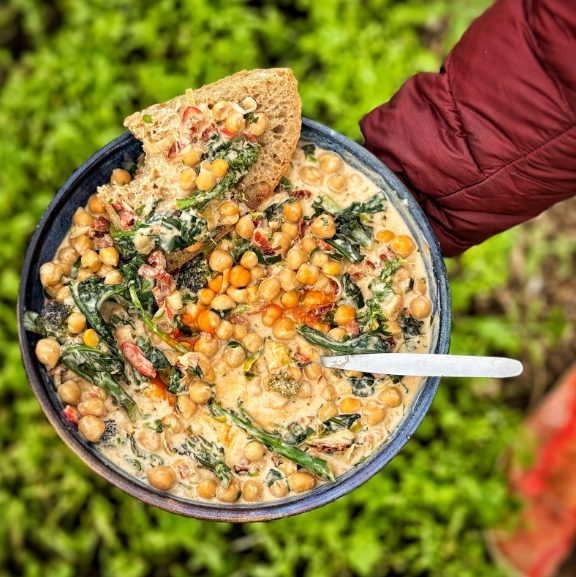
Marry Me Chickpeas
Takes 30 minutes
Serves 4
Ingredients
- 2 tbsp olive oil
- 3 cloves garlic
- 1 handful sun-dried tomatoes (not in oil)
- 800 g tinned Chickpeas
- 3 tbsp dried oregano
- 1 red chili (optional)
- 1 pinch salt (to taste)
- 50 g kale
- 50 g seasonal greens (we used purple broccoli)
- 1 handful herbs to serve (we used flat parsley)
- 350 ml vegan cream or natural yoghurt
- 1 half Juice of half a lemon
- 4 slices sourdough to serve
Instructions
Instructions:
- Peel and finely dice the garlic. Roughly chop the sun-dried tomatoes.
- Roughly chop the kale and seasonal greens. Drain and rinse the chickpeas. Finely dice the chilli.
- Heat a non-stick pan on high heat. Once hot, add 2 tbsp of oil along with the garlic, sun-dried tomatoes and cook for 1-2 minutes, stirring occasionally.
- Add the drained chickpeas, chilli and dried oregano along with a generous pinch of salt and cook for 2-3 minutes, stirring occasionally.
- Add the kale and seasoned greens along with 4 tbsp of water. Put the lid on the pan and leave to steam for 4 minutes.
- Remove the lid and add a pinch of salt along with the cream / yoghurt and stir through. Add the juice of half a lemon to taste. If using yoghurt, you probably won't need lemon as yoghurt has its own acidity but if using cream, add the lemon juice to cut through the richness.
- Add some herbs of choice, traditionally basil is used but use what you have and like.
- Season to your taste by adding more salt, ground black pepper and lemon juice.
- Toast the sourdough and serve together for a lovely comforting, hearty meal!
This is phenomenally tasty and so worth the effort!
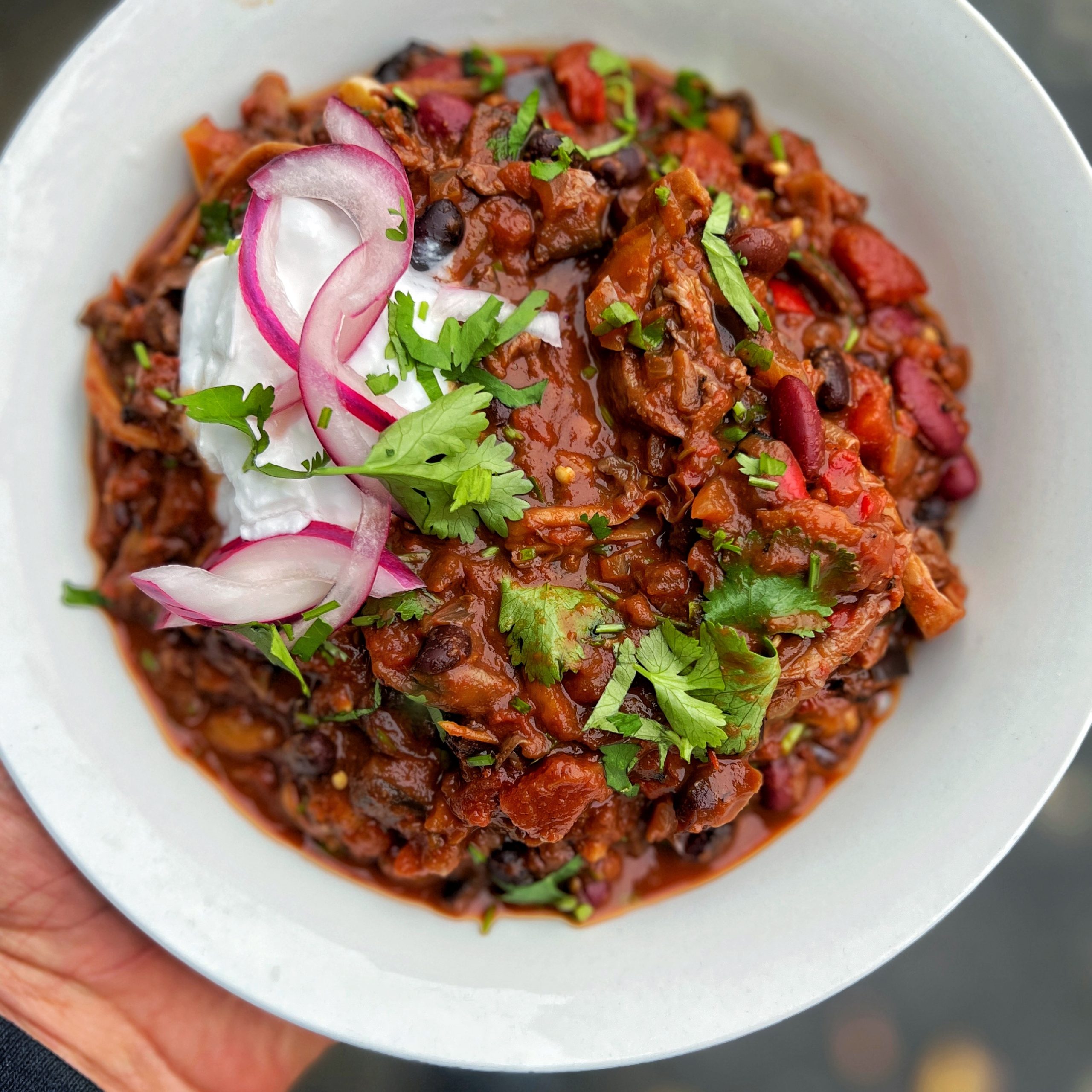
Chocolate mole style chilli
Takes
Serves
Ingredients
Miso Mushroom gravy;
- 150 g oyster mushrooms or mushrooms of choice
- 2 Tbsp oil
- 1 medium onion
- 400 ml veg stock
- 150 red wine
- 2 Tbsp miso
- 1 tsp garlic powder
- Pinch of black pepper
- 2 Tbsp of cornstarch or regular flour
Chocolate chilli
- 1 medium onions
- 3 cloves garlic
- 1 tbsp cumin seeds
- 2 tbsp ground cumin
- 1 tbsp ground coriander
- 1 cinnamon stick
- 1 tsp smoked paprika
- ½ tsp black pepper
- 2 tbsp chopped tomatoes
- 50 g of dark chocolate approx 70% cocoa solids
Veg and beans
- 2 aubergine
- 1 red pepper
- 1 yellow pepper
- Fresh coriander to serve
- 1 tin black beans 250g net weight
- 1 tin kidney beans 250g net weight
Pickled red onions
- 1 red onion
- 50 ml vinegar
- 50 ml water
- Pinch salt
To serve:
- Fresh coriander 20g
- 1 tub of soy yogurt
Instructions
- Preheat the oven to 200 degrees c
- First chop the peppers and aubergine into bite size pieces and divide between 2 baking trays and coat with 1 tbsp of oil and a generous pinch of salt. Mix well and bake for 20-25 mins.
- For the pickled red onion, peel and finely slice the red onion into thin long stips. Add to a glass along with the salt, maple syrup, water and vinegar and mix well and leave to sit and pickle.
- While they are baking let’s make the mushroom gravy.
- Roughly chop the onion and cut the mushrooms into strips.
- Add 1 tbsp oil to a large frying pan on high heat, add the mushrooms, stir then spread into a single layer in the pan and flatten with the base of another clean pan or pot for a few minutes then remove and turn the mushrooms and repeat until the mushrooms get a nice caramelised brown colour add the 1 tbsp of tamari and pinch of black pepper and mix well ensuring to incorporate any bits stuck to the bottom of the pan. Repeat if you have any more mushrooms left.
- Remove mushrooms from the pan and set aside, now to get all the tasty brown mushroom bits left in the pan, deglaze the pan by adding the red wine to the pan, on a high heat, stir with a wooden spoon until the pieces are all mixed and the red wine is reduced. Pour off this sauce.
- Add 1 tbsp of oil to the same pan (which should have nothing in it) on a high heat. Once hot add the onion, reduce the heat to medium and cook for 5 minutes, stirring regularly, until they start to turn golden. Deglaze the pan with the stock, and then add the mushroom stock (from deglazing), miso, garlic powder, and black pepper. Bring to the boil, then reduce the heat to a gentle simmer whisk to ensure the miso has mixed through the sauce fully. Simmer for 3-4 minutes until it thickens, whisking occasionally. Now add your meaty mushrooms to the gravy. Taste and adjust the seasoning to your liking. Set this aside while we make our chocolate chilli.
- For the chocolate chilli
- Peel and finely dice the onions and garlic.
- Heat a large pot on high heat and once hot add in 1 tbsp of oil along with the onions and fry for 3-4 mins until they start to colour. Add in the chopped garlic and cumin seeds and cook for a further 2 mins. Add in the rest of the spices
When we were kids this was one of our Dad’s big dishes and the whole house would smell of wine which we thought was so strange and foreign! Originally a French beef stew braised in red wine garnished with shallots here we use a selection of mushrooms instead which really give a wonderful texture and depth of flavour.

Mushroom Bourguignon with Pumpkin
Takes 45 minutes
Serves 4
Ingredients
- 4 shallots
- 3 cloves garlic
- 400 g mixed mushrooms (we used portobello, chestnuts and oyster mushrooms)
- 3 celery sticks
- 1 carrot
- 10 g fresh thyme
- 2 bay leaves
- 500 ml red wine
- 2 tomatoes
- 400 g chopped tomatoes
- 2 tbsp tamari
- 1 tsp smoked paprika
- 500 g pumpkin
- 2 tbsp maple syrup
- 30 ml water
- 750 g potatoes
- 50 ml oat milk
- 2 tbsp oil
- 1 tsp salt
- 1/2 tsp pepper
Instructions
- Preheat the oven to 200 degrees celsius.
- Rip up the oyster mushrooms and slice the portabello mushrooms and quarter the chestnut mushrooms, we want a variety of texture here. Add them to a bowl along with the tamari, smoked paprika, 1 tbsp of oil, pinch of salt and a pinch of black pepper and mix well. Add to a baking tray and bake for 15 mins. Remove and leave to cool.
- While the mushrooms are in the oven peel and finely dice the shallots and garlic. Dice the carrot and celery into 1 cm cubes. Dice the tomato into small pieces.
- Carefully cut the pumpkin leaving the skin on ensuring to remove the seeds and innards. Add to a baking tray along with a pinch of salt and drizzle of oil. Bake for 20 minutes, until soft.
- Fill and boil the kettle and cut the potatoes into small pieces. Add to a large saucepan along with a generous pinch of salt. Cover with just boiled water and bring to a boil and reduce to a simmer until the potatoes are soft and well cooked. Drain them and mash along with 1 tsp of salt, pinch of black pepper, 50ml oat milk and 2 tbsp of oil until lovely and smooth and creamy.
- Heat a large casserole dish or saucepan with a lid on high heat. Once hot add 1 tbsp of oil along with the shallots and fry for 3-4 mins, add the garlic, carrot and celery along with a pinch of salt and 2 sprigs of thyme and the bay leaves. Put the lid on a leave to cook for 3-4 mins.
- Remove the lid and add in the red wine and deglaze the pan incorporating and the stuck bits to the sauce, stirring well.
- Add in the chopped tomatoes, mushrooms, baked pumpkin, maple syrup, 30ml of water. Bring to a boil and reduce to a simmer.
- Taste and adjust the seasoning to your liking. Serve with a big dollop of mash and some bourguignon on top.
The Happy Pear Podcast
Our first LIVE podcast! After all the global hype our seaside town Greystones, has been getting post the introduction of the mobile phone ban in primary schools, we decided to speak to the people behind it and learn more.
Episode 139
Meet Rachel Harper, St. Patrick’s National School Principle, Andrea Splendori, Podcast Host and front runner behind the initiative, and finally Joshua Barrington, Temple Carrig’s School Chaplain.
This is a fascinating conversation that goes far deeper than what you expect, from how and why the initiative ‘It Takes A Village’ started, to school kids being ‘catfished’, porn and teenages, bullying, anxiety, addiction, FOMO and a reflection on us as adults and our own screen usage.
There are so many practical takeaways from this episode, Greystones is just an example, the Initiative plans to take the framework global so that every town can learn the steps to support their youth and older in this technology fast paced and growing world.
Technology is amazing, when used appropriately. We need to learn how to respect it, and be tech literate in order to protect ourselves and our precious youth.
Lots of Love,
Dave & Steve
Episode Sponsors & Discount Codes:
Instant Brands: Instant Brands new Instant Pot Duo Plus Whisper Quiet is out! And our listeners are currently getting £30 off! Simply follow this link to avail of the offer and select ‘Apply £30 voucher’:
Produced by Sean Cahill & Sara Fawsitt
Available now from all good podcast providers:
This is a super tasty and really easy wholesome one pot red lentil dahl. It is as tasty as it is wholesome. I often make this dish as I’m making my kids lunch boxes in the morning and set it to come on at 5pm so that when I come home at 6pm dinner is ready! That is the joy of an instant pot!!! If you’re interested in getting one, click here for £30 off – both uk and Ireland!

Spinach and Chickpea Dahl
Takes
Serves 4
Ingredients
- 400 g red lentils
- 2 carrots
- 1 onion
- 3 cloves garlic
- 1 courgette
- 1 tsp salt
- 1.25 litre veg stock
- 400 g chickpeas
- 2 tbsp tamari
- 6 cherry tomatoes
- 2 tbsp curry powder
- 100 g baby spinach
- salt and pepper
Garnish choices
- kimchi, sauerkraut, chopped coriander, flaked almonds, avocado
Instructions
- Peel and finely chop the onion and garlic cloves. Finely chop the carrot and the courgette into rounds, half the cherry tomatoes and drain and rinse the tin of chickpeas.
- Add a few sprays of oil to the inner pot. Set your Instant pot to saute for 2 minutes. Add all the prepped veg to the pot along with a good pinch of salt and cook until the sauteing function is complete (we cook it while it is preheating also). Ensure to stir regularly during this so that your veg doesn’t stick to the bottom.
- Once the sauteing cycle is complete, add all the remaining ingredients less the baby spinach (and salt and pepper to taste). Ensure you have the steam release set to sealed.
- Select pressure cook for 10 minutes at high heat. Seal the lid and press start. Go enjoy doing something else for the 20 minutes or so while your instant pot is cooking you dinner!!Once it is finished cooking, open the steam release and allow all the pressure to leave fully.
- Open the lid and stir in the baby spinach. Taste and season with salt and pepper to your taste.Serve and garnish with any of the garnishes that you have or take your fancy!!
This is a super easy and decadent tart. As kids, we always thought these cakes looked so posh! As we’ve grown older, we’ve realised how incredibly delicious and simple they are to make!

Easy 5 ingredient Chocolate Ganache Tart
Takes 30 minutes
Serves 12
Ingredients
- 320 g Short crust pastry
- 350 g dark chocolate
- 250 g plant based cream (we used Flora plant based cream)
- 4 tbsp plant-based butter
- sea salt flakes (for garnish)
Instructions
- Preheat and Prepare:Preheat the oven to 200°C. If using frozen pastry, defrost it first according to package instructions. Roll out the pastry so it fits a 9-inch (23 cm) tart pan, making sure it comes up the sides and slightly over the top to prevent sinking during baking.
- Blind Bake the Pastry:Cover the pastry with baking parchment and fill it with dried beans. Blind bake for 10 minutes. Remove the paper and beans, then bake for a further 8 minutes, or until the pastry is lightly golden and firm. Remove from the oven and let it cool completely.
- Make the Chocolate Ganache:While the pastry cools, break the chocolate into small, chip-sized pieces and place in a heatproof bowl. In a saucepan, bring the plant-based cream and butter to a boil. Once boiling, pour the hot mixture over the chocolate and whisk until smooth and silky.
- Assemble the Tart:Pour the chocolate ganache into the cooled pastry shell and sprinkle with sea salt flakes. Transfer the tart to the fridge and let it cool.
- Slice and Serve:For smooth, clean slices, heat your knife by dipping it in hot water for about 20 seconds, then dry the blade. Clean the knife between each slice for a flawless finish.Garnish with chopped pistachios, freeze-dried raspberries, or grated chocolate for an extra touch of elegance.
Making your own chilli sauce is super easy and a really great way to use and preserve all your chillies. It makes a great gift and a wonderful condiment to add a kick to any dishes. We used thai chillies, habaneros and green chillies. We’re not so good with really spicy dishes so we roasted some carrots and blended them through to reduce the spiciness by bringing some sweetness and starch. You don’t have to do this but it’s a handy thing to do to reduce the heat if you’re like us!

Lacto Chilli Sauce
Takes 10 days
Serves 1
Ingredients
Fermented Chillies
- 500 g fresh assorted chillies
- 4 cloves garlic
- small thumb size ginger
- water
Hot sauce
- 320 ml chilli brine
- 7 tbsp maple syrup
- 7 tbsp apple cider vinegar
- 1 tsp salt
- 1/2 tsp ground pepper
- 75 g roasted carrot
- 1 tbsp tamari
Instructions
- Cut the green part off the chillis and cut them open leaving the seeds in place. Peel the garlic cloves.
- Weigh the combined weight of the chillis, garlic and ginger and multiply by 2% or .02, for example the combined weight is 560g x 2% = 11.2 so you will need to add 11.2 g to the chillies for lactic acid fermentation.
- Add them to a clean jar along with 11.2g of salt and submerge with water. Weigh down the chillies with a clean lid to ensure they stay underneath the water. Label and leave to ferment for 7-10 days in a warm environment away from direct sunlight.
- You will need to burb the chillies everyday which simply means you have to open the lid and let the natural occurring carbonation release so that it doesn't build up too much and then close the lid. Once fermentation is complete the water will have gone cloudy and it should have lots of bubbles.
- If using a carrot to dilute the heat, finely slice it, roast the carrot at 200 degrees for 45 mins until soft and melt in your mouth texture. Keep liquid and drain the fermented chilies and the garlic and ginger.
- Blend till super smooth alongside the veigar, syrup, tamari, salt and pepper. Finally pass through a sieve.
- Taste and adjust the final seasoning to your liking by adding more vinegar, syrup and salt.
- Using a funnel pour into your bottles This will last for many months in your fridge and makes a great present. Enjoy!
Start your day on the healthiest foot possible! Introducing our oat goats in the Instant Pot Pro Plus for such a delicious breakfast that couldn’t be better for you! We served ours with local fruit and a bit of yoghurt and granola!
We swear by our instant pots, so we approached them to be ambassadors!! If you’re interested in getting one, click here for £30 off – both uk and Ireland!
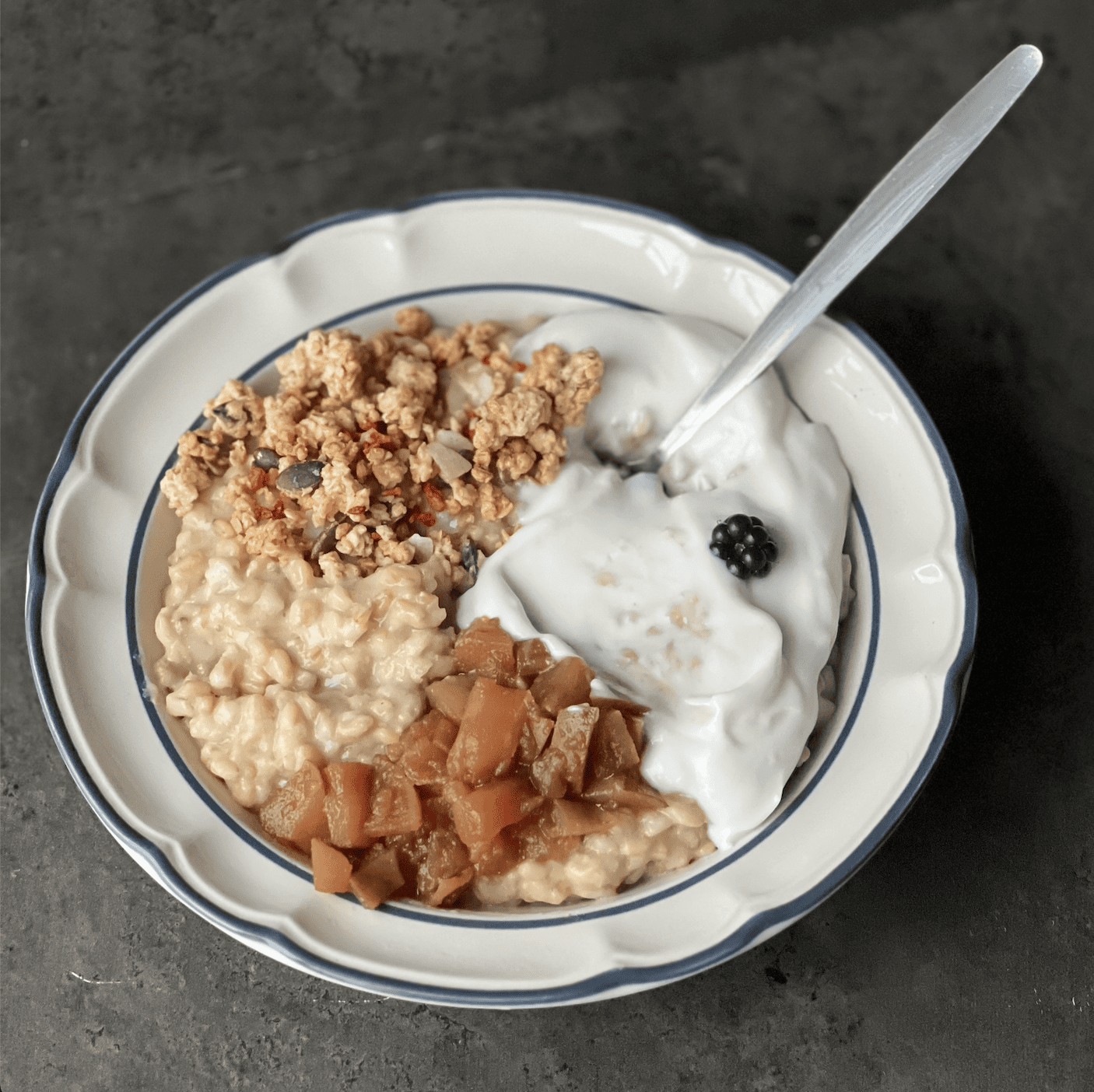
Oat Groats
Takes
Serves 4
Ingredients
- 350 g oat groats
- 500 ml oat milk
- pinch salt
- 1/2 tsp vanilla essence
- 2 apples stewed with 10 blackberries
- 75 ml water
- 1 star anise pod
- 1 cinnamon quill
Instructions
- Add the oat groats and oat milk, water salt and vanilla essence to the instapot duo plus whisper quiet and put it on the pressure cook function for 20 mins.
- While the oat groats are cooking cut up the apple and pear into small bite sized pieces and add to a sauce pan along wit the water, star anise pod and the cinnamon quill. Bring to a boil and reduce to a simmer
- Serve with coconut yogurt and some berries on top
The Happy Pear Podcast
Welcome! In this week’s episode, we sit down with Ian Machado Garry, a rising star in the world of mixed martial arts, hailing from Ireland. What sets Ian apart? He’s a plant-based athlete.
Episode 138
Ian Machado Garry’s story is nothing short of inspirational. Born and raised in Ireland, he’s not your typical MMA fighter. Ian shares his journey, from his early days on the mat to his transformation into a plant-based athlete. He proves that you can achieve strength and peak performance while following a plant-based diet.
But there’s more to Ian’s story than his fighting skills and dietary choices. In addition to his remarkable journey, we explore Ian’s discipline, his incredible recovery speed, and his ability to prove people wrong by succeeding. His tenacity and resilience are truly inspiring. Ian also shares a heartfelt story about taking time off when his child was born, highlighting the importance of balance in a high-pressure profession.
Whether you’re interested in sports, conscious living, sustainable nutrition, or mental well-being, this episode has something for everyone.
Lots of Love,
Dave & Steve
Episode Sponsors & Discount Codes:
Instant Brand: Instant Brands new Instant Pot Duo Plus Whisper Quiet is out! And our listeners are currently getting £30 off! Simply follow this link to avail of the offer and select ‘Apply £30 voucher’:
https://www.amazon.co.uk/Instant-Pot-112-3079-01-UK-Whisper-Quiet/dp/B0BYSZYRZH?th=1
Air Up: Air Up – this revolutionary water bottle that will blow your mind and get you drinking tons more water, have given our listeners an exclusive 10% discount when you enter the code PEAR10
Produced by Sean Cahill & Sara Fawsitt
Available now from all good podcast providers:
This delicious meal features roasted aubergines with a creamy tahini sauce, spicy zhoug, and a chunky avocado salsa. Packed with flavours, this is a perfect plant-based dish that is sure to satisfy.

Creamy harissa aubergine with zhoug
Takes 45 minutes
Serves 2
Ingredients
- 2 aubergines (approx. 300g each)
- 3 red chillies
- 8 sun-dried tomatoes (30g)
- 40 g almonds
- 2 cloves of garlic
- 2 tbsp tamari/soy sauce
- 100 g cherry tomatoes
- 15 g fresh coriander
- 1 avocado
- 1/4 red onion
- 8 tbsp olive oil (plus extra for drizzling)
- 1.5 tsp salt (for chilli paste)
Zhoug
- 2 cloves of garlic
- 20 g fresh coriander
- 1 green chilli
- 1/2 tsp ground cardamom
- 1 tsp ground cumin
- 75 ml oil
- juice 1/2 lemon
- 1/2 tsp salt
- Pinch of black pepper
- Pinch of chilli flakes
Tahini cream
- 300 ml of soy yoghurt
- 4 tbsp tahini
- Juice of ½ lemon
- Pinch of salt
Instructions
- Preheat and Prepare the Aubergine:Preheat the oven to 220℃. Cut the aubergines in half lengthwise and score the flesh in a checkerboard pattern, being careful not to cut through the skin. Line a baking tray with parchment paper, sprinkle some salt on it to help crisp the skin, and place the aubergines cut-side up.
- Brush the Aubergine: In a small bowl, mix 4 tbsp of olive oil with 2 tbsp of tamari/soy sauce. Use a pastry brush to generously spread the oil and tamari mixture over the scored aubergine flesh, ensuring it gets into the cracks. Bake in the oven for 30 minutes.
- Prepare the Chillies and Almond Mixture:While the aubergines are roasting, cut the tops off the chillies and halve them lengthwise. Place them on a separate lined baking tray and bake for 10-15 minutes until they begin to char at the edges.
- Make the Harissa Paste: Soak the sun-dried tomatoes and almonds in boiling water for 10 minutes, then drain. In a food processor, combine the drained sun-dried tomatoes, almonds, roasted chillies, 2 cloves of garlic, 4 tbsp olive oil, 1.5 tsp salt, and 2 tbsp water. Blend until reasonably smooth, leaving some texture. Set aside.
- Finish the Aubergines: After 25 minutes of baking, remove the aubergines from the oven. Spread a generous layer of the harissa paste over each aubergine half and return them to the oven for another 10 minutes. Save any leftover paste for future use.
- Make the Avocado Salsa:Halve the avocado, remove the stone, and dice the flesh. Quarter the cherry tomatoes, finely chop the coriander, peel and finely dice the red onion. Combine in a mixing bowl with 1 tbsp of olive oil and a pinch of salt. Mix well.
- Prepare the Zhoug:Blend all the zhoug ingredients (garlic, coriander, green chilli, cardamom, cumin, oil, lemon juice, salt, pepper, and chilli flakes) until smooth. Taste and adjust seasoning if necessary.
- Make the Tahini Cream:In a small bowl, whisk together the soy yoghurt, tahini, lemon juice, and a pinch of salt until smooth. Adjust seasoning to taste.
- Assemble the Dish:Divide the tahini cream between two plates, spreading it out as a base. Drizzle the zhoug in small dots over the tahini cream for a beautiful presentation. Place the roasted aubergines on top and serve the avocado salsa on the side.
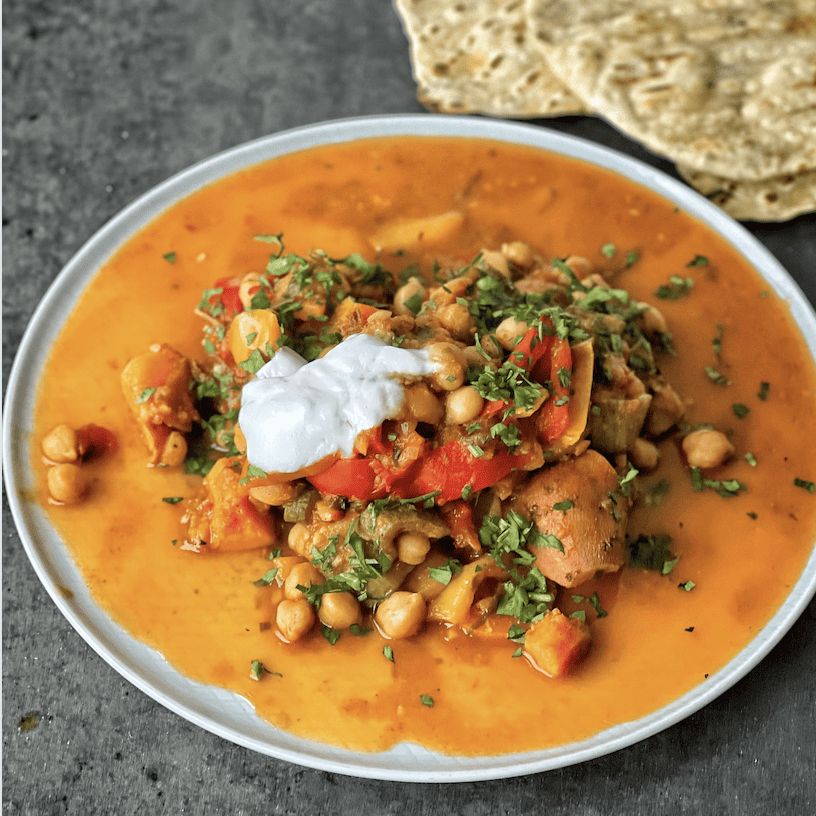
Easy Moroccan Tagine and Sesame Flatbreads
Takes
Serves 4
Ingredients
For the Tagine:
- 1 onion
- 2 cloves of garlic
- ½ red chilli deseeded if preferred
- 1 carrot
- 1 courgette
- 1 yellow pepper
- 1 sweet potato
- 1 tsp ground cumin
- 1 tsp cumin seeds
- 1 tsp ground coriander
- ½ tsp cinnamon
- ½ tsp smoked paprika
- ½ tsp ground black pepper
- 400 g tinned chopped tomatoes
- 400 ml vegetable stock
- 400 g tinned chickpeas drained and rinsed
- 3 tbsp raisins
- 2 tsp salt
- 2 tbsp tamari
- 1 tbsp maple syrup
For the Flatbreads:
- 200 g flour of choice
- 150 ml natural soy yoghurt
- 1 tsp baking powder
- ½ tsp salt
- 3 tbsp sesame seeds
- Extra flour for dusting
- Oil for cooking approx. 1 tbsp per flatbread
Garnish:
- 10 g fresh mint finely chopped
- Sesame seeds
- Dairy-free yoghurt optional
Instructions
For the Tagine:
- Prepare the Ingredients:Peel and finely chop the onion and garlic.Finely slice the chilli, removing the seeds if less heat is preferred.Chop the carrot, yellow pepper, courgette, and sweet potato into bite-sized pieces.Drain and rinse the chickpeas.
- Start Cooking:Heat a wide-bottom pan over high heat for a couple of minutes. Add the onion, carrot, chilli, and garlic, and cook for 2-3 minutes, stirring regularly. If the vegetables start to stick, add a few tablespoons of water to deglaze the pan.
- Add Vegetables and Stock:Add the yellow pepper, sweet potato, and courgette along with 1 tsp salt and half of the vegetable stock. Stir well, reduce the heat to medium, cover with a lid, and cook for 10 minutes, stirring occasionally.
- Add Spices and Remaining Ingredients:Add the ground cumin, cumin seeds, ground coriander, cinnamon, smoked paprika, and black pepper. Pour in the chopped tomatoes, tamari, maple syrup, remaining vegetable stock, chickpeas, and raisins. Mix well, cover, and cook for an additional 10 minutes.
For the Flatbreads:
- Prepare the Dough:In a mixing bowl, combine the flour, baking powder, and salt. Add the soy yoghurt and mix until a uniform dough forms.Knead the dough for about 5 minutes until it becomes soft.
- Shape and Cook:Divide the dough into 4 equal parts. Dust a surface with flour and roll each piece into a flat, thin round.Heat a large non-stick pan over high heat. Reduce to medium heat and sprinkle sesame seeds into the pan. Add 1 tbsp of oil and place one rolled-out flatbread in the pan. Cook until golden and air pockets form, then flip and cook the other side. Repeat with the remaining flatbreads.
Serving:
- Garnish the tagine with dairy-free yoghurt, a sprinkle of sesame seeds, and finely chopped mint. Serve with the sesame flatbreads and enjoy!
The Happy Pear Podcast
In our second enlightening encounter with Light Watkins, we dive even deeper into the realms of mindfulness and self-discovery.
Episode 137
This time, it’s a face-to-face conversation filled with profound insights and genuine connections. Join us as we explore the essence of Light’s latest book, “Travel Light: Spiritual Minimalism to Live a More Fulfilled Life,” and discover how embracing spiritual minimalism can truly transform your life.
Light Watkins is a globally recognised meditation teacher, author, and speaker who has been sharing the gift of mindfulness for over two decades. His journey started with a personal quest for inner peace and has since led him to guide countless individuals toward greater clarity, happiness, and purpose. Light’s approach to meditation is refreshingly accessible and down-to-earth, making it a perfect fit for anyone seeking to embark on a journey of self-discovery.
In this episode, Light shares profound insights on finding simplicity in our complex world, shedding the unnecessary baggage of life, and tapping into the essence of our true selves. Join us as we embark on a thought-provoking and soul-nourishing conversation that will hopefully leave you inspired to embrace spiritual minimalism and live a life of greater fulfillment.
Lots of Love,
Dave & Steve
Episode Sponsors & Discount Codes:
We have partnered with Instant, to bring you this amazing offer on their Vortex VersaZone Air Fryer now £149.99 (no code needed) until end of September , please follow the this link: https://bit.ly/3Pybzyp
Vivobarefoot Footwear. Vivobarefoot Footwear have given our listeners an exclusive 15% discount when you enter the code HAPPYPEAR15
Genuinely these are the only shoes you will see Dave & Steve wearing!
Produced by Sean Cahill & Sara Fawsitt
Available now from all good podcast providers:
A friend Steffan recently started growing oyster mushrooms and came in with an amazing flush of mushrooms. This is a dish to celebrate his amazing new mushrooms, it is a wonderful take on the classic! When you can get a fresh flush of mushrooms where they come together this is a great way to cook them where their texture becomes grizzly and the flavour intensifies.
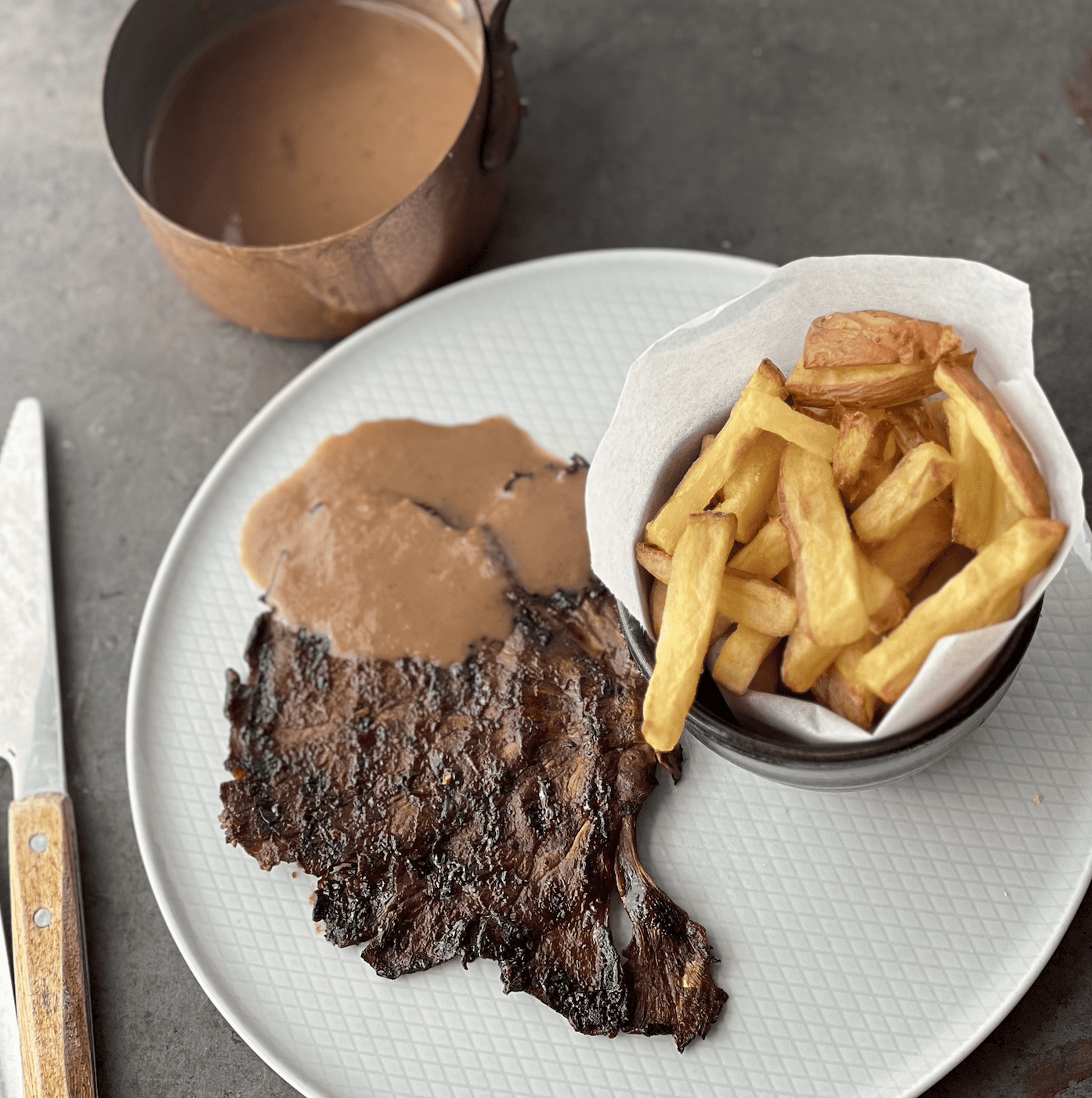
Mushroom steak with pepper sauce and chips
Takes 30 minutes
Serves 2
Ingredients
- 400 g flush of oyster mushrooms or miitake
- 2 tbsp oil
Mushroom dressing
- 2 tbsp miso
- 1 tbsp maple syrup
- 1 tbsp red wine vinegar
- 1 tsp garlic powder
Peppercorn sauce
- 1 tsp oil
- 1 shallots
- 10 green pepper corn
- 1 tbsp miso
- 50 ml red wine
- 100 ml veg stock
- 2 tbsp coconut cream
- salt
Instructions
- To make the peppercorn sauce – heat a medium saucepan on high heat and add in 5 of the pepper corns and cook for 3-4 mins to gentle toast them. Remove from the pan into a pestle and mortar and grind till smooth. Alternative you could just use some freshly ground peppercorns.
- Peel and finely dice the shallots. Put the saucepan back on the heat and add 1 tsp oil along with the shallots and fry for 3-4 mins stirring occasionally. Once they start to brown add in the wine to deglaze the pan. Cook until the wine virtually evaporates. Next add in the stock along with the miso and bring to the boil. Add in the coconut cream and a pinch of salt. Turn the heat down, add in the ground pepper to taste and adjust the seasoning to your liking. We actually added in ½ tsp of maple syrup to round out the sauce. Blend till smooth using an immersion blender or a counter blender. Set aside for plating up.
- For the mushrooms dressing add all the ingredients to a small saucepan and bring to a boil and allow to reduce for 1-2 mins stirring constantly. Remove from the heat.
- Put a griddle pan on high heat and add in 1 tbsp of oil and mix it around to coat the pan. Add in the big mushroom and using another clean sauce pan press down on the mushroom to compress it. This is to encourage more evaporation of liquid from the mushrooms to concentrate the flavour and give it a more grizzly texture. It will also give more char. Cook until golden on both side and add a pinch of salt to each side.
- Carefully add the mushroom dressing to one side and coat evenly and turn to cook for 1 minute on one side and coat the other side. Turn the pan off the heat and turn the mushroom and cook for 1 minute on the other side. The mushroom should look darker in colour and have lovely griddle lines. It should resemble a thin “steak” in appearance.
- Serve with a generous portion of the pepper sauce on the side and some freshly cooked chips or french fries for a real treat of a meal!
Notes
The Happy Pear Podcast
Join us in this week as we have the pleasure of sitting in person with Anthony Mullally, the former rugby league star turned performance coach. Anthony’s journey is nothing short of inspiring, and in this episode, we delve into his remarkable transformation from a professional athlete to a dedicated advocate for plant-based living, all while tackling important subjects like mental health and personal growth.
Episode 136
Anthony is a name that resonates with rugby league fans, having played for some of the sport’s biggest teams, including Leeds Rhinos and Warrington Wolves. But Anthony’s story takes a fascinating turn as he transitioned from the demanding world of professional sports to becoming a leading performance coach. His journey is a testament to the power of resilience and reinvention.
In this episode, we explore the challenges and rewards of Anthony’s dietary shift, shedding light on how plant-based nutrition can optimise performance, recovery, and overall well-being.
But our conversation doesn’t stop at diet; we dive deep into the world of mental health and personal development. Anthony’s insights into the mental challenges athletes face and the strategies he employs to address them are not only valuable for sports enthusiasts but for anyone looking to enhance their mental resilience.
Discover more about Anthony Mullally’s transformative journey and his work as a performance coach by visiting his website here. This episode is a must-listen for those seeking inspiration, motivation, and a fresh perspective on how plant-based living can lead to peak performance and holistic wellness.
Lots of Love,
Dave & Steve
This episode is sponsored by Air Up. This revolutionary water bottle that will blow your mind and get you drinking tons more water, have given our listeners an exclusive 10% discount when you enter the code HAPPYPEAR10 &
We have partnered with our FAVOURITE Instant Brand! Dave is particularly obsessed with their Vortex VersaZone Air Fryer which is currently on 25% discount, click here to find out more!
Produced by Sean Cahill & Sara Fawsitt
Available now from all good podcast providers:

King Oyster Mushroom BLT
Takes 20 minutes
Serves 2
Ingredients
- 5 King Oyster Mushrooms
- 1 tsp oil
Dressing
- 4 tbsp tamari
- 2 tbsp maple syrup
- 1/2 tsp garlic powder
- 1/4 tsp ground chilli powder
- 1 tsp smoke paprika
- 1/2 tsp black pepper
- pinch salty
To serve
- 4 slices sourdough
- 60 g vegan mayo
- 2 tomatoes
- 1 head baby gem lettuce
Instructions
- Preheat your air fryer on the bake function to 180°C.
- Slice the king oyster mushrooms lengthwise into strips approximately ½ cm thick. Add them to the preheated air fryer with 1 tsp oil and toss to coat. Bake for 10 minutes, shaking occasionally to ensure they sear evenly.
- Meanwhile, mix all the dressing ingredients in a bowl.
- Remove the mushrooms from the air fryer and toss them in the dressing until evenly coated. Return the mushrooms to the air fryer for a final 5 minutes, shaking once midway to ensure even caramelisation.
- Remove the mushrooms from the air fryer. Taste and adjust seasoning if needed. The strong flavour will balance out the juiciness of the tomato and lettuce in the sandwich.
- Slice the tomatoes, wash and rinse the lettuce, and toast the bread if desired.
- Spread vegan mayo on one side of each slice of bread. On two slices, layer the tomatoes, lettuce, and mushrooms. Top with the remaining slices of bread, mayo side down.
- Serve and enjoy!

Crispy Tofu and Mushroom Ramen
Takes 30 minutes
Serves 4
Ingredients
Broth ingredients
- 1 tbsp dried seaweed (chopped finely)
- 1 bunch scallions
- 50 g radish stalks (celery works too)
- 1 onion
- 2 cloves garlic
- 1/2 thumb-size ginger
- 1 tbsp sesame oil
- 1 star anise pod
- 2 cinnamon sticks
- 1 red chilli
- 2 L veg stock
- 1 tbsp miso
- 3 tbsp tamari
- 8 g dried mushroom (porcini or shiitake)
- 15 g coriander
- 300 g noodles of choice
Crispy Mushroom and Tofu
- 200 g firm tofu
- 30 g oyster mushroom
- 2 tbsp tamari
- 1 tbsp coconut sugar
- 1 tsp miren
To serve
- 2 tbsp sesame seeds
- 5 fresh radish pickled
- 30 ml vinegar
Instructions
- Pickle the radish:Finely slice the radishes and place them in a glass jar with the vinegar. Cover with water. If you have any brine from pickled red cabbage, add it to give the radishes a beautiful pink hue. Leave to pickle while you prepare the rest.
- Prepare the broth:Peel and finely dice the onion and garlic. Chop the white part of the scallions, and finely dice the ginger and ½ of the red chilli. Heat a large pot (approx. 5L) over high heat, add the sesame oil, and once hot, add the diced onion, ginger, chilli, and the white part of the scallions along with the seaweed and a pinch of salt. Cook for 3–4 minutes, stirring constantly. If it starts to stick, add a couple of tablespoons of vegetable stock to deglaze the pan and form a base sauce.Finely dice the coriander stalks and add them to the pot. Then, add the vegetable stock, cinnamon sticks, star anise, tamari, and miso, and stir to combine. Bring to a boil, then reduce the heat and simmer for 5 minutes.
- Make the crispy tofu and mushrooms:Finely slice the mushrooms lengthwise (approx. ½ cm thick) and cut the tofu into 1–2 cm cubes. Preheat your air fryer to 180°C on the bake function for 10 minutes. Add the tofu and mushrooms to the air fryer with 5 sprays of oil (approx. ½ tsp), mix well, and bake for 10 minutes. During baking, shake the air fryer basket once or twice to ensure even cooking.In a large bowl, mix 2 tbsp tamari, coconut sugar or brown sugar, and mirin or vinegar. Remove the tofu and mushrooms from the air fryer, add them to the bowl with the sauce, and toss to coat. Return them to the air fryer for another 5 minutes to crisp up. Remove and set aside.
- Cook the noodles:Cook the noodles according to the package instructions. Drain and rinse them to prevent sticking.
- Prepare garnishes:Finely dice the coriander leaves, the remaining ½ chilli, and the green parts of the scallions.
- To serve:Divide the cooked noodles between 4 bowls. Pour the broth over the noodles, then add the crispy tofu and mushrooms. Top with the chopped scallions, coriander leaves, sliced chilli, sesame seeds, and pickled radishes. Enjoy!
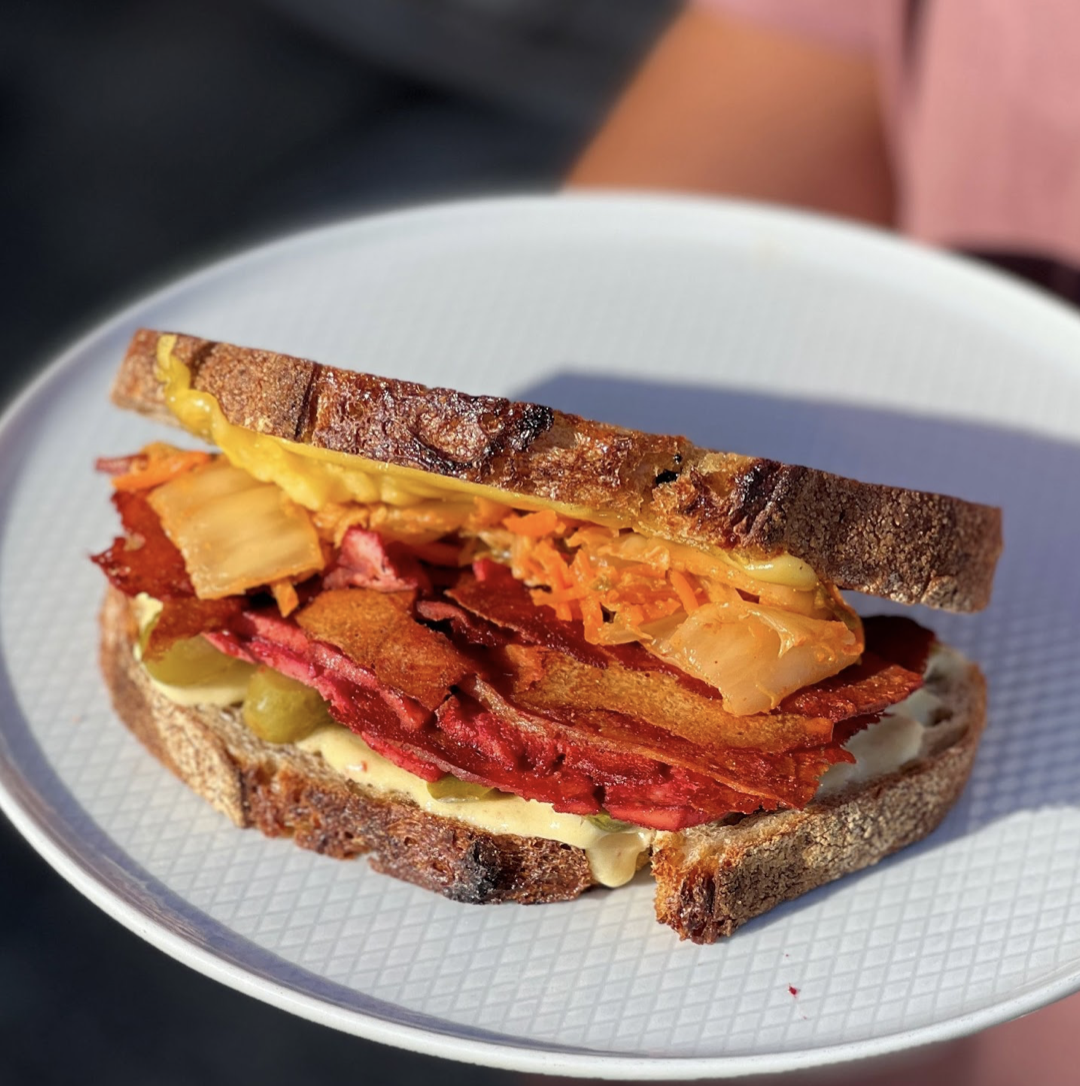
Vegan Pastrami Sandwich
Takes 25 minutes
Serves 2
Ingredients
- 400 g tofu
Marinade
- 1 small beetroot (raw or vacuum packed)
- 250 ml veg stock
- 2 tbsp apple cider vinegar
- 3 tbsp tamari
- 1 tbsp dijon mustard
- 1/2 tsp black pepper
- 1 tsp ground coriander
- 1 tsp smoked paprika
- 1 tsp garlic powder
To serve
- 4 slices sourdough
- 10 gherkins
- 2 tbsp dijon mustard
- 4 tbsp vegan mayo
- 4 slices vegan cheese
- 60 g kimchi
Instructions
- Prepare the tofu:Press the tofu to remove excess water. Using a mandolin or sharp knife, slice the tofu into thin strips, approx. ½ cm thick or thinner.
- Make the marinade:Blend all the marinade ingredients (beetroot, vegetable stock, apple cider vinegar, tamari, Dijon mustard, black pepper, ground coriander, smoked paprika, and garlic powder) in a blender or food processor until smooth.
- Marinate the tofu:Place the sliced tofu in a large baking tray or wide container. Pour the marinade over the tofu, ensuring all pieces are evenly coated. Leave to marinate for 20 minutes, flipping the tofu halfway through to ensure both sides are covered.
- Preheat the oven:Preheat the oven to 200°C (fan-assisted).
- Bake the tofu:Transfer the marinated tofu to a clean baking tray. Optionally, spray the tofu with a little oil to encourage a charred, crispy texture. Bake for 10 minutes on each side, or until the tofu looks dry and resembles pastrami. Remove from the oven.
- Toast the bread:While the tofu bakes, toast the slices of sourdough bread until golden brown.
- Assemble the sandwiches:To make one sandwich, spread a generous dollop of vegan mayo on one slice of bread. Add 5 gherkins, half the tofu "pastrami", 30g kimchi, a slice of vegan cheese, and a thin layer of Dijon mustard on the other slice of bread.Optional: If you prefer melted cheese, assemble the sandwich without the top slice, place it in the oven, and bake for 5 minutes until the cheese melts. Add the top slice after baking.
- Serve:Repeat the assembly process for the second sandwich. Serve immediately and enjoy!
The Happy Pear Podcast
In this week’s captivating episode, we delve into the fascinating world of sustainable farming with author and co-founder of Black Barn Farm, Jade Miles.
Episode 135
Black Barn Farm, is a biodiverse orchard, nursery and workshop space in north east Victoria which is a magnet for visitors to learn about permaculture, homesteading, as well as to pick-their-own from some of the 98 varieties of heritage fruit and berries.
Jade’s journey from urban living to becoming a passionate advocate for regenerative agriculture is a true inspiration. A renowned sustainable farmer and environmental activist, with a background in ecology and a deep love for the earth, Jade, alongside her partner Charles Showers, embarked on a life-changing adventure to establish Black Barn Farm, a thriving hub for regenerative farming practices. Her commitment to ethical and sustainable agriculture has earned her recognition in the field.
Jade is part of a growing wave of women keen to arm themselves with skills like farming, composting, making and mending, and pickling and preserving. Just as the Covid-19 lockdown and its closure of supermarkets and limited food supplies were a call to arms for amateur sourdough bakers, Miles and her cohort were inspired by impending climate change, like the 2020 summer bushfires, to become more self-sufficient and less reliant on material and consumer culture.
Join us for an enlightening conversation with Jade Miles, as we uncover the secrets of sustainable farming and its vital role in creating a healthier planet.
Lots of Love,
Dave & Steve
This episode is sponsored by Vivobarefoot Footwear. Vivobarefoot Footwear have given our listeners an exclusive 15% discount when you enter the code HAPPYPEAR15
Genuinely these are the only shoes you will see Dave & Steve wearing!
Produced by Sean Cahill & Sara Fawsitt
Available now from all good podcast providers:

Buttery Hummus
Takes 14 minutes
Serves
Ingredients
- 2 tins butterbeans (500g nett weight)
- 1/2 tsp baking soda
- 1 lemon
- 2 garlic cloves
- 1 tsp salt
- 4 ice cubes
- 6 tbsp tahini
- 5-6 tbsp water
- 2 tbsp olive oil
To serve
- 1 ripe tomato
- 10 g fresh coriander
- 30 g pickled red cabbage
- 1/2 tsp sumac (Korean chilli powder)
- 2 tbsp olive oil
- 4 slices sourdough toast
Instructions
- Prepare the beansDrain and rinse the butter beans, then add them to a saucepan with the baking soda. Cover with freshly boiled water and boil for 5 minutes.
- Rinse and peelDrain and rinse the beans under cold water. Do your best to remove as many of the butter bean skins as possible. The easiest way to do this is to squeeze the cooked beans gently, and the beans will pop out of their skins. Although this step isn’t essential, it helps achieve a super creamy texture.
- Blend the hummusAdd the peeled butter beans to a food processor along with the garlic, juice of ½ a lemon, tahini, ice cubes, 1 tsp salt, and 5 tbsp water. Blend for 2-3 minutes while slowly adding the olive oil. Taste and adjust the seasoning as needed by adding more salt, lemon juice, or garlic. If the mixture is too thick, add 1-2 tbsp more water.
- Taste and adjustTo achieve incredible hummus, taste it regularly during the process and don’t be afraid to adjust the seasoning to your liking. If it tastes flat or bland, add a little more salt. If it's too thick or stodgy, add more lemon juice. For a stronger base flavour, add ½ clove of garlic and ensure it's fully blended in.
- Blend to perfectionBlend for an additional 3-4 minutes until the hummus is super silky, smooth, and buttery. Taste and make any final adjustments. Pour the hummus onto a plate.
- Prepare the garnishFinely dice the tomato, pickled red cabbage, and coriander, and mix them together. Spread the hummus out on the plate, creating a well in the centre for the tomato, cabbage, and coriander mix. Sprinkle with sumac or chilli powder and drizzle with 1-2 tbsp of olive oil.
- ServeEnjoy with some fresh sourdough bread or toast.

Chocolate raspberry no bake cups
Takes 13 minutes
Serves 6
Ingredients
- 6 tbsp oats
- 80 g cashews
- 100 g chopped dates
- 2 tbsp coconut oil
- Filling
- 150 g raspberries
- 2 tbsp chia seeds
- 1 tbsp maple syrup
- Top layer
- 150 g chocolate
Instructions
- Prepare the Base:In a food processor or blender, add the cashews, dates, oats, and coconut oil. Blend for about 2-3 minutes, or until the mixture begins to come together into a sticky, cohesive mass.
- Line the Cupcake Tin:Line a 6-cup cupcake tin with cupcake liners. Divide the oat-cashew-date mixture evenly between the 6 cases, pressing it firmly to create the base layer. Shape the mixture up the sides slightly to form a cup, ensuring it’s thick enough to hold the filling without leaking.
- Make the Raspberry Filling:In a bowl, combine the raspberries, chia seeds, and maple syrup. Use a fork to roughly mash the mixture, leaving some texture.
- Fill the Cups:Spoon the raspberry filling into each of the 6 cups, filling them just to the top of the cashew base. Ensure the filling doesn’t overflow so it can be easily capped with chocolate.
- Melt the Chocolate:Melt the chocolate in a microwave or over a double boiler. Once melted, evenly pour it over the top of each cup, ensuring the filling is fully covered.
- Set the Cups:Allow the chocolate to set. If you're in a hurry, place the cups in the fridge or freezer to speed up the process. Once the chocolate has hardened, they are ready to enjoy!
The Happy Pear Podcast
Welcome to another illuminating episode! In this engaging discussion, we’re joined by Rohini Bajekal, a highly regarded plant-based nutritionist, to explore the multifaceted realm of women’s health.
Together, we delve into the profound impact of plant-based nutrition on women’s well-being, touching on various aspects of women’s health, including managing conditions like PCOS and navigating the transformative journey of menopause.
Episode 134
Rohini’s expertise shines as we uncover the science-backed benefits of a balanced, plant-based diet, offering insights into its potential to manage and alleviate symptoms associated with conditions such as PCOS. We also explore how nutrition plays a pivotal role in promoting overall health and vitality throughout a woman’s life. And how Rohini herself navigated herself through the nutrition space as a plant-based practitioner.
Beyond nutrition, Rohini shares her valuable involvement in The Happy Pear’s Menopause Course, a comprehensive resource designed to empower women with knowledge and practical tools to optimise their health. This course encompass a wide spectrum of topics, from hormonal balance to mental well-being, embracing a holistic approach to women’s health.
Whether you’re interested in understanding the role of nutrition in women’s health, seeking guidance on managing specific conditions, or simply looking to enhance your overall well-being, this episode offers a wealth of wisdom and inspiration.
This episode is sponsored by Air Up. This revolutionary water bottle that will blow your mind and get you drinking tons more water, have given our listeners an exclusive 10% discount when you enter the code HAPPY10
Lots of Love,
Dave & Steve
Produced by Sean Cahill & Sara Fawsitt
Available now from all good podcast providers:
The Happy Pear Podcast
In this week’s episode we delve into the fascinating world of “Why Woo Woo Works” with the esteemed Dr. David Hamilton.
Episode 133
Dr. David Hamilton, a distinguished author and a holder of a Ph.D. in Organic Chemistry, brings a unique blend of scientific expertise and spiritual wisdom to our discussion. With a rich background in the pharmaceutical industry and a profound understanding of the mind-body connection, Dr. Hamilton has become a leading authority in bridging the gap between science and spirituality.
In this episode, we explore the profound implications of “woo-woo” concepts, going beyond their mystical reputation to uncover the scientific principles that underlie them. Dr. Hamilton sheds light on the incredible influence of our thoughts and intentions on our overall health and well-being, drawing from his extensive knowledge in quantum physics and consciousness.
Join us on a journey of self-discovery and empowerment as we learn practical strategies for harnessing the power of our minds. Dr. Hamilton’s insights will inspire you to tap into your own “woo-woo” potential, combining spirituality and science to create a more fulfilling life.
Discover why “Why Woo Woo Works” is more than just a catchphrase and how you can integrate its principles into your everyday life.
This episode is sponsored by Air Up. This revolutionary water bottle that will blow your mind and get you drinking tons more water, have given our listeners an exclusive 10% discount when you enter the code HAPPY10
Lots of Love,
Dave & Steve
Produced by Sean Cahill & Sara Fawsitt
Available now from all good podcast providers:
The Happy Pear Podcast
Get ready to be inspired by the incredible journey of Matt Smith, a true sustainability trailblazer and the dynamic CEO of Hometree Charity. Matt’s passion for positive change is matched only by his impressive credentials. Armed with a foundation degree in Natural Science, he’s not only well-versed in environmental matters but also deeply committed to making a difference.
Episode 132
In 2013, Matt co-founded a regenerative agriculture farm, showcasing his innovative spirit and dedication to nurturing the Earth. But that’s not all—his love for the oceans led him to own an annual ocean-based publication, a celebration of marine wonder that resonates with his adventurous spirit.
A published writer in his own right, Matt’s words have powerfully conveyed the essence of sustainability, eco-consciousness, and unity with nature. His writing serves as a roadmap for those seeking a greener path forward.
Matt recently completed a ‘critical leadership’ course with Cumbria University, guided by the eminent Prof Jem Bendell. This reflects his unyielding commitment to personal growth and effective leadership, adding an exciting dimension to his already impressive repertoire.
Join us in this week’s episode as we uncover the vibrant tapestry of Matt’s life, from regenerative farming to oceanic appreciation, and his pivotal role in steering Hometree Charity towards a brighter, more sustainable future. Tune in and let Matt’s uplifting journey ignite your own drive to create positive change!
Lots of Love,
Dave & Steve
This episode is sponsored by Vivobarefoot Footwear. Vivobarefoot Footwear have given our listeners an exclusive 15% discount when you enter the code HAPPYPEAR15
Genuinely these are the only shoes you will see Dave & Steve wearing!
Produced by Sean Cahill & Sara Fawsitt
Available now from all good podcast providers:
The Happy Pear Podcast
Get ready for an insightful episode as we speak with renowned neuroscientist and bestselling author, Dr. Caroline Leaf!
Episode 131
In this conversation, Dr. Leaf delves into the crucial topics of mental health and depression, while also giving a sneak peek into her upcoming book, “How to Help Your Child Clean Up Their Mental Mess: A Guide to Building Resilience and Managing Mental Health.”
Dr. Caroline Leaf’s credentials as a world-leading cognitive neuroscientist and communication pathologist, with a Ph.D. in Communication Pathology specialising in Neuropsychology, set the stage for a truly captivating discussion. With her wealth of experience and expertise, Dr. Leaf has garnered international acclaim for her groundbreaking research on the mind-brain connection and her compassionate approach to mental well-being.
In this candid and compassionate episode, Dr. Leaf opens up about the profound impact of mental health on our lives and the lives of our loved ones. She addresses the pressing issue of depression, debunking common myths and shedding light on how it affects individuals of all ages.
Using her expertise and extensive research, Dr. Caroline Leaf shares valuable insights on how we can proactively manage and improve our mental well-being. She empowers listeners with practical tools and techniques to recognise the signs of mental distress, fostering a greater sense of self-awareness and emotional intelligence.
Throughout the episode, Dr. Leaf’s compassionate approach shines through as she emphasises the power of self-acceptance and the value of seeking professional help when needed. Her insights on building resilience and nurturing positive thought patterns offer hope and encouragement to anyone struggling with mental health concerns.
While Dr. Caroline Leaf briefly mentions her forthcoming book on helping children with their mental mess, the focus of this episode remains on the broader topic of mental health and depression. An insightful episode we hope you got as much out of it as we did.
Lots of Love,
Dave & Steve
This episode is sponsored by Air Up. This revolutionary water bottle that will blow your mind and get you drinking tons more water, have given our listeners an exclusive 10% discount when you enter the code HAPPYPEAR10
Produced by Sean Cahill & Sara Fawsitt
Available now from all good podcast providers:

Chocolate raspberry no bake cups
Takes 13 minutes
Serves 6
Ingredients
- 6 tbsp oats
- 80 g cashews
- 100 g chopped dates
- 2 tbsp coconut oil
- Filling
- 150 g raspberries
- 2 tbsp chia seeds
- 1 tbsp maple syrup
- Top layer
- 150 g chocolate
Instructions
- Prepare the Base:In a food processor or blender, add the cashews, dates, oats, and coconut oil. Blend for about 2-3 minutes, or until the mixture begins to come together into a sticky, cohesive mass.
- Line the Cupcake Tin:Line a 6-cup cupcake tin with cupcake liners. Divide the oat-cashew-date mixture evenly between the 6 cases, pressing it firmly to create the base layer. Shape the mixture up the sides slightly to form a cup, ensuring it’s thick enough to hold the filling without leaking.
- Make the Raspberry Filling:In a bowl, combine the raspberries, chia seeds, and maple syrup. Use a fork to roughly mash the mixture, leaving some texture.
- Fill the Cups:Spoon the raspberry filling into each of the 6 cups, filling them just to the top of the cashew base. Ensure the filling doesn’t overflow so it can be easily capped with chocolate.
- Melt the Chocolate:Melt the chocolate in a microwave or over a double boiler. Once melted, evenly pour it over the top of each cup, ensuring the filling is fully covered.
- Set the Cups:Allow the chocolate to set. If you're in a hurry, place the cups in the fridge or freezer to speed up the process. Once the chocolate has hardened, they are ready to enjoy!
The Happy Pear Podcast
In our latest, meet Tom Turcich, the man who transformed his dream into reality by dedicating over half his life to an extraordinary mission. From the age of seventeen to thirty-three, Tom embarked on a single-minded adventure, walking around the world.
Episode 130
On May 21st, 2022, he achieved the unimaginable, becoming the tenth person ever to complete this monumental feat!
Tom, shares his inspiring story, and the essence of his remarkable journey. Experience the highs and lows, the friendships formed, and the boundless beauty of our planet, all encountered one step at a time.
With infectious enthusiasm and genuine humility, Tom’s world walk reminds us that audacious dreams are attainable with unwavering determination. Get ready to be inspired and uplifted as you explore the world through Tom Turcich’s extraordinary adventure.
Lots of Love,
Dave & Steve
This episode is sponsored by Air Up. This revolutionary water bottle that will blow your mind and get you drinking tons more water, have given our listeners an exclusive 10% discount when you enter the code HAPPYPEAR10
Produced by Sean Cahill & Sara Fawsitt
Available now from all good podcast providers:
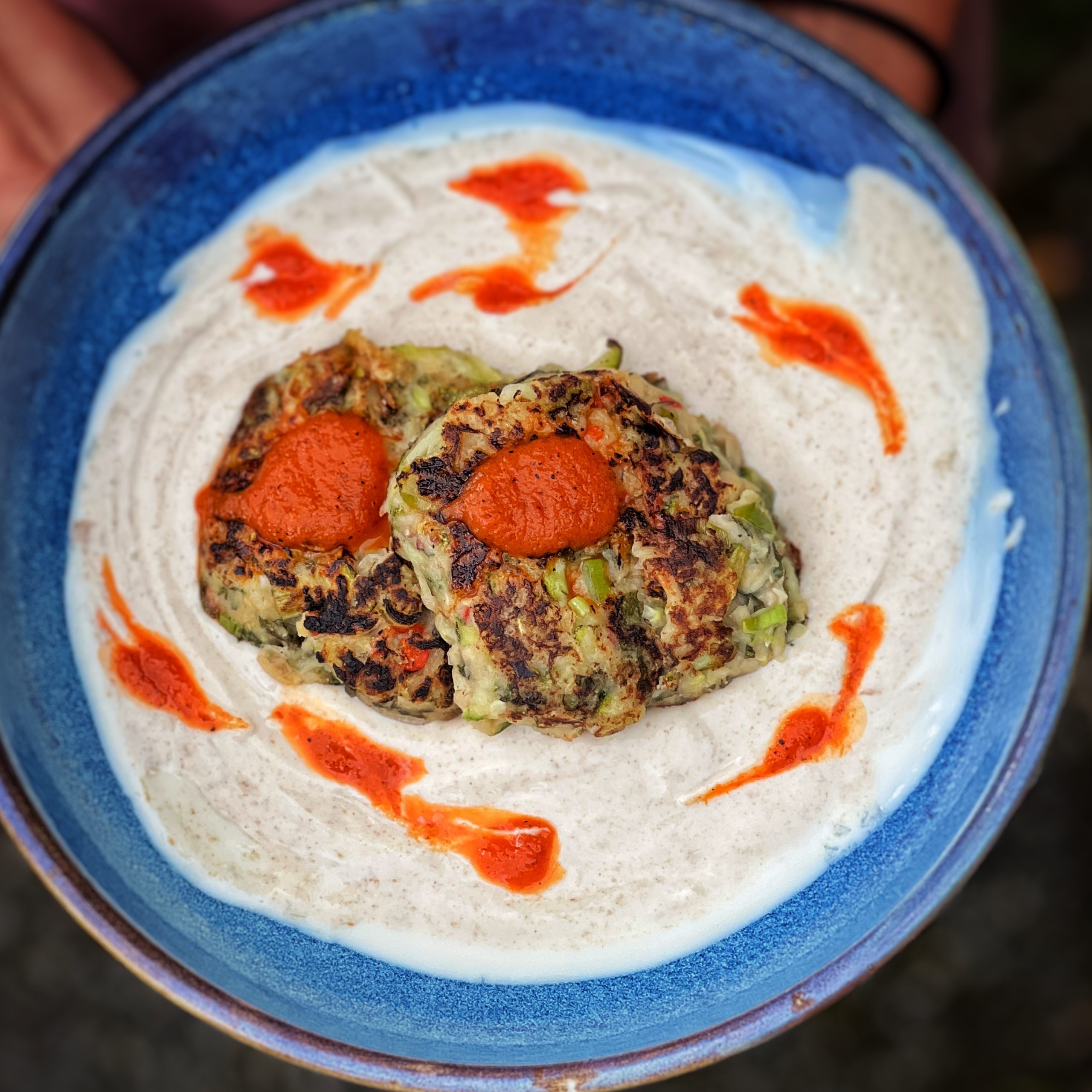
Courgette Fritters with a red pepper pickle sauce and tahini cream
Takes 20 minutes
Serves 2
Ingredients
- 260 g courgettes
- ½ red chilli
- ½ bunch of scallions (or spring onions)
- 240 g of tinned butter beans
- small bunch of fresh mint or coriander (10g)
- Juice of ½ lemon
- 2 tsp lemon zest
- 4 tbsp regular flour (or chickpea flour)
- ½ tsp salt
- ½ tsp black pepper
Roasted red pepper pickle sauce
- 1 340g jar of roasted red pepper (220g drained weight in brine not oil)
- 4 tbsp brine (from the roasted red pepper jar)
- Pinch of salt
Tahini cream
- 150 g natural soy yoghurt
- 2 tbsp light tahini
- Pinch of salf
Instructions
- Prepare the courgettes: Grate the courgettes into a colander, sprinkle with a pinch of salt, and squeeze with your hands for about 30 seconds. Let them sit in the colander for 5-10 minutes to drain excess moisture.
- Chop the vegetables: While the courgettes are draining, finely chop the chilli (remove the seeds if you don’t like it too spicy) and the greens of the scallions (spring onions). Drain and rinse the butter beans, and finely chop the mint or coriander leaves.
- Prepare the fritter mix: After letting the courgettes sit for at least 5 minutes, squeeze out as much liquid as possible and discard it. Place the drained courgettes in a large bowl.
- Combine ingredients: Add the chopped chilli, scallions, butter beans, mint or coriander, lemon juice, lemon zest, flour, salt, and black pepper to the bowl. Mash the ingredients together using a potato masher or a fork until well combined.
- Form the fritters: Take approximately 2 tablespoons of the mixture and shape it into small fritters (disk shapes) using your hands.
- Cook the fritters: Heat a non-stick pan on high heat. Once the pan is hot, add ½ tsp of oil and spread it around. Gently wipe away the excess oil using kitchen paper to leave a light coating. Add the fritters to the pan and cook for about 2 minutes on each side, or until golden brown. Repeat until all the fritters are cooked.
- Make the red pepper pickle sauce: Remove the roasted red peppers from the jar, reserving the brine. Place the roasted peppers (without the brine) in a blender, add 4 tbsp of the brine, and a pinch of salt. Blend until super smooth. Taste and adjust seasoning with more salt or maple syrup if needed, keeping in mind that the sauce should be sharp and acidic.
- Make the tahini cream: In a small bowl, mix the soy yoghurt, tahini, and a pinch of salt until smooth.
- Serve: Divide the tahini cream between two plates. Place the fritters on top of the tahini cream and drizzle over the red pepper pickle sauce. Serve with some sauerkraut or avocado if desired. Enjoy!

Easy raspberry Bakewell puff pastry pie
Takes 40 minutes
Serves 10
Ingredients
- 1 x 320g sheet pre rolled vegan shortcrust (or puff pastry)
- 200 g raspberry jam
- Frangipane
- 200 g ground almonds
- 175 ml maple syrup (or agave syrup)
- 125 g self raising flour
- 1 tsp almond essence
- 150 g plant based butter
- 8 tablespoons water
- Pinch of salt
- Optional
- 25 g flaked almonds
- 75 g fresh raspberries
- Ice cream to serve
Instructions
- Preheat the oven: Preheat the oven to 180°C, fan-assisted.
- Prepare the pastry: If using frozen pastry, allow it to defrost. Roll out the pastry and line a 25 x 18cm (3.5cm deep) tray with parchment paper. Transfer the pastry to the tray and trim it to fit.
- Blind bake the pastry: To blind bake, line the pastry with another sheet of parchment paper and fill with baking beans. Bake for 10 minutes, then remove the beans and paper. Return the pastry to the oven for 5 more minutes to cook the base. Remove and allow to cool.
- Reduce the oven temperature: Lower the oven temperature to 150°C.
- Make the frangipane: While the pastry is blind baking, prepare the frangipane. In a large mixing bowl, combine the ground almonds, a pinch of salt, and sieve in the self-raising flour. Mix until well combined. In a separate bowl, melt the plant-based butter and mix in the maple syrup or agave syrup, almond essence, and 8 tablespoons of water. Combine the wet and dry ingredients until a smooth batter forms.
- Assemble the pie: Spread the raspberry jam evenly over the pastry, leaving approximately a 1-2 cm border around the edge. Pour the almond mixture (frangipane) over the jam, spreading it evenly. If using, dot the fresh raspberries over the frangipane and press them in gently. Scatter flaked almonds on top.
- Bake the pie: Bake for 30 minutes, rotating halfway through to ensure even browning. Insert a skewer into the centre; it should come out almost dry when the pie is ready.
- Cool and serve: Remove the pie from the oven and allow it to cool fully in the tray before slicing. For a classic Bakewell presentation, cut the pie into fingers (approximately 3 x 12 cm) or your preferred size. Serve with ice cream, if desired, and enjoy!
The Happy Pear Podcast
Josh Whiton is a regenerative technologist working to repair the Planet and our relationship to it.
At the age of 23, he founded a tech-startup that improved public transit usage, reduced car dependency, and created jobs while reducing fossil fuel emissions and the carbon footprint of millions. It was later acquired by the Ford Motor Company and became Ford Smart Mobility.
Episode 129
For his positive contributions to society and the environment, Josh was named Champion of Change by the Obama administration. He was also awarded a Global Impact Visa by the New Zealand government, and his work has been highlighted by Fast Company magazine as among the world’s most innovative.
One of his latest initiatives is helping communities worldwide to establish a more beautiful food system by creating new living soil together. Now in 70+ countries and growing, people can participate in creating a more sustainable, resilient, and distributed food system at MakeSoil.org. Josh also co-founded one of the first urban farms in the southeastern United States. Still in operation today, the urban farm helps thousands of people each year to participate in and benefit from local food production.
Josh is an avid writer, speaker, and builder of technology, and continues to explore the implications of technology on humanity and nature. He also shares original and compelling insights about the nature of artificial intelligence on Substack.
In his episode we had the pleasure of hosting Josh in person, the conversation was so good we actually had to stop and record it in two parts! This part one we delve deep into what it is to be an entrepreneur, Josh’s fascinating back story, religion, soil and so much more!
Lots of Love,
Dave & Steve
This episode is sponsored by Vivobarefoot Footwear. Vivobarefoot Footwear have given our listeners an exclusive 15% discount when you enter the code HAPPYPEAR15
Genuinely these are the only shoes you will see Dave & Steve wearing!
Produced by Sean Cahill & Sara Fawsitt
Available now from all good podcast providers:
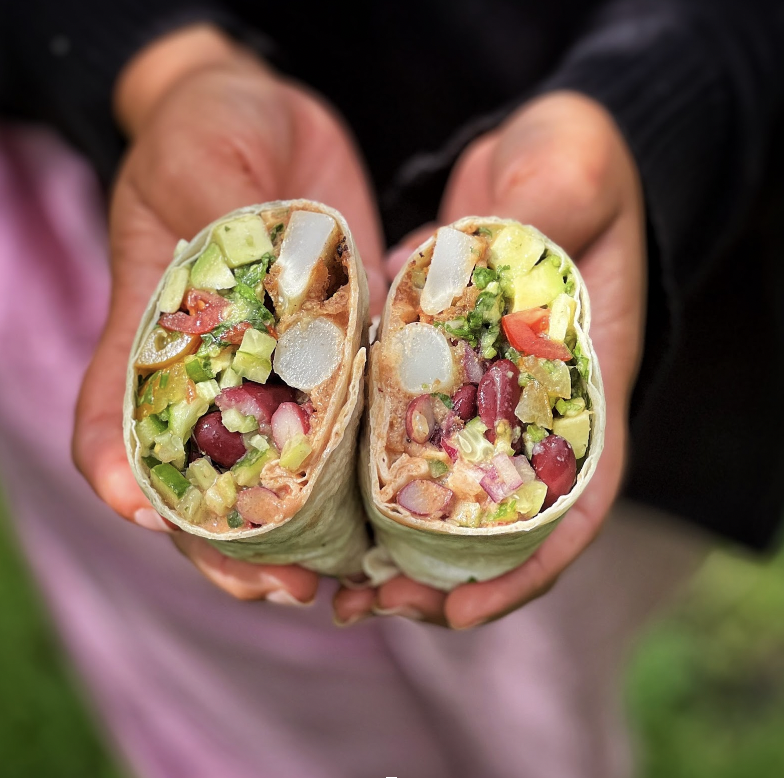
Crispy cauliflower Bang Bang burritos
Takes 30 minutes
Serves 2
Ingredients
Batter
- 8 tbsp flour
- 1 tbsp smoked paprika
- 100 ml oat milk
- pinch salt
Sauce
- 4 tbsp tahini
- 1/4 tsp black pepper
- 1 tbsp apple cider vinegar
- 2 cm ginger
- 1 clove garlic
- 1/2 red chilli
- 2 tbsp tamari
- 2 tbsp maple syrup
- 3 tbsp tomato paste
- 5 tbsp water
- pinch salt
Breading
- 100 g panko bread crumbs
Other ingredients
- 1 head cauliflower
- 150 ml sunflower oil (for frying)
- 1/2 cucumber
- 1/4 red onion
- 250 g kidney beans
- 2 tbsp apple cider vinegar
- 1 tsp cumin
- pinch salt
- 1 avocado
- 10 cherry tomatoes
- 15 g fresh coriander
- 1/2 lemon
- 2 wraps
Instructions
- Blanch the cauliflower: Fill and boil the kettle. In a medium-sized saucepan, add the boiled water and a generous pinch of salt. Drop in the cauliflower florets and blanch for 5-6 minutes until ¾ cooked. Drain and leave to cool.
- Make the sauce: In a tall glass or jar, mix all the sauce ingredients—ginger, garlic, diced red chilli, tahini, black pepper, apple cider vinegar, tamari, maple syrup, tomato paste, water, and a pinch of salt.
- Prepare the batter: In a wide bowl, mix together the flour, smoked paprika, oat milk, and a pinch of salt. Stir in half of the sauce to form a smooth batter.
- Prepare the breading: In another wide bowl, place the panko bread crumbs.
- Set up the assembly line: Arrange the blanched cauliflower, batter, and breadcrumbs in a line. Have a plate with paper towels ready to place the fried cauliflower on.
- Fry the cauliflower: Heat the sunflower oil in a medium-sized saucepan on high heat. Once hot, reduce to medium heat. In small batches, dip each cauliflower floret into the batter, then coat with the breadcrumbs. Fry for 2-3 minutes, turning regularly, until golden. Transfer to a paper towel to absorb excess oil. Alternatively, bake at 180°C for 15 minutes.
- Make the bean salad: In a large bowl, combine the diced cucumber, diced red onion, kidney beans, apple cider vinegar, cumin, and a pinch of salt. Set aside.
- Prepare the guacamole: Remove the seed and skin of the avocado and chop the flesh. Add to a bowl with the cherry tomatoes, fresh coriander, a pinch of salt, a pinch of black pepper, and the juice of half a lemon. Mash together with a fork.
- Assemble the burritos: Take a wrap and add a few spoonfuls of guacamole, bean salad, and 2-3 cauliflower florets. Drizzle with two spoonfuls of the extra sauce. Wrap the burrito and enjoy! Repeat with the remaining ingredients for the second burrito.
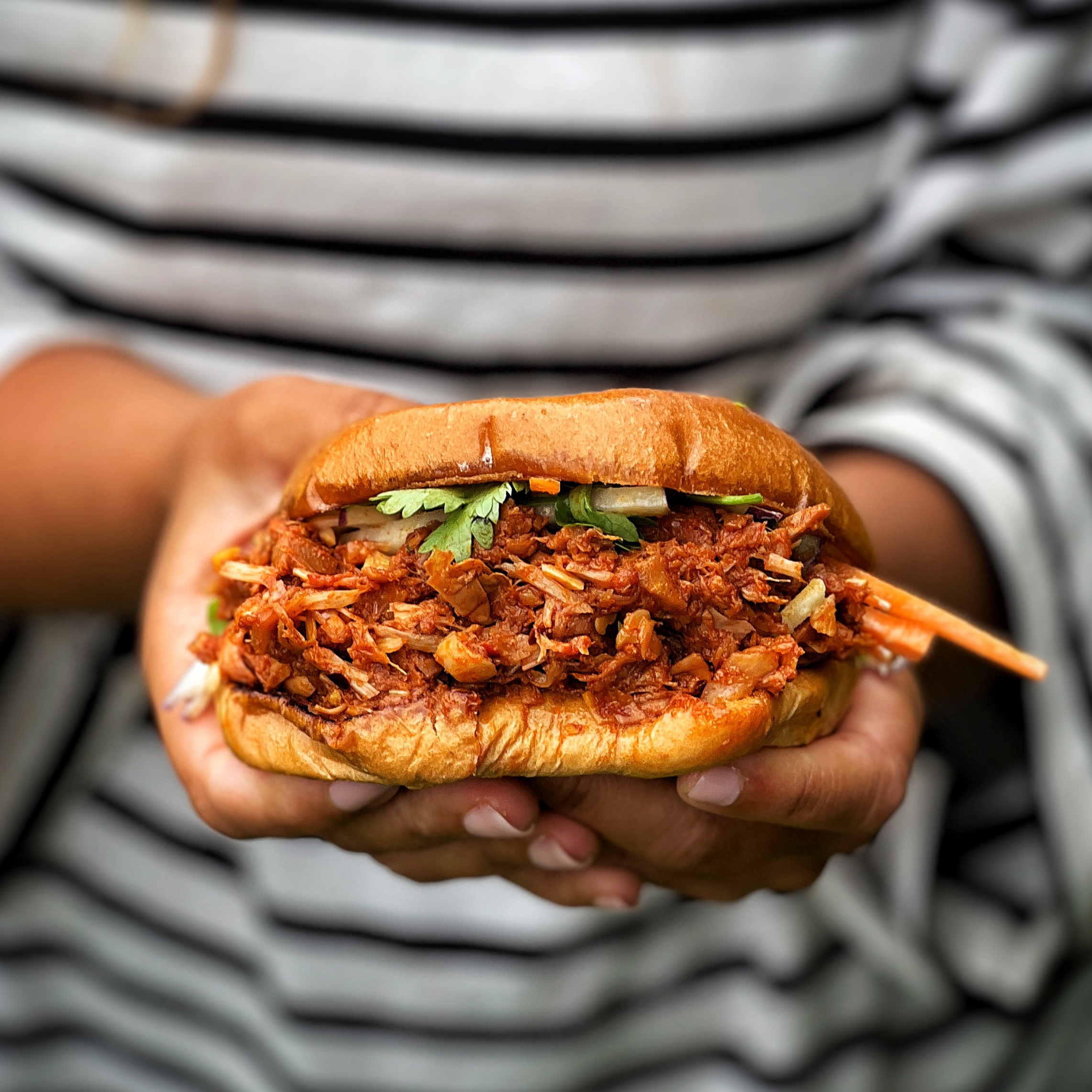
Pulled Jackfruit and slaw brioche burgers
Takes 20 minutes
Serves 3
Ingredients
- 1 x 400g tin of jackfruit
- ¼ portion of vegan coleslaw (see recipe below)
BBQ sauce
- 2 tbsp smoked paprika
- 3 cloves of garlic (crushed)
- 4 tbsp tamari (soya sauce)
- 2 tbsp tomato puree
- 2 tbsp cider vinegar
- 2 tbsp oil
- 2 tbsp maple syrup (agave syrup)
- ½ tsp chilli powder (optional)
For the coleslaw
- 250 g kohlrabi (red cabbage)
- 1 medium carrot
- ⅓ red onion
- 1 apple
- 100 g vegan mayo
- 15 g of fresh flat leaf parsley (coriander)
To serve
- Vegan mayo
- Pickled red onions
- Handful of fresh rocket leaves
- 4-6 brioche burger buns
- 1 ripe avocado
Instructions
- Prepare the Jackfruit:Using a sharp knife, shred the jackfruit into thin strips (easiest to use your hands). Transfer to a colander, rinse under cold water, and squeeze it to dry out, so it fries better.
- Make the BBQ Sauce:Put all the ingredients for the BBQ sauce into a bowl and mix well using a fork. Add the jackfruit to the sauce and mix thoroughly to coat (using your hands works best). Leave to marinate while you prepare the slaw.
- Prepare the Slaw:Cut the kohlrabi (or red cabbage), carrot, and apple into thin batons (about ½cm x ½cm x 5cm).Slice the red onion into thin, half-moon strips. Finely dice the parsley or coriander.Mix together the kohlrabi, carrot, apple, onion, and parsley in a bowl. Add a pinch of salt, then stir in the vegan mayo. Taste and adjust the seasoning as needed.
- Cook the Jackfruit:Heat a frying pan over high heat and add 1 tablespoon of oil. Once hot, add the marinated jackfruit and fry for 6-8 minutes, stirring regularly until it begins to char around the edges. Remove from the heat.
- Prepare the Toppings:Slice the avocado in half, remove the stone, and scoop out the flesh. Slice the avocado into thin slices.
- Assemble the Burgers:Toast the burger buns. Spread a generous dollop of vegan mayo on the bottom half of each bun.Add a healthy serving of the 'pulled pork' jackfruit on top of the mayo, followed by a couple of spoonfuls of the slaw.Top with rocket leaves, pickled red onions, and avocado slices. Finish with the top bun.Serve and enjoy!
Nutrition
The Happy Pear Podcast
Get ready to dive into a sea of inspiration and good vibes as we bring you a thrilling episode with the incredible Easkey Britton! A true force of nature, to explore her remarkable journey as an adventurer, big wave global champion surfer, author, scientist, mother and environmental activist.
Episode 128
Easkey Britton is no ordinary surfer; she’s a true pioneer, paving the way for women in the world of big wave riding. With an infectious zest for life and a deep love for the ocean, Easkey has made significant waves both on and off the surfboard. As an environmental scientist and advocate, she utilizes her passion for the ocean to raise awareness about marine conservation and the importance of connecting with nature.
During this episode, we delve into the world of water, it’s diverse and healing nature and it’s interconnectedness with all life. Easkey also shares her thrilling experiences of riding giants and her unyielding pursuit of breaking boundaries in a traditionally male-dominated sport.
Beyond her achievements in the water, Easkey is also an author, and she enlightens us about her latest book, “Ebb & Flow.” This transformative work invites readers on a journey of self-discovery through the lens of nature’s wisdom, exploring the interconnectedness between our internal landscape and the natural world.
Prepare to be captivated by Easkey’s infectious enthusiasm as she talks about her efforts to create positive change in the world, whether it’s through championing gender equality in sports, promoting sustainable practices, or nurturing the relationship between mental health and nature.
A beautiful conversation, which will inspire you to head to your closest body of water and jump in!
Lots of Love,
Dave & Steve
This episode is sponsored by Air Up. This revolutionary water bottle that will blow your mind and get you drinking tons more water, have given our listeners an exclusive 10% discount when you enter the code HAPPYPEAR10
Produced by Sean Cahill & Sara Fawsitt
Available now from all good podcast providers:
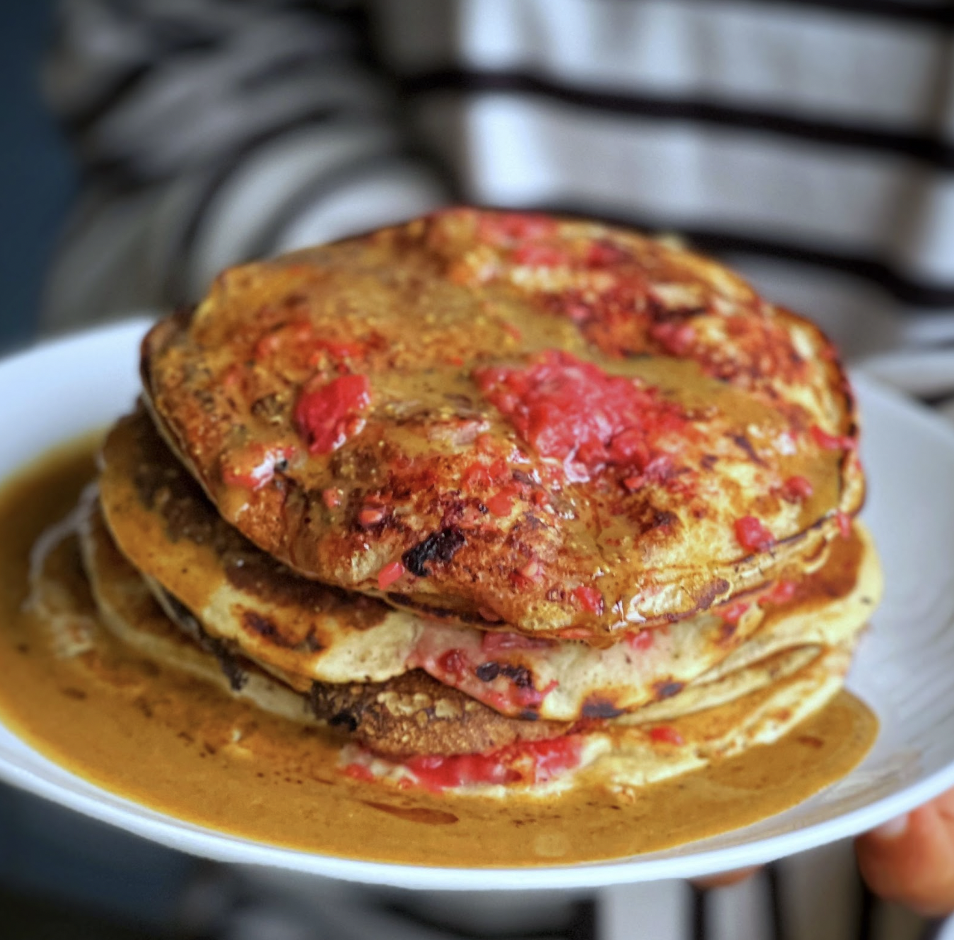
Raspberry Ripple pancakes
Takes 11 minutes
Serves 2
Ingredients
- 120 g self raising flour
- 210 ml oat milk (or any milk of choice)
- 2 tbsp peanut butter (or almond butter)
- 2 tbsp maple syrup
- Small pinch of salt
- ½ tsp vanilla extract
- 250 g raspberries
- Spray oil
To Serve
- Maple syrup
- Peanut butter (or almond butter)
Instructions
- Prepare the Batter:In a bowl, whisk together the flour, oat milk, peanut butter, maple syrup, salt, and vanilla extract until smooth. Alternatively, use a blender for an extra smooth consistency.
- Heat the Pan:Heat a non-stick pan on high heat. Once the pan is hot, reduce to medium heat.
- Cook the Pancakes:Lightly spray the pan with oil. Pour a small amount of the batter into the pan to form a pancake.Gently press 5-6 raspberries into the batter on top.
- Flip and Cook:Cook the pancake until bubbles form on the surface and the edges begin to dry out, about 2-3 minutes.Flip the pancake and cook for another 1-2 minutes, until golden brown and cooked through.Continue cooking the rest of the batter in batches, stacking the pancakes as you go.
- Serve:Drizzle the pancakes with runny peanut butter and maple syrup for a delicious finish. Enjoy!
The Happy Pear Podcast
This week we have the pleasure of hosting our friend, Harrison Gardner, an acclaimed Australian eco builder. Harrison’s expertise in sustainable construction and his passion for plant-based living converge as we explore the intersection between eco-building and embracing a plant-powered lifestyle.
Episode 127
Harrison Gardner’s credentials as an eco builder establish him as a leading authority in sustainable living practices. With a profound commitment to minimizing environmental impact, he has dedicated his career to promoting eco-friendly construction methods and inspiring others to build consciously. As an author, his book “Build Your Own” has become a go-to resource for individuals seeking to create sustainable homes and communities.
Throughout this conversation, we delve into Harrison’s personal journey and the transformative power of eco-building. His experiences and insights inspire us to consider how the spaces we inhabit can align with our values of sustainability and well-being. We explore the principles of eco-building, highlighting the use of renewable materials, energy-efficient designs, and innovative technologies that foster harmony between human habitation and nature.
Within the context of eco-building, Harrison shares his wisdom on the importance of a plant-powered lifestyle. We uncover how conscious choices in our diet and lifestyle can further enhance sustainability efforts and promote holistic well-being. Harrison’s book, “Build Your Own,” serves as a comprehensive guide, illustrating how nutrition and eco-building intertwine to create a harmonious and sustainable future.
Drawing from his extensive knowledge, Harrison dives into the practical aspects of eco-building. We discuss the essential steps involved in constructing eco-friendly homes, from site selection and material sourcing to energy-efficient systems and waste reduction strategies. His expertise shines through as he offers valuable advice on how to navigate the complexities of sustainable construction, empowering individuals to build homes that reflect their values and contribute to a greener world.
Throughout the episode, Harrison shares captivating anecdotes and practical tips from his book, “Build Your Own.” This invaluable resource acts as a roadmap for aspiring eco builders, providing them with the tools and inspiration needed to embark on their own sustainable building projects. From designing with nature in mind to incorporating renewable energy solutions, Harrison’s book serves as a beacon of knowledge for anyone interested in creating a positive impact through eco-building.
Listen to this episode and discover the profound connections between sustainable construction, plant-powered living, and the steps we can take to create a brighter, greener tomorrow.
Lots of Love,
Dave, Steve & The Happy Pear Team
This episode is sponsored by Vivobarefoot Footwear. Vivobarefoot Footwear have given our listeners an exclusive 15% discount when you enter the code HAPPYPEAR15
Genuinely these are the only shoes you will see Dave & Steve wearing!
Produced by Sean Cahill & Sara Fawsitt
Available now from all good podcast providers:
This is so tasty, low in fat and really easy to make. We make 3 components, a lentil curry, a coriander cream and a pickled spicy cucumber, that looks like watermelon to bring a well rounded nourishing meal. Serve with your favourite grain of choice or a wholemeal flatbread. This is a recipe from our Happy Shape course to help you reach your happy shape with Dr Sue Kineally and Dietician Rosie Martin.

Summer lentil Dal with pickle cucumber and coriander cream
Takes 30 minutes
Serves 4
Ingredients
- 1 red onion
- 1/2 thumbsize ginger
- 1/2 red chilli
- 2 courgettes
- 500 g lentils
- 400 g tinned chopped tomatoes
- 1.5 litre water
- 2 tbsp tamari
- 1 tsp ground cumin
- 1 tsp ground turmeric
- 2 tsp ground coriander
- 1/3 tsp ground cinnamon
- 1 tsp salt
- 1/4 tsp black pepper
Cucumber Pickle
- 1/4 cucumber
- 1/2 red chilli
- 100 ml clear vinegar
- 1/2 fresh beetroot grated
- pinch salt
Coriander Cream
- 15 g fresh coriander
- 200 ml soy yoghurt
- 1/2 lime juice
- pinch salt
Instructions
- First step let's make the pickle. Slice the cucumber in half lengthwise and then slice into 1/2 cm slices. Add to a glass along with a pinch of salt and cover with the vinegar. Grate the beetroot and squeeze the juice into the vinegar to colour the pickle. You only want the juice and not the beetroot flesh (you may want to wear a glove here as the beetroot is so high in antioxidants that it will colour your hand). Mix well and leave the pickled to infuse while you make the Dal.
- Peel and finely dice the red onion and ginger. Finely dice the ½ chilli leaving the seeds in if you prefer it spicier or removing them if you prefer it less hot. Slice the courgettes into half moon shapes that are approx ½ cm thick
- Heat a large saucepan on high heat and once hot add in the onion and ginger and chilli and fry for 4-6 mins until it starts to brown. If it starts to stick, add in 2 tbsp of water to deglaze the pan and incorporate any stuck bits, You may have to do this more than once depending on your pan.
- Next add in the sliced courgettes along with the spices (ground coriander, ground cumin, turmeric, cinnamon, salt and pepper) and cook together for 3-4 mins allowing the courgettes to brown slightly.
- Add in the tin of chopped tomatoes, lentils, water and the tamari/ soy sauce and mix well. Bring to a boil and continue to cook for 15-20 mins until the lentils are cooked. You will have to stir regularly to avoid the lentils sticking.
- While the lentils are cooking make the coriander cream. Finely dice the coriander and add to the yogurt and mix with a pinch of salt and the juice of ½ lime. Mix well and set aside.
- Once the lentils are cooked add the juice of ½ a lime to them and season the dish by adding more salt, ground black pepper or lime juice to your liking.To serve, add a generous serving of dal, along with some coriander cream and some pickled on top! Enjoy, this is so tasty!
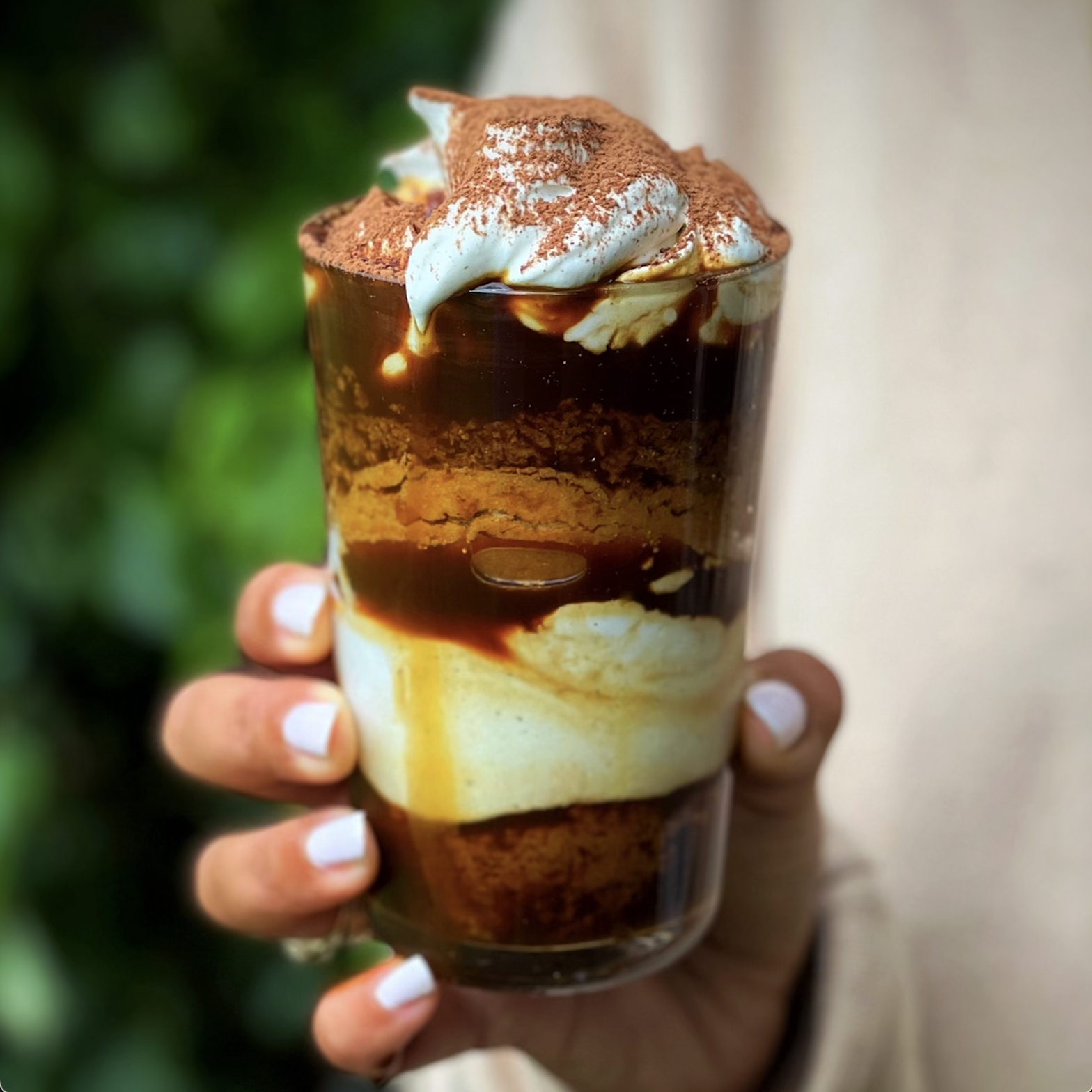
Tiramisu affogato
Takes 7 minutes
Serves 2
Ingredients
- 2 shots espresso
- 2 tbsp icing sugar
- 1 tbsp brandy (optional)
- 200 g cream cheese
- 100 ml plant-based cream
- 4 tbsp icing sugar
- 150 g vanilla ice cream (plant-based)
- 2 vegan scones
- 1 tbsp cocoa powder
Instructions
- Prepare 2 x 300 ml clear glasses. Cut the scones in half horizontally (across the middle), then cut each half so they neatly fit into the glasses. You should have 4 scone pieces to layer.
- Mix together the espresso, icing sugar, and brandy (if using), then set aside.
- In a separate bowl, mix the cream cheese, cream, and icing sugar. Whip until thick and creamy. Taste and add more icing sugar if you want it sweeter.
- Take your glasses and place one piece of scone at the bottom. Coat it with the coffee mixture so that the scone is soaked.
- Add a generous scoop of vanilla ice cream (approximately 35 ml) on top of the soaked scone and spread it to the edges.
- Place the second piece of scone on top and soak it with the coffee mixture. Finally, cover it with the cream cheese mixture, filling the glass to the top.
- Sprinkle cocoa powder over the top and enjoy!
Sample Lesson: Cognitive Health
Oestrogen levels can affect word recall, memory and so called ‘brain fog’ symptoms, and having levels that are both too low or indeed too high in some people can mean the sweet spot is hard to find. For some, HRT helps. Regular physical activity and spending time in nature helps, as well as prioritising sleep, trying out breathwork and meditation and avoiding alcohol. Learning new skills and managing stress are also useful.
Sample Lesson: Menopause 101 – also includes Perimenopause
Women are usually born with two ovaries (egg containing baskets or organs) although one can go through life with no repercussions if there is only one functioning ovary. Each ovary contains a huge number of eggs, in fact thousands which reduce in number over time through a process of natural loss every month. There is no way to increase or reduce this natural loss of eggs. Only a few hundred eggs are used in a woman’s lifetime. After the onset of puberty, the ovary releases an egg most months, a process known as ovulation.
Sample Lesson: What about Calcium?
Calcium is an important mineral for human survival. It is needed, as you probably already know, to keep our bones and teeth strong and healthy. Small amounts of calcium are also required for nerve function, to relax our muscles and for blood clotting.
Before the domestication of dairy cows was commonplace, many human populations evolved without dairy in their diet, consuming all the calcium they required from plants. Due to the artificial selection of sweetness, rather than nutritional content, many of the plant foods we consume today have lower levels of calcium than that of their ancestors.
Sample Lesson: Benefits of Soya in Menopause
A randomised controlled trial showed fantastic results showed Just 1/2 cup or 86 g of mature soya beans providing 55 to 60 g of isoflavones was associated with reduced frequency and severity of hot flushes by 84% and improved quality of life in vasomotor, psychosocial, physical, and sexual symptoms in postmenopausal women when followed for just 12 weeks. The women involved in this study were following a completely plant based diet during this time.
The Happy Pear Podcast
In the latest we sit down with Dr Rupy Aujla in person, founder of The Doctor’s Kitchen, to chat about all things food and health.
Episode 126
Dr Rupy Aujla is not your typical physician – he’s a passionate advocate for the role of food in preventing and managing chronic diseases, and has made it his mission to inspire and empower people to use food as medicine. With a background in general practice and emergency medicine, Dr Rupy has witnessed first-hand the impact of lifestyle choices on health outcomes, and believes that good nutrition is the foundation of good health.
Dr Rupy shares some fascinating insights into the science behind food and health, and offers practical tips on how to incorporate more plant-based foods into your diet. He also talks about his latest book, “Eat to Beat Illness”, which explores the links between diet and disease, and provides evidence-based advice on how to eat for optimal health.
Overall, this episode is a must-listen for anyone interested in the intersection of food and health, and is sure to leave you feeling inspired and motivated to make positive changes in your own life. So grab a cup of tea, sit back, and enjoy the conversation!
Lots of Love,
Dave, Steve & The Happy Pear Team
This episode is sponsored by Air Up. This revolutionary water bottle that will blow your mind and get you drinking tons more water, have given our listeners an exclusive 10% discount when you enter the code HAPPYPEAR10
Produced by Sean Cahill & Sara Fawsitt
Available now from all good podcast providers:
One of our most popular videos on instagram was a shawarma – here we make an umami spiced ketchup and marinate some oyster mushrooms which we skewer and char until they are so magnificent, serve with a tahini yogurt cream, spicy tabbouleh and pickled red onions, these are so tasty!
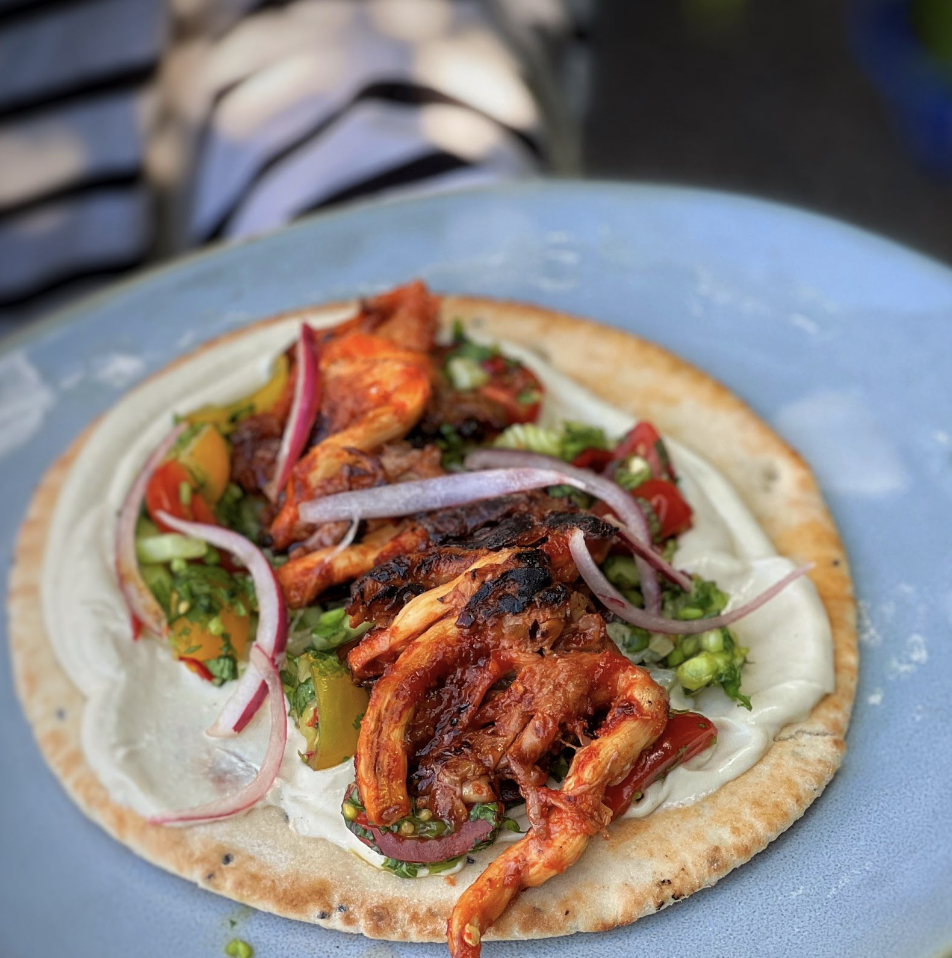
Mushroom Shawarma skewers on flat breads
Takes 25 minutes
Serves 2
Ingredients
- 200 g oyster mushrooms
Umami Ketchup Sauce
- 3 tbsp tomato puree
- 1.5 tbsp maple syrup
- 2 tbsp apple cider vinegar
- 1/2 tsp garlic powder
- 1/3 tsp salt
- 2 tbsp Tamari
Tahini cream
- 200 g natural soy yoghurt
- 100 g light tahini
- 1/2 tsp garlic powder
- 1/2 lemon juice
- pinch of salt
Pickled red onions
- 1/2 red onion
- 75 ml apple cider vinegar
- pinch of salt
2 flat breads
Instructions
- First let's pickle the red onion, peel and finely slice the red onion into long thin slices and add to a glass along with the salt and vinegar, ensuring all the onion is submerged in the vinegar.
- Mix together all the umami ketchup ingredients and mix well, taste and adjust the seasoning and spiciness to your liking. Take the oyster mushrooms and rip the larger ones in half lengthwise and add to a bowl along with ¾ of the umami ketchup and mix well, and leave to marinade for 5 mins while you make the tabbouleh and tahini cream.
- For the tabbouleh quarter the cherry tomatoes, finely dice the cucumber, lettuce and coriander and add them all to a bowl, finely dice the chilli, include the seeds if you prefer it spicy or discard if too spicy and add to the bowl. Add a generous pinch of salt and mix well, taste and adjust the seasoning to your liking.
- For the tahini cream, mix together all the ingredients with a fork until it comes together into a thick creamy delicious looking sauce, not that unlike mayonnaise. Taste and adjust the seasoning to your liking. If its too thick add a little more yogurt and if it's too thin add a little more tahini, you want it like mayo like consistency.
- Carefully thread the mushrooms onto 2 skewers, heat a frying pan or griddle pan on high heat and add 1.5 tbsp of oil. Once hot, reduce to a medium heat, add the mushroom skewers and cook on all sides until they start to char. Use a pastry brush to brush on more of the sauce to ensure an even coating where the sauce almost glazes the outside of the mushrooms.Once the mushrooms are lightly charred all over remove from the heat.
- To serve, heat up the flat breads and add a generous dollop of tahini cream on the base, followed by lots of tabbouleh, remove the mushrooms from the skewer on top and finely add some pickled red onion on top – enjoy!
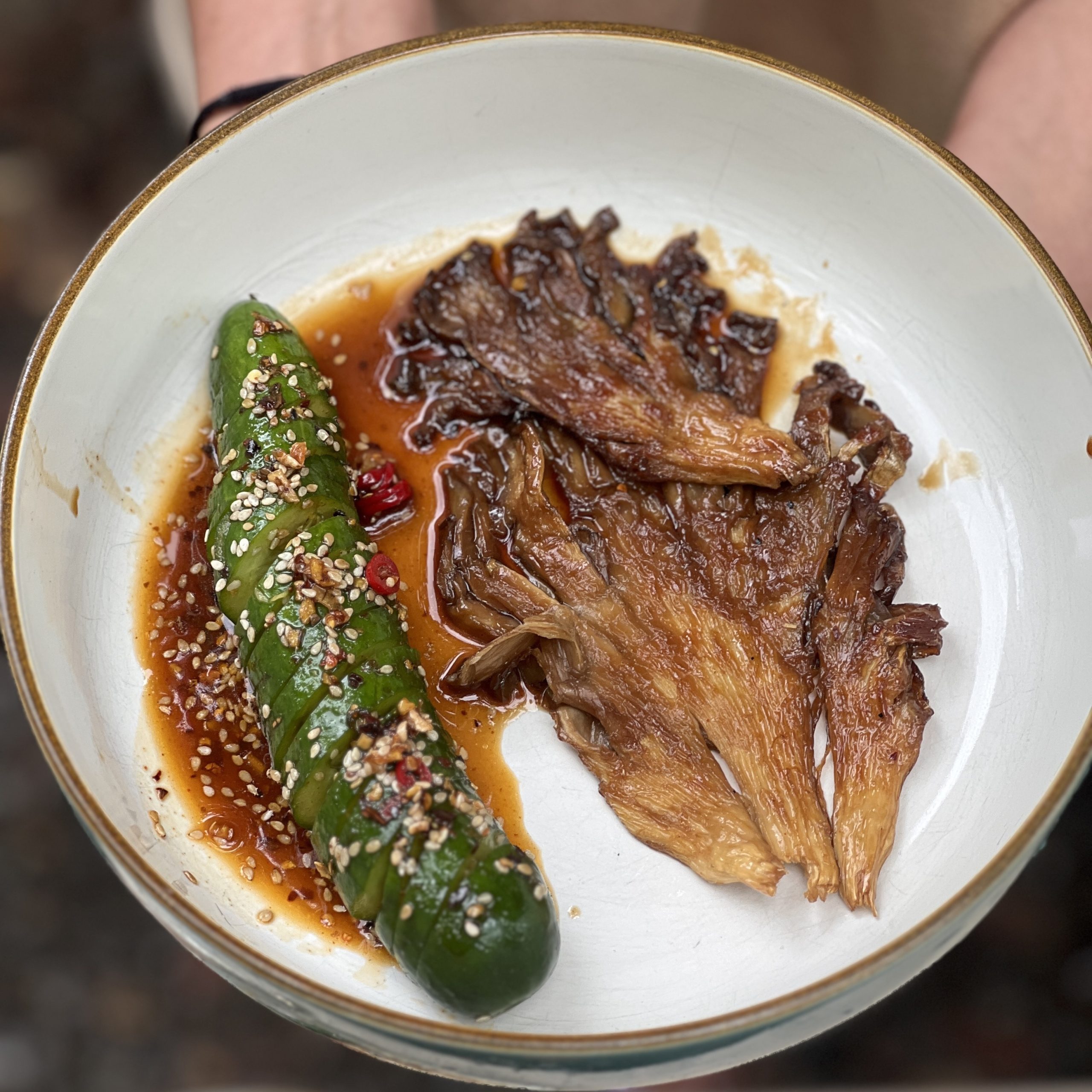
Oyster mushroom Steaks with ginger and sesame cucumbers
Takes 17 minutes
Serves 1
Ingredients
- 200 g oyster mushrooms
- 2 tbsp sesame oil
- 1 tbsp apple cider vinegar
- 1.5 tbsp tamari
- 1.5 tbsp maple syrup
- ¼ thumbsize ginger
Cucumber Salad
- 1 tbsp sesame oil
- 1 tbsp tamari
- 1 tbsp maple syrup
- 1 tbsp brown sugar
- 1 tsp chilli flakes
- 1 clove garlic
- ¼ thumbsize piece of ginger
- 2 cucumbers
Instructions
- Prepare the Cucumber Salad:Slice the cucumbers into ½ cm slices. Finely dice the garlic and ginger, then mix them with the remaining cucumber salad ingredients (sesame oil, tamari, maple syrup, brown sugar, and chilli flakes). Transfer the sauce to a saucepan and heat over high heat. Bring to the boil, then reduce to a low heat and simmer for 3-4 minutes, stirring continuously until the sauce thickens. This will help it coat the cucumbers better. Set the sauce aside to cool while preparing the mushroom steaks.
- Make the Mushroom Steak Marinade:In a small bowl or glass, mix 1 tbsp sesame oil, apple cider vinegar, tamari, maple syrup, and the finely diced ginger. Set this marinade aside.
- Cook the Mushroom Steaks:Heat a non-stick pan over high heat and add 1 tbsp sesame oil. Place the oyster mushrooms in the pan in a single layer, ensuring they have enough space to fry. Use a wooden spoon or spatula to press the mushrooms down so they brown evenly and release some of their moisture. Cook for 2-3 minutes on each side until the mushrooms start to brown.
- Add the Sauce:Once the mushrooms are browned, carefully add enough of the prepared sauce to lightly coat the mushrooms. Avoid adding too much sauce to prevent the mushrooms from becoming too soggy. Cook for another 1-2 minutes until the sauce is absorbed and the mushrooms look caramelised. Repeat with any remaining mushrooms, if necessary.
- Plate and Serve:Toss the cucumber slices with the cooled cucumber sauce, ensuring they are well coated. Divide the cucumber salad between two plates and serve the mushroom steaks alongside. Enjoy!
The Happy Pear Podcast
This week we speak to Jane Esselstyn! Jane brings her perspective and passion as a nurse, researcher, mother, and teacher to the forefront of the plant-based movement. Author and co-author of NY Times Bestseller Be a Plant-Based Woman Warrior: Live Fierce, Stay Bold, Eat Delicious, and The Prevent and Reverse Heart Disease Cookbook, Jane presents her work, research, and high energy demos around the world- and on her new YouTube channel with her mum, Ann Esselstyn.
Episode 125
Women, families and community drive Jane’s work forward. She is the host of the annual conference, Prevent and Reverse Heart Disease for Women, which is focused on the power of plants! Jane claims, “Prevention is the new cure, and the most powerful, relevant, and protective medicine available”. With full enthusiasm, Jane co-founded Well, Now! Camp – an activity -filled, creative escape for Plant-Based Women Warriors .
In this lively conversation, Jane shares her wealth of knowledge and passion for healthy, plant-powered lifestyles, providing listeners with practical tips and empowering insights along the way.
Throughout the episode, Jane delves into the practical aspects of adopting a plant-based lifestyle, offering invaluable advice. Aside from talking plants, we also dive deep into the area of sex education, a big jump from plant-based eating you might think! However, Jane has worked as a sex educator for a number of years and shares some brilliant insights on how the topic should be explored.
As a renowned author and speaker, Jane has dedicated herself to empowering individuals on their journey towards better health. Her warm and relatable approach makes the path to wellness accessible and enjoyable for all. This episode will leave you feeling inspired, informed, and hopefully ready to embark on your own transformative health journey.
Lots of Love,
Dave, Steve & The Happy Pear Team
To learn more about Jane and her work visit: https://janeesselstyn.com/
This episode is sponsored by Vivobarefoot Footwear. Vivobarefoot Footwear have given our listeners an exclusive 15% discount when you enter the code HAPPYPEAR15
Genuinely these are the only shoes you will see Dave & Steve wearing!
Produced by Sean Cahill & Sara Fawsitt
Available now from all good podcast providers:
The Happy Pear Podcast
We’re thrilled to share some exciting news with you – we are giving you, our community, the chance to join us on the journey as co-owners of The Happy Pear.
We’re selling 18.9% ownership of The Happy Pear to our community as part of our very first Crowd Investing Campaign.
Episode 124
We have been helping people make healthier food choices that are kinder to them and the planet since starting The Happy Pear over 19 years ago. And now, we’re inviting you to be part of this journey as a co-owner.
Our mission in the last 19 years has not changed! Our aim is to create a happier, healthier world and build community which is more relevant than ever today.
And now, we’re offering you a chance to be part of this journey as a co-owner.
In this episode we provide you with the behind the scenes of how and why The Happy Pear started, from a small fruit and veg shop to the business it is today. We talk through the successes and our future vision.
Want to find out more? Visit https://thehappypear.ie/invest/
Come Join the Fruit & Veg Revolution 😉
Lots of Love,
Dave, Steve & The Happy Pear Team
This episode is sponsored by Vivobarefoot Footwear. Vivobarefoot Footwear have given our listeners an exclusive 15% discount when you enter the code HAPPYPEAR15
Genuinely these are the only shoes you will see Dave & Steve wearing!
Produced by Sean Cahill & Sara Fawsitt
Available now from all good podcast providers:
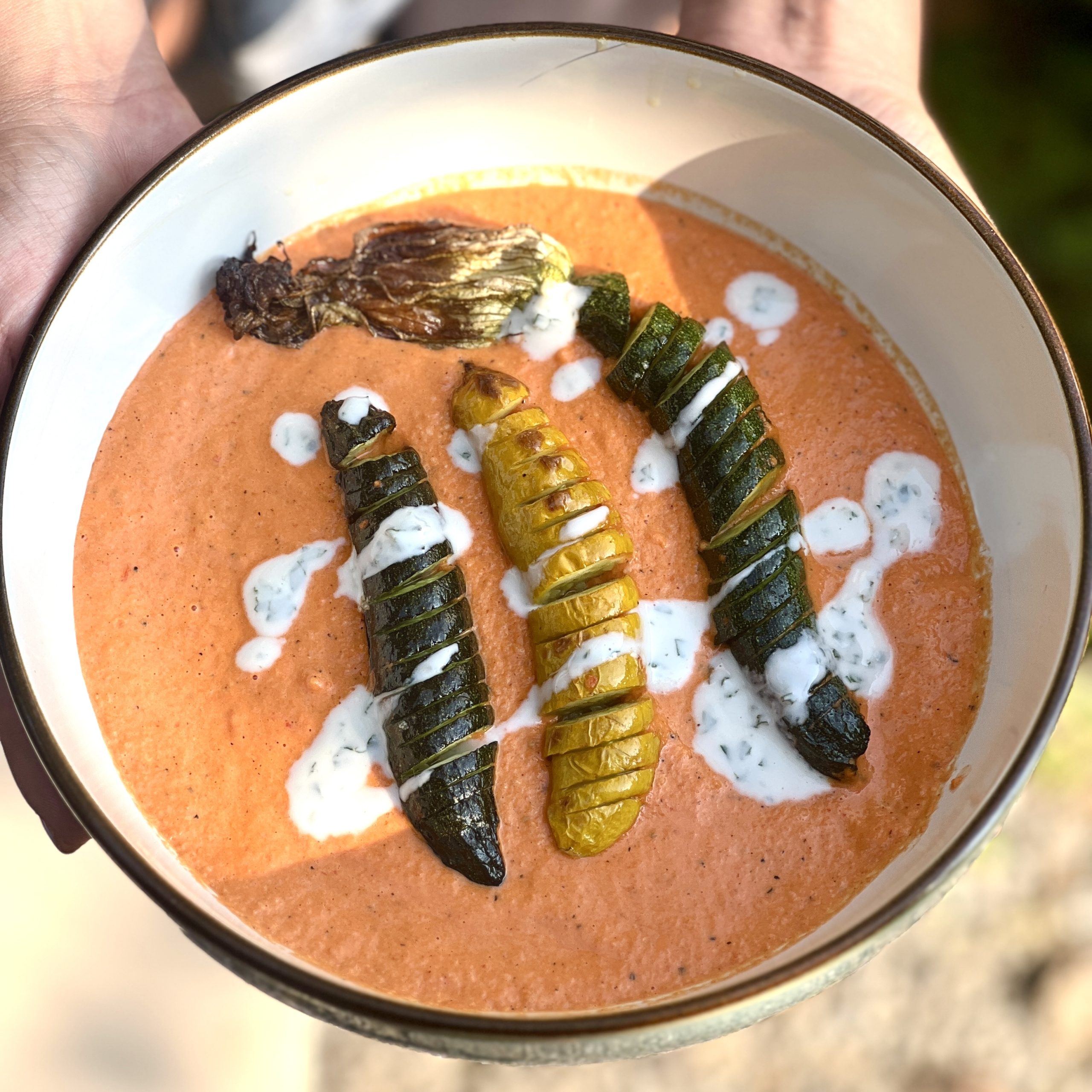
Courgette Hasselback With Romesco Sauce And Mint Yogurt
Takes 35 minutes
Serves 2
Ingredients
- 2 medium courgettes
Romesco Sauce
- 1 x 220g jarroast red pepper
- 1 clove garlic
- 100 g blanched almonds
- 8 tbsp olive oil
- 1 tbsp vinegar
- 2 tsp salt
- Pinch of ground black pepper
Yoghurt Sauce
- 250 g coconut yoghurt
- 10 g fresh mint
- 2 tbsp tahini
- Juice of 1/2 lemon
- Pinch of salt
Instructions
- Preheat the Oven:Preheat the oven to 200°C.
- Prepare the Courgettes:Slice each courgette 3/4 of the way through, spacing the slices approximately 1/2 cm apart to create a Hasselback effect. Place the courgettes on a baking tray, brush with 2 tablespoons of olive oil, and sprinkle with a generous pinch of salt. Ensure some oil gets between the slices. Bake for 20 minutes.
- Make the Romesco Sauce:While the courgettes are baking, peel the garlic cloves and add them to a food processor along with the roasted red peppers, blanched almonds, olive oil, vinegar, salt, and black pepper. Blend until smooth. Taste and adjust the seasoning if needed.
- Prepare the Yoghurt Sauce:Remove the mint leaves from the stalks and finely chop them. In a bowl, combine the mint, coconut yoghurt, tahini, lemon juice, and a pinch of salt. Mix well and adjust the seasoning to taste.
- Check the Courgettes:After 20 minutes, check on the courgettes. Open up some of the slices and add a little more oil if necessary to help them turn golden inside. Bake for a further 5 minutes, or until the courgettes are soft, slightly charred, but still holding their shape.
- Serve:In two bowls, spread a generous layer of Romesco sauce at the base. Place a courgette on top of each, then drizzle with the yoghurt sauce for a lovely finish. Enjoy!
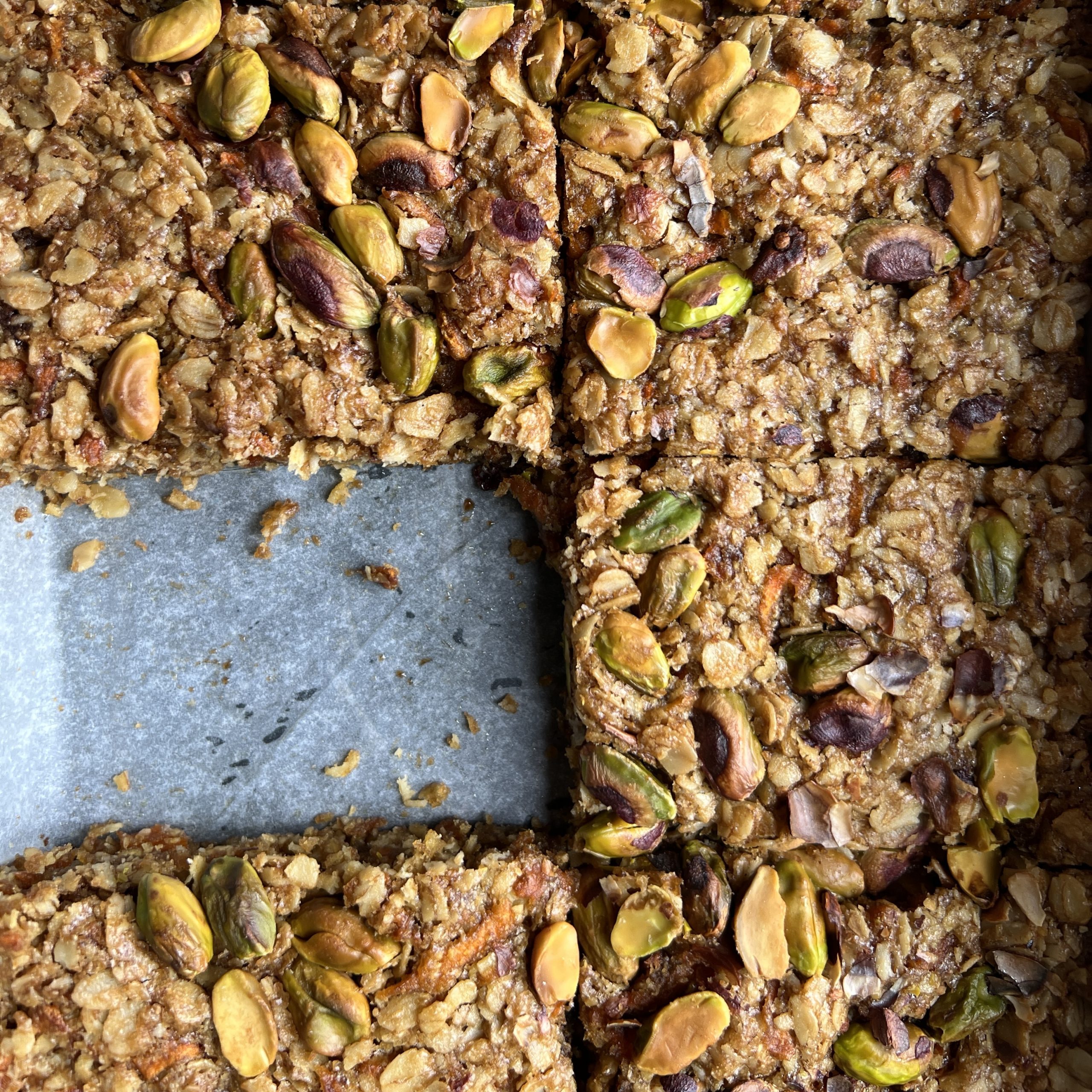
Carrot Flapjacks
Takes 45 minutes
Serves 12
Ingredients
- 200 g jumbo oats
- 100 g carrot (grated)
- 75 g flour
- 150 ml vegetable oil
- 50 ml maple syrup
- 125 g brown sugar
- 200 g pistachios
Instructions
- Preheat the oven to 160°C.
- Finely grate the carrot into a bowl, add a tiny pinch of salt, and mix. Transfer the grated carrot to a sieve and squeeze out any excess juice.
- Remove the shells from the pistachios and roughly chop them.
- In a bowl, mix together the dry ingredients: oats, flour, brown sugar, and pistachios. Make a well in the centre.
- In another bowl, mix together the wet ingredients: vegetable oil, maple syrup, and the grated carrot.
- Add the wet ingredients to the dry ingredients and mix well.
- Line a 28 x 18 cm brownie tray with parchment paper. Add the flapjack mixture, pressing it into the corners and flattening it with the back of a spoon. Ensure it is well compacted but not overly pressed.
- Bake for 30 minutes at 160°C (for a crispier flapjack, bake at 180°C for 30 minutes).
- Remove from the oven and allow to cool for 10 minutes. While still in the tray, portion the flapjack into 16 squares (or your preferred size) using a knife. Allow it to cool fully before removing from the tray. It is very important to let the flapjacks cool completely to ensure they hold their shape.
- Store in an airtight container and enjoy! We don’t actually know how long they last beyond 7 days at room temperature, as they are always eaten before then.
The Happy Pear Podcast
This week we welcome a very special guest, the remarkable Ed Winters, also known as Earthling Ed. Ed is a prominent figure in the animal rights and veganism movement, whose passion and dedication have touched the lives of many.
Episode 123
In this episode, we dive deep into his inspiring journey, explore his impactful advocacy work, and uncover the strategies he employs to spread compassion and create a kinder world for animals.
Ed’s impressive credentials include speaking engagements at conferences and universities, captivating TEDx talks, and appearances in mainstream media. His extensive experience and knowledge have made him a respected voice within the movement.
We delve into Ed’s personal experiences and pivotal moments that led him on a path of advocating for animals. Through his deep empathy and unwavering commitment, he has shaped a mission to raise awareness and drive positive change. Ed shares his journey, revealing the transformative power of compassion and how it propels his work forward.
One of the strategies that sets Ed apart is his approach to advocacy work. He believes in the power of storytelling and empathy to connect with people on an emotional level. By highlighting the inherent value of all sentient beings, he encourages individuals to reconsider their food choices and embrace a compassionate lifestyle. Ed shares insights into the strategies he finds most effective in inspiring change and empowering others to make a difference.
Throughout the episode, we hear about the impact of Ed’s speeches, presentations, and online content. His ability to captivate audiences and foster genuine connections has left a lasting impression on many. We explore success stories and memorable moments that showcase the profound influence Ed has had on individuals, as well as the broader movement.
Ed’s vision for the future revolves around creating a kinder world for animals and the planet. He believes that compassion can revolutionise our relationship with animals, promote health, sustainability, and ethical choices. By embracing a plant-based lifestyle, we can contribute to a brighter future for all.
Join us as we explore the power of compassion and discover how each of us can play a role in creating a brighter, kinder world for all.
Enjoy!
Lots of love,
Dave & Steve
This episode is sponsored by Vivobarefoot Footwear. Vivobarefoot Footwear have given our listeners an exclusive 15% discount when you enter the code HAPPYPEAR15
Genuinely these are the only shoes you will see Dave & Steve wearing!
Produced by Sean Cahill & Sara Fawsitt
Available now from all good podcast providers:

Easy Pear Tart Tatin
Takes 30 minutes
Serves 6
Ingredients
- 2 pears (ripe)
- 75 g brown sugar (or white sugar)
- 1 sheet puff pastry
Instructions
- Preheat the oven: Preheat your oven to 200°C.
- Prepare the caramel: Use an ovenproof frying pan and add 2 tablespoons of water along with the sugar. Mix until smooth, with no clumps. Place the pan on high heat and do not stir. Bring the mixture to a boil, then reduce the heat to medium and leave it to cook without stirring until the sugar turns a light shade of gold. Remove the pan from the heat.
- Prepare the pears: Slice the pears into long strips. Carefully arrange a single layer of pear slices on top of the caramel (be cautious of the hot pan and caramel). Try to shape the pears into a neat pattern, as this will be the top of your tart.
- Roll out the pastry: Roll out the puff pastry and cut it slightly larger than the pan. Carefully place the pastry on top of the pears, tucking it in around the edges.
- Bake the tart: Put the pan in the oven and bake for 20 minutes, or until the pastry turns golden.
- Flip and serve: Remove the pan from the oven. While the pan is still hot, place a board on top of the pan and flip it over confidently. The tart tatin will now be upright, with the pears and caramel on top and the pastry forming the base. Cut and enjoy!
These are so incredibly tasty and they just taste like you want to eat more! The idea of caramelised banana in a salsa originally sounded like a bit of a joke but once we tried it we knew we were on to something! We make a spicy mayo, smokey spicy mushrooms and an epic caramelised banana salsa served on corn tacos.

Spicy mushroom Tacos with caramelised banana salsa
Takes
Serves 2
Ingredients
Spicy Mayo
- 100 ml plant based mayonnaise
- 1 tbsp smoked paprika
- 1 tsp chilli flakes
Caramelised Banana salsa
- 1 banana
- 100 g cherry tomatoes
- 10 g fresh coriander
- 1/2 red chilli
- 1/2 lime juice
- 1/2 red onion
- 1 tbsp oil
Spicy Mushrooms
- 150 g oyster mushrooms
- 1 tbsp cumin seeds
- 2 tbsp tamari
- 1 tbsp smoked paprika
- 1/2 tsp chilli flakes
To serve
- 4 corn tacos
Instructions
- For the spicy mayo mix together the ingredients until you get a lovely reddy sauce, this makes a delicious base layer to these tacos.
- Heat a non-stick frying pan on high heat and peel and slice the ripe banana in half and then in half lengthwise, giving you 4 pieces. Add them to the hot pan open side down and cook until they caramelise or start to go golden. Reduce the heat to low and cook at a low heat for 3-4 mins allowing them to stew slightly in their own juices. Turn off the heat and leave to cool while you prepare the rest of the ingredients for the salsa.
- Quarter the cherry tomatoes. Finely dice the red onion and coriander (or flat parsley) including the stalk. Peel and finely dice the chilli. Remove the banana from the pan and finely dice. Add all the ingredients for the salsa to the cooled pan and mix to incorporate the banana juices on the pan. Add to a bowl along with the limes juice, oil and pinch of salt. Taste and adjust the seasoning to your liking.
- Heat the same non stick pan on high heat and add 1 tbsp of oil. Rip the mushrooms into long thin stips and add to the hot pan along with the cumin seeds. Use another slightly smaller pan to compress the mushrooms. This will encourage more evaporation and concentration of their flavour as well as giving a better char (just ensure the base of the smaller pan is clean!)
- Cook until they turn brown on the bottom turn this should take anywhere from 2-4 mins and repeat. Add in the tamari and maple syrup and mix through and allow to cook down for 1-2 mins. Remove from the heat. Taste and adjust the seasoning to your liking.Cut the avocado in half remove the flesh and slice into long slices.
- To assemble, get the corn taco, add a generous dollop of spicy mayo, followed by the caramelised banana sala, followed by some avocado slices and lastly the mushrooms on top. Repeat the the remaining ingredients and tacos and enjoy!

Burnt Leek Spaghetti and Miso Salsa
Takes 30 minutes
Serves 2
Ingredients
- 2 leeks (600g)
- 1 tbsp miso
- 15 g flat-leaf parsley
- ½ red chilli
- ½ lemon (juiced)
- 2 cloves garlic
- 3 tbsp olive oil
- 1 tbsp capers (drained)
To serve
- 3 tbsp sauerkraut
- 20 g toasted walnuts (crushed)
Instructions
- Prepare the leeks:Wash the leeks thoroughly to ensure there is no sediment inside the green part.Preheat the oven to 250°C (or, if using a wood-fired oven, light a fire and wait until it reaches 250°C).
- Cook the leeks:Place the leeks, unpeeled, into the oven and cook until the outside is burnt all over. Turn them every 5-7 minutes to ensure an even char. The leeks should be black on the outside (don’t worry!) and soft inside, indicating they are cooked through.
- Make the salsa:While the leeks are cooking, prepare the salsa. Peel and finely dice the garlic, finely dice the red chilli, and chop the flat-leaf parsley.Add the garlic, chilli, parsley, miso, lemon juice, olive oil, and capers to a pestle and mortar or blender. Grind or blend until smooth but with a bit of texture remaining.
- Assemble the dish:Remove the leeks from the oven and allow them to cool for a few minutes so they are easier to handle. Once cool, peel off the burnt outer layer, revealing the soft green insides.Tear the leeks into long strips, resembling spaghetti, and divide them between two plates.Drizzle the salsa over the leeks, garnish with sauerkraut, and sprinkle the crushed walnuts on top.Serve and enjoy!
The Happy Pear Podcast
Dr. Peter Lovatt, also known as “Dr. Dance,” is a renowned psychologist and researcher who has dedicated his career to exploring the relationship between movement and human behavior. He is an expert in the field of dance psychology, and his work has been featured in numerous academic journals and media outlets.
Episode 122
In the latest episode we sit down with Dr. Dance to discuss the many benefits of dance and movement, both for physical health and mental well-being. Throughout the episode, we explore topics such as the connection between movement and creativity, the role of dance in building social connections, and the positive effects of dance on mental health.
With his infectious energy and enthusiasm, Dr. Dance shares his wealth of knowledge and insights on the power of movement to transform our lives. Whether you’re a seasoned dancer or a complete novice, this episode is sure to leave you feeling inspired and motivated to get up and move your body!
So, if you’re looking for some uplifting and informative listening, be sure to check out this episode with Dr. Peter Lovatt, aka “Dr. Dance.”
Lots of love,
Dave & Steve
This episode is sponsored by Vivobarefoot Footwear. Vivobarefoot Footwear have given our listeners an exclusive 15% discount when you enter the code HAPPYPEAR15
Genuinely these are the only shoes you will see Dave & Steve wearing!
Produced by Sean Cahill & Sara Fawsitt
Available now from all good podcast providers:
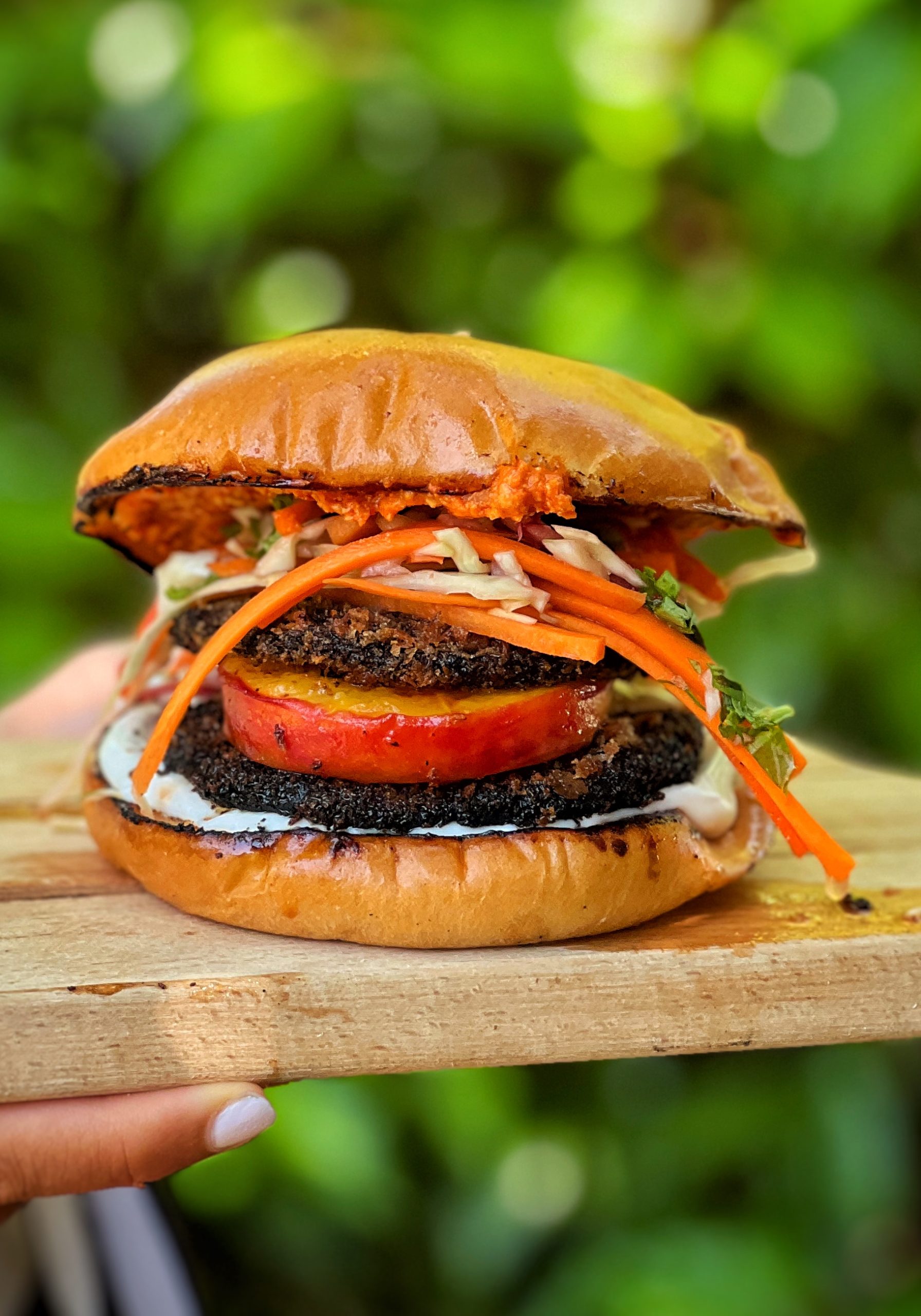
Jerk mushroom, charred peach & Caribbean picklese burger
Takes 43 minutes
Serves 2
Ingredients
- 4 large portobello mushrooms
- 3 tbsp tamari / soy sauce
- 3 tbsp maple syrup (2 tbsp for the mushrooms, 1 tbsp for the peaches)
- 2 tbsp jerk seasoning
- 50 g breadcrumbs
- 3 tbsp oil
- 30 g flour
- 100 ml plant-based milk
- 1 fresh ripe peach
PICKLESE
- 50 g cabbage
- 1/2 carrot
- 1/2 green or red pepper
- 1 small red onion
- 1 clove garlic
- pinch ground clove
- pinch ground cinnamon
- 1/2 tsp black pepper
- juice of 1 lime
- 1/2 tsp salt
- 200 ml vinegar of choice
To serve
- 3 tbsp pesto (we used our spicy red pepper pesto)
- 4 tbsp vegan mayo
- 2 burger bun
Instructions
- Make the Picklese: Finely slice the cabbage or grate it. Finely slice/julienne the carrot, pepper, red onion, and garlic. Dice the chilli, leaving the seeds in if you want more heat. Mix with the salt, black pepper, cinnamon, clove, and lime juice. Transfer the mixture to a jar, cover with the vinegar of choice until fully submerged, and let it pickle while you prepare the other components.
- Prepare the Mushrooms: Heat a non-stick pan on high heat. Once hot, add 1 tsp oil and the mushrooms, ensuring they are well spread out. Compress the mushrooms using another clean pan to help evaporate moisture and concentrate the flavours. Cook for 3-4 minutes on each side until golden.
- Glaze the Mushrooms: Add tamari and maple syrup to the pan and mix until the mushrooms are well coated. Turn off the heat and move the mushrooms around the pan to absorb the glaze evenly on both sides.
- Coat the Mushrooms: Place flour in one bowl, plant-based milk in a second bowl, and breadcrumbs mixed with 1 tsp of jerk seasoning and a pinch of salt in a third bowl. Coat the cooked mushrooms first in the flour, then dip in the milk, and finally coat with the breadcrumbs. Repeat for all mushrooms.
- Fry the Mushrooms: Heat 2 tbsp oil in a non-stick pan on high heat. Once hot, cook the mushrooms for 2 minutes on each side until golden and crispy. Set aside
- Char the Peaches: Cut the peach in half, remove the stone and slice into four pieces. Heat a non-stick pan on high and cook the peach slices for 2 minutes on one side. Add 1 tbsp maple syrup and move the peach slices to coat them evenly. Cook until charred and golden. Remove and set aside.
- Toast the Buns: Toast the burger buns in the pan for 1-2 minutes until golden.
- Assemble the Burgers: Spread vegan mayo on the bottom bun and pesto or ketchup on the top bun. Place a mushroom burger on each bottom bun, followed by 2 slices of charred peach. Top with a generous portion of picklese. Finish with the top bun and enjoy!
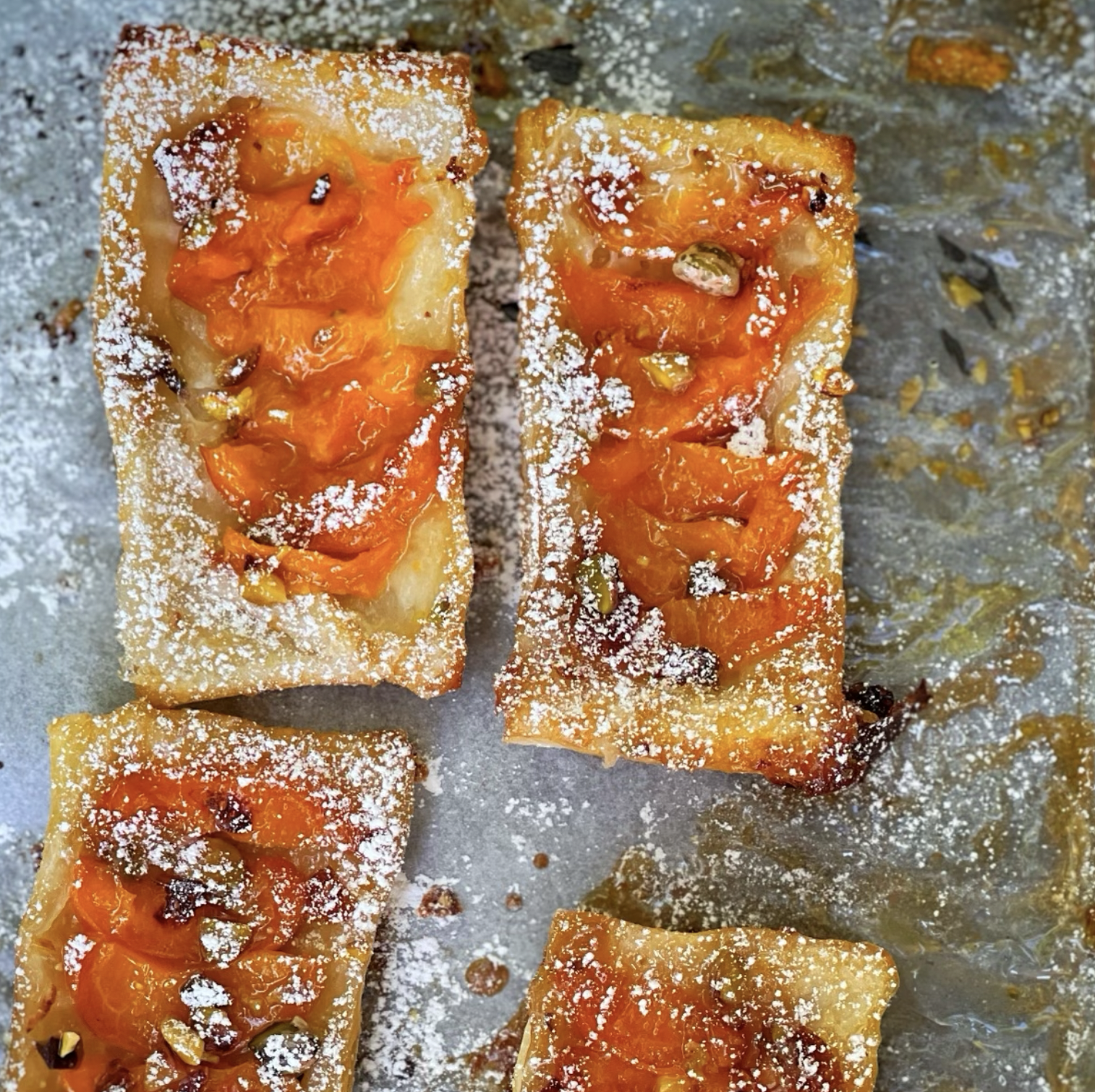
Maple Glazed Apricot and Pistachio Slice
Takes 30 minutes
Serves 4
Ingredients
- 4 apricots
- handful pistachios crushed
- 50 ml maple syrup
- 1 sheet puff pastry
- 20 g icing sugar
Instructions
- Preheat the Oven:Preheat the oven to 180°C.
- Prepare the Baking Tray:Line a baking tray with baking parchment. Drizzle 4 tablespoons of maple syrup onto the parchment in small patches where the pastries will sit.
- Prepare the Pistachios and Apricots:Finely slice the pistachios and sprinkle them over the maple syrup patches. Slice the apricots into approximately 8 slices per apricot and place them on top of the pistachios.
- Prepare the Puff Pastry:Slice the puff pastry sheet into 4 rectangles, each about 12 cm x 6 cm. Place these on top of the maple syrup, pistachio, and apricot layers, pressing down so the maple syrup coats the bottom side of the pastry. If any maple syrup seeps out, brush it on top of the pastry.
- Bake:Place the tray in the preheated oven and bake for 25 minutes until the pastry is golden and crispy.
- Finish and Serve:Remove the tray from the oven and, using a palette knife, carefully lift each slice and flip it over so the apricot side is facing up. Dust with icing sugar using a sieve before serving.
The Happy Pear Podcast
In this weeks’s episode we sit down with Colman Power, a fitness coach and personal trainer with over 20 years of experience in the health and wellness industry. Colman is also an expert in organic horticulture and has a wealth of knowledge to share on growing your own vegetables and herbs.
Episode 121
During the episode, Colman shares his passion for organic gardening and the benefits of growing your own produce. He explains how easy it can be to get started, even if you have limited space or experience. We discuss topics such as companion planting, soil health, and the importance of organic methods in promoting biodiversity and protecting the environment.
But it’s not just about gardening – Colman also provides insights on how to incorporate the fresh fruits and veggies you grow into your meals. He shares his favorite recipes and ideas for making the most of your harvest. He also discusses the importance of functional movement and how gardening can actually be a form of exercise.
A great episode which we had the pleasure of recording in person!
Lots of love,
Dave & Steve
This episode is sponsored by Vivobarefoot Footwear. Vivobarefoot Footwear have given our listeners an exclusive 15% discount when you enter the code HAPPYPEAR15
Genuinely these are the only shoes you will see Dave & Steve wearing!
Produced by Sean Cahill & Sara Fawsitt
Available now from all good podcast providers:
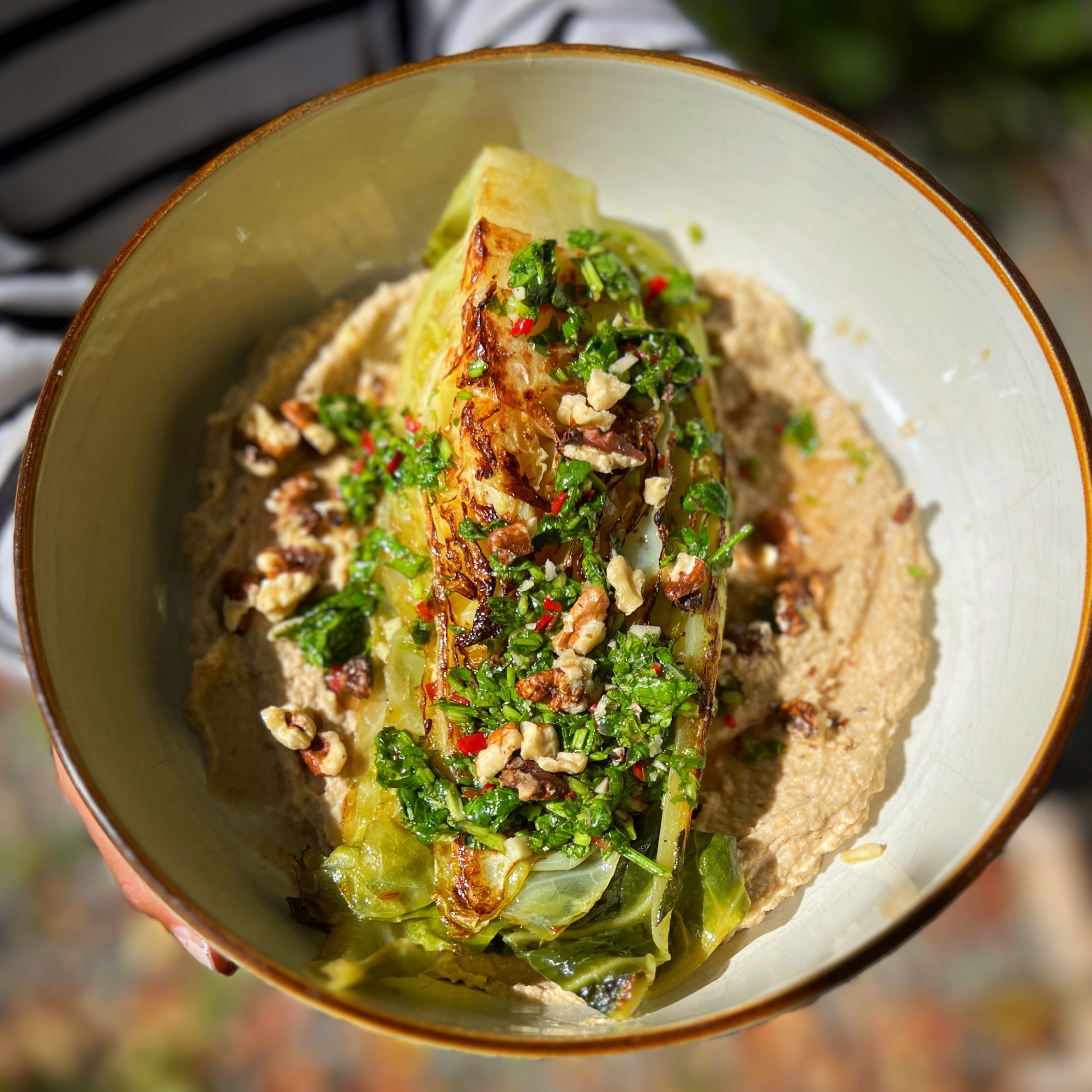
Charred Cabbage with Chimicurri
Takes 30 minutes
Serves 2
Ingredients
- 1 york or pointed cabbage
- 1 tsp pink peppercorns (optional)
- 1 tbsp cumin seeds (optional)
- ½ tsp chilli flakes (optional)
- 3 tbsp oil for frying
Chimichurri Sauce:
- ½ red chilli
- 2 garlic cloves
- 10 g fresh coriander
- 5 g fresh flat-leaf parsley
- 60 ml olive oil
- 40 ml red wine vinegar
- ½ tsp salt
For Serving:
- 180 g caramelised onion hummus
Instructions
- Prepare the Cabbage:Fill and boil the kettle. Cut the cabbage into 4 quarters, ensuring to keep the stalk on each piece so they hold their shape when cooked. Place the cabbage in a saucepan, add a generous pinch of salt, and cover with boiled water. For extra flavour, you can add 1 tsp pink peppercorns, 1 tbsp cumin seeds, and ½ tsp chilli flakes (all optional). Cover the pan with a lid and boil for about 10 minutes, until the cabbage is soft but still holding its shape.
- Make the Chimichurri Sauce:While the cabbage is cooking, prepare the chimichurri sauce. Peel and finely dice the garlic, finely chop the chilli (omit for less spice), and finely chop the parsley and coriander. Add everything to a bowl, along with a pinch of salt, the olive oil, and the red wine vinegar. Mix well and adjust the seasoning to taste. The sauce should be fresh, acidic, and well balanced.
- Char the Cabbage:Drain the cooked cabbage. Heat a frying pan over high heat, add 3 tbsp of oil, and wait until the oil is very hot. Add the cabbage quarters and cook for 3-4 minutes on each side until charred and golden. Sprinkle with a pinch of coarse sea salt while cooking.
- Assemble the Dish:Spread the caramelised onion hummus onto a large serving plate. Arrange the charred cabbage quarters on top, and drizzle or spoon over the chimichurri sauce.
The Happy Pear Podcast
Dr. Kathryn Pinkham is a highly esteemed sleep specialist with over a decade of experience helping people overcome their sleep issues. She is the founder of The Insomnia Clinic, which is a private clinic based in London that offers a range of evidence-based treatments for insomnia and other sleep disorders. Kathryn has also worked with a variety of well-known clients, including professional athletes, business leaders, and celebrities.
Episode 120
During this episode, Kathryn discusses the importance of getting a good night’s sleep and how it can impact our overall health and wellbeing. She shares some helpful tips and tricks for improving our sleep habits, including setting a regular sleep schedule, creating a calming bedtime routine, and avoiding screens before bed.
Kathryn also discuss the impact of stress and anxiety on sleep, as well as the benefits of mindfulness and relaxation techniques for improving sleep quality.
Overall, this episode is a must-listen for anyone struggling with sleep issues or looking to improve their overall sleep hygiene.
Lots of love,
Dave & Steve
This episode is sponsored by Vivobarefoot Footwear. Vivobarefoot Footwear have given our listeners an exclusive 15% discount when you enter the code HAPPYPEAR15
Genuinely these are the only shoes you will see Dave & Steve wearing!
Produced by Sean Cahill & Sara Fawsitt
Available now from all good podcast providers:
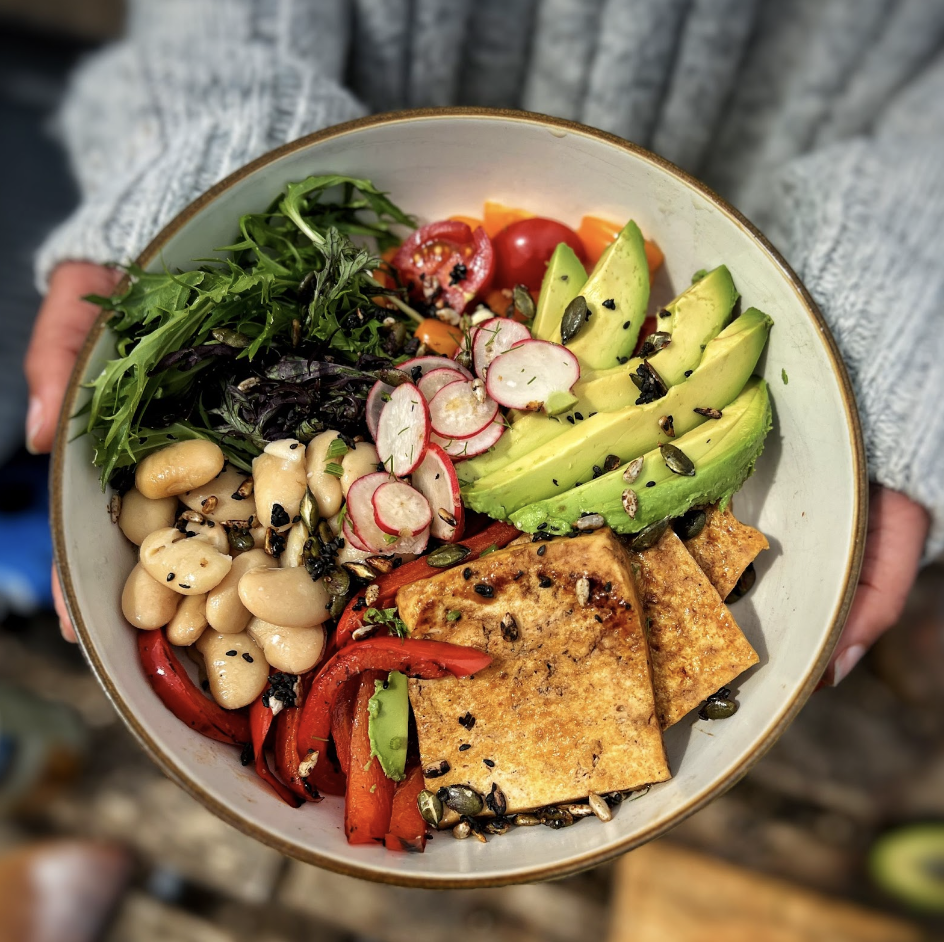
Beauty Bowl
Takes 20 minutes
Serves 2
Ingredients
- 1 red pepper
- 100 g green leaves
- 160 g firm tofu
- 2 tbsp tamari
- 1 tbsp maple syrup
- 1 tsp vinegar
- 50 g mixed seeds
- 12 cherry tomatoes
- 1 avocado
- 150 g cooked butter beans
Pickled Radish
- 4-5 radishes
- 40 ml apple cider vinegar
- Pinch of salt
- 5 g fennel (herb of choice)
To serve
- 2 slices sourdough
Instructions
- Make the pickled radishes:Thinly slice the radishes along with your herb of choice. Place in a glass or small bowl, add a pinch of salt, and cover with the apple cider vinegar (or vinegar of choice). Mix and leave to sit while you prepare the rest of the bowl.
- Prepare the pepper:Slice the red pepper into long strips. Heat a griddle pan or non-stick frying pan over high heat. Once hot, add the peppers with no oil and fry them on both sides until they start to char around the edges, about 5-7 minutes. Remove from heat and set aside.
- Cook the tofu:Slice the tofu into 4 pieces. Using the same hot pan, sear the tofu on both sides over high heat until it turns lightly golden brown. Mix the tamari, maple syrup, and vinegar together, then pour over the tofu. Move the tofu around in the pan to absorb the sauce. As the sauce cools, it will thicken and glaze the tofu. Remove from the pan and set aside.
- Toast the seeds:Keep the pan hot and add the mixed seeds. Stir regularly while cooking, and when the sesame seeds begin to pop (about 4-5 minutes), remove from heat.
- Prepare the vegetables:Drain and rinse the butter beans. Cut the avocado in half, remove the stone, scoop out the flesh, and slice into long strips. Quarter the cherry tomatoes.
- Assemble the bowl:Divide the green leaves between two bowls. Arrange the tofu, red pepper, butter beans, avocado slices, and cherry tomatoes on top. Remove the radishes from the vinegar and divide between the bowls. Sprinkle the toasted seeds on top. Serve with sourdough slices and enjoy!
Nutrition
This is a lovely healthier take on the classic, the airfryer means we don’t have to deep fry our “fish” thus reducing the oil content by approx 60%. Here we use tofu as our “fish” and by coating in a little seaweed and some tamari delivers a great flavour – we used the instabrand vortex plus versazone airfryer as the 2 drawers meant we could cook the “fish” and chips at the same time and have them finish together!
Here we used an Instant Versazone – Save 15% on any full price Instant air fryer with code HAPPY until 31st May.
Click here to avail of the offer
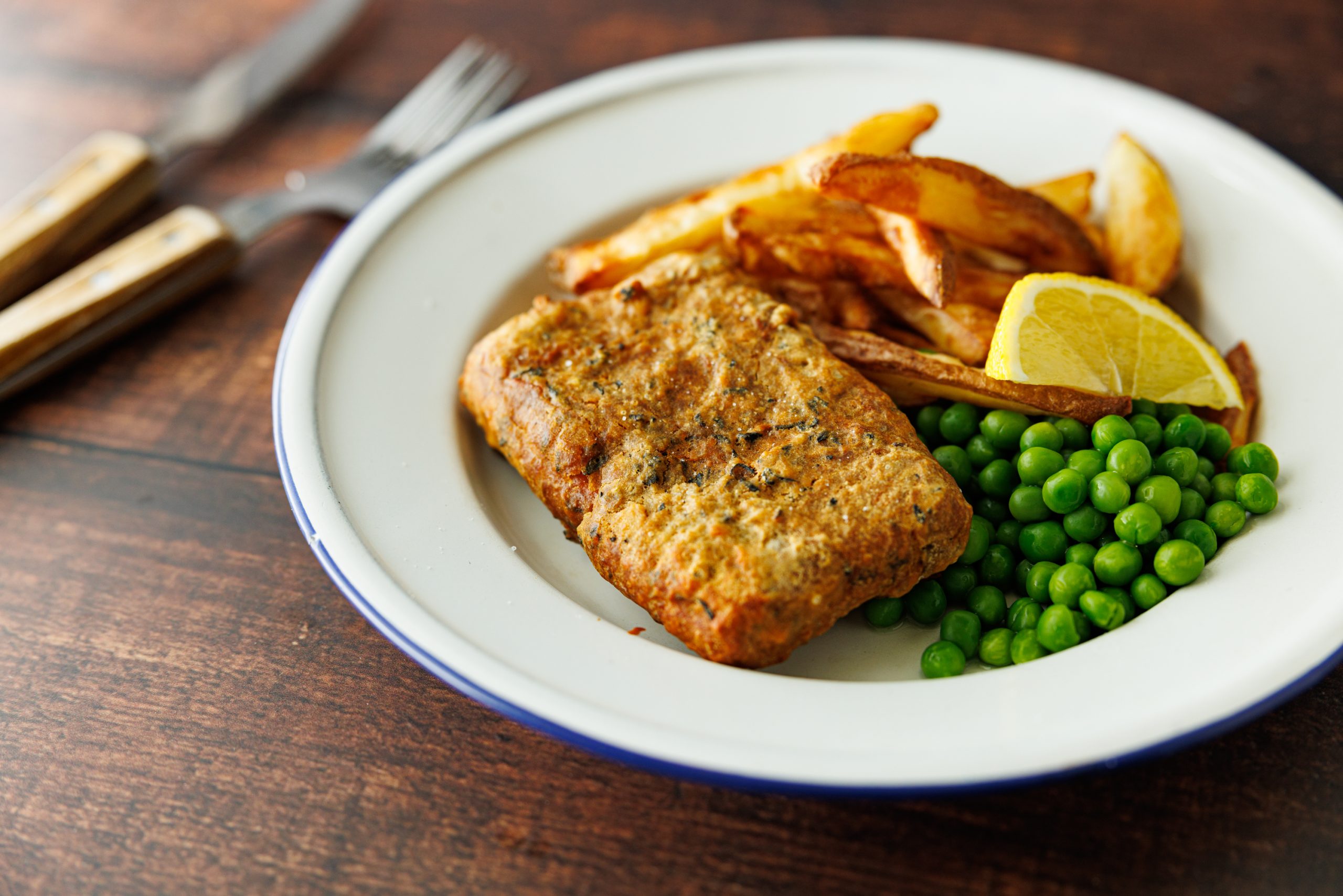
Beer Battered “Fish” Fingers and Chips in an airfryer
Takes 14 minutes
Serves 2
Ingredients
Beer Umami Bath
- 60 ml Ale / Beer of Choice
- 45 ml Tamari / Soya Sauce
Dry Sea Mix
- 35 g Cornflour
- 60 g Plain Flour
- 3 g Dry Seaweed of Choice / Seaweed Powder
- 1/4 tsp Salt
- 1/6 tsp Garlic Powder
Base Coat
- 200 g Firm Tofu
- Spray Oil for browning
Chips
- 400 g Potatoes
- Salt
Instructions
For the chips:
- Preheat the airfryer to 200 degrees c
- Cut the potatoes into chip size (approx 1cm x 1cm x 8cm) , rinse them in cold water and leave them to soak for a minute or 2 and rinse again. This process will remove some of the starch and result in a crispier chip! Add to one side of the airfryer and add 1/3 tsp of salt and 5 sprays of oil and mix well.
- Put them on bake function on the airfryer for 25 mins at 200 degrees c. If using an instabrand vortex plus versazone airfryer, use the dual sync function so the chips and the tofu end at the same time.
For the Tofu:
- Finely dice or rip up the seaweed, if using a sheet of nori finely dice using a knife and if using the likes of arame seaweed just finely dice with a knife or use a pestle and mortar, you want it to be a fine almost powder-like texture.
- Get 2 bowls, one for the beer and tamari mix, and one for the dry sea mix. Cut the tofu into long rectangle strips, approx 5cm x 10cm x 1cmIn the first bowl mix the seaweed, flour, cornflour, salt and garlic powder. In the second bowl mix together the beer and tamari/ soy sauce.
- Dip the tofu in the beer tamari mix, then into the dry sea mix, and repeat 3 times to give it a good coat that doesn't run.
- Carefully place in the airfryer and spray with an oil spray approx 5-10 times, this will give a more even golden colour, bake for 15 mins at 200 degrees c.
- Twice during the cooking process remove the tofu and coat in the tamari beer mixture and then the dry mixture and then the tamari beer mixture and put back in the airfryer to cook. This will ensure you get a good crusty batter.
- Once cooked, remove and serve the battered “fish” and chips with some peas and a slice of lemon, enjoy!
Video
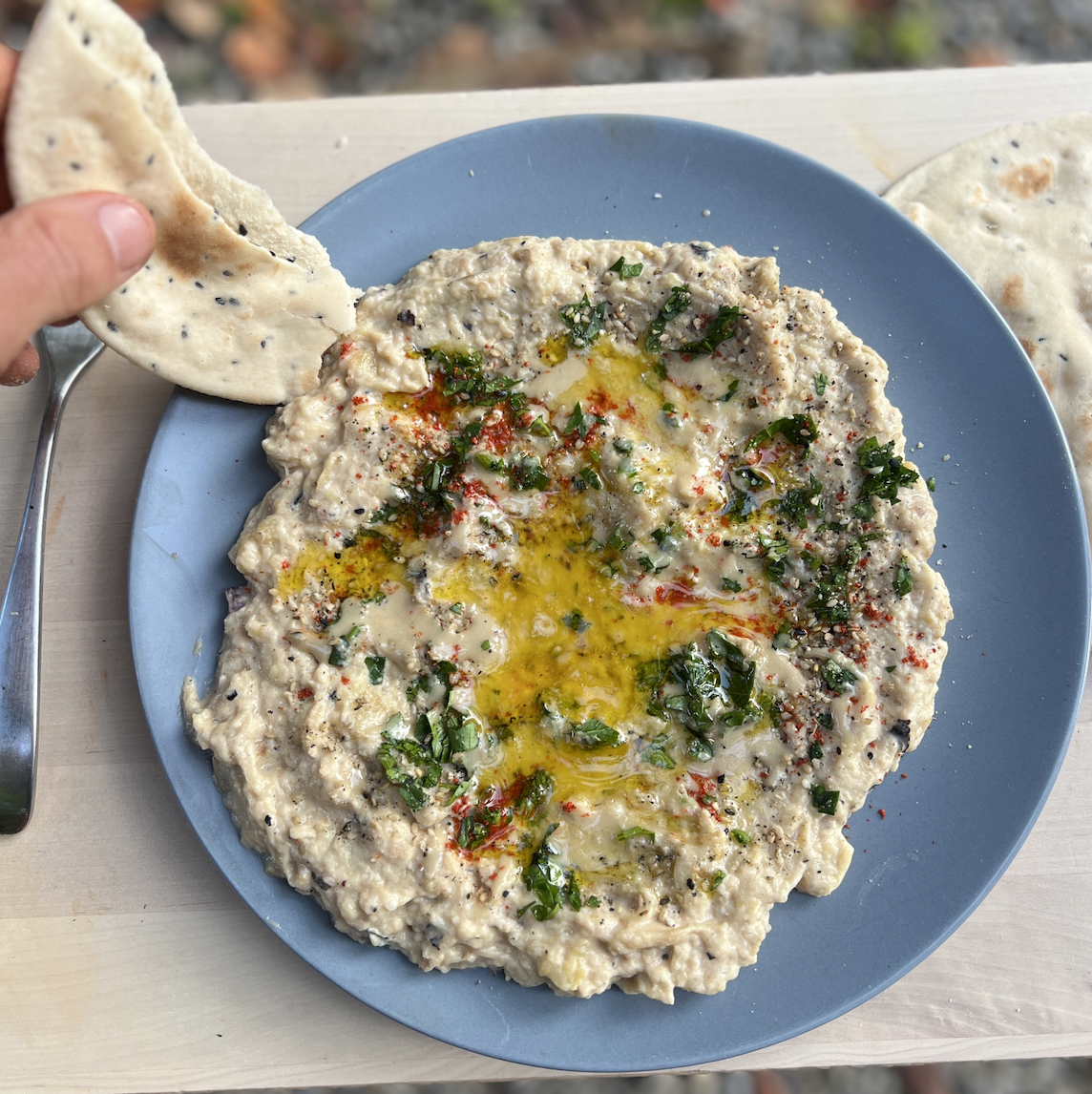
Baba Ganoush
Takes 18 minutes
Serves
Ingredients
- 2 aubergines
- 70 g tahini
- 3 tbsp lemon juice
- 1 clove garlic
- 3 tbsp plant-based yoghurt
- 1 tsp salt
- pinch ground pepper
- ¼ tsp sumac
Instructions
- In the oven: Preheat the oven to 220°C (fan).Cut the aubergines in half lengthways, rub a little oil on the inside of the aubergines, and place them on a baking tray, flesh side down. Sprinkle with salt and cook for 40 minutes until the aubergines are charred, collapsed, and super soft.
- On an open flame: If you have a gas stove, you can cook the aubergines directly on an open flame, turning occasionally for approximately 15 minutes, until charred, collapsed, and super soft inside.
- Finishing:Allow the aubergines to cool for a few minutes until you can handle them.In a medium mixing bowl, scrape out the soft flesh from the aubergines (it should come away easily from the skin).Add the remaining ingredients and mix well. Taste and adjust the seasoning with more lemon, salt, or heat according to your preference.
The Happy Pear Podcast
In this episode, we are joined by Michelle Wong, a cosmetic chemist and skincare blogger with a PhD in chemistry. Michelle has been sharing her expertise on all things skincare for over a decade, and her blog, Lab Muffin, is a go-to resource for those looking to learn more about the science behind beauty products.
Episode 119
The conversation covers a range of topics, including the importance of using sun cream, the difference between natural and unnatural cosmetic ingredients, and more. Michelle shares her insights and expertise throughout the episode, explaining complex scientific concepts in an approachable and engaging way.
We start off by discussing the science behind sun cream and how it works to protect the skin from UV radiation. Michelle emphasises the importance of using sun cream on a daily basis, regardless of skin tone or weather conditions, to prevent skin damage and reduce the risk of skin cancer.
The conversation then shifts to the topic of natural vs unnatural cosmetic ingredients. Michelle explains that these labels can be misleading, as there is no clear definition of what constitutes a “natural” ingredient. She also notes that many synthetic ingredients are safe and effective, and that the focus should be on choosing products that work well for your skin type and needs.
Throughout the episode, Michelle shares her expertise on skincare and beauty products, dispelling common myths and misconceptions and offering practical advice for listeners.
A fascinating and informative deep dive into the world of skincare, from the insights and expertise of Michelle Wong (Lab Muffin). Whether you’re a skincare enthusiast or simply curious about the science behind beauty products, this episode is for you..
Lots of love,
Dave & Steve
This episode is sponsored by Vivobarefoot Footwear. Vivobarefoot Footwear have given our listeners an exclusive 15% discount when you enter the code HAPPYPEAR15
Genuinely these are the only shoes you will see Dave & Steve wearing!
Produced by Sean Cahill & Sara Fawsitt
Available now from all good podcast providers:
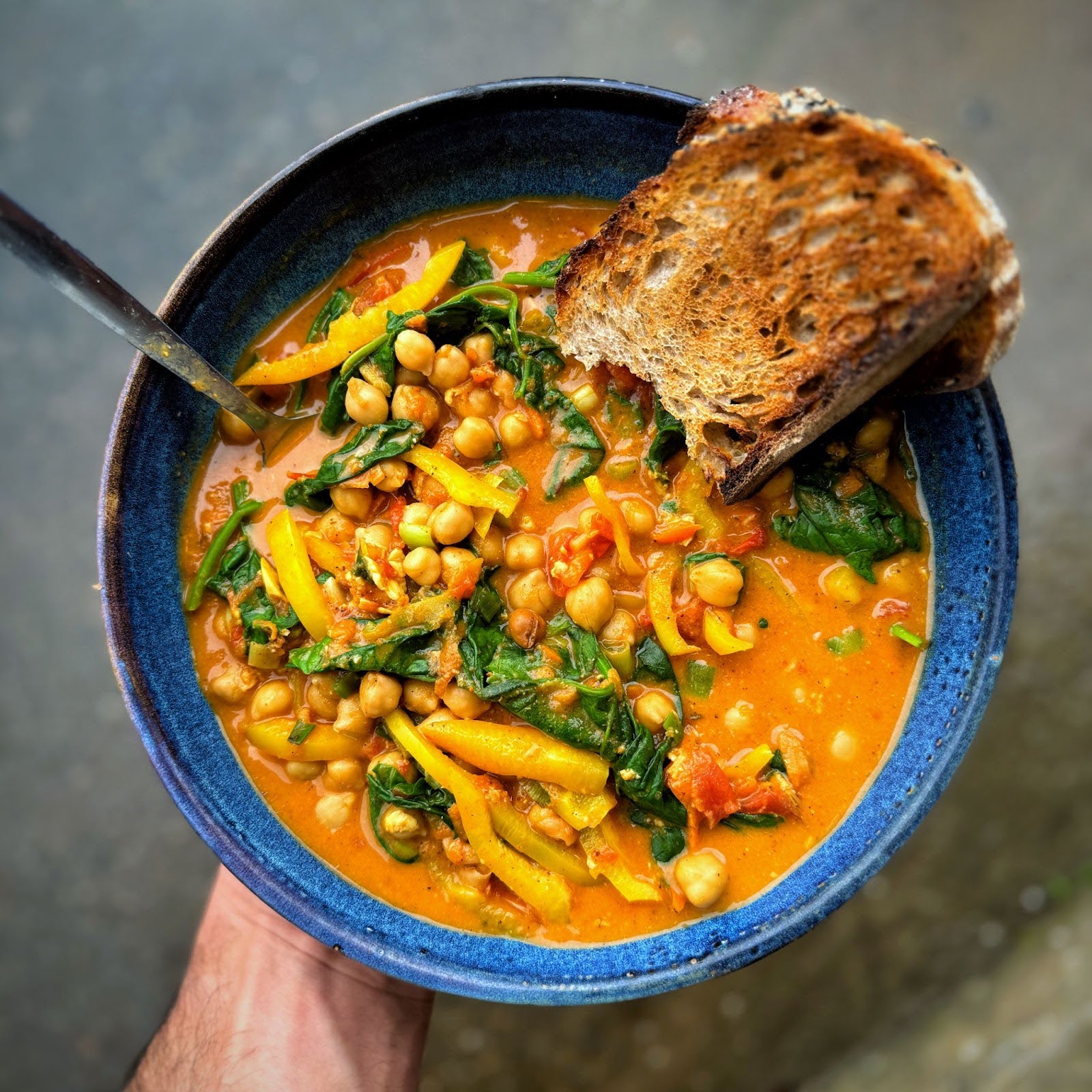
High Protein Chickpea Curry
Takes 20 minutes
Serves 4
Ingredients
- 100 g tempeh (3.5 oz)
- 2 cloves garlic
- 10 g fresh ginger (0.35 oz )
- 4 scallions (green onions)
- 1 tbsp miso paste
- 1 x 400g (14 oz) (tin of chopped tomatoes)
- 1 x 400g (14 oz ) (tin of low fat coconut milk)
- 100 g baby spinach (3.5 oz)
- 1 carrot
- 1 yellow pepper
- 2 x 400g (14 oz) (each tins of cooked chickpeas)
- 10 cherry tomatoes
- 1 tbsp cumin seeds
- ½ tsp fennel seeds (optional)
- 2 tbsp curry powder
- 1 tsp ground turmeric
- 1 tsp salt
- ¼ tsp ground black pepper
- Juice of ½ lime
Instructions
- Prepare Vegetables and Tempeh: Grate the carrot and ginger. Peel and finely dice the garlic. Finely slice the scallions or green onions. Use a potato peeler to slice the tempeh into thin slices. Drain and rinse 2 x 400g tins of cooked chickpeas. Quarter 10 cherry tomatoes. Slice the yellow pepper into thin slices.
- Sauté Vegetables and Tempeh: Heat a wide-bottomed frying pan on high heat. Once hot, add the sliced green onions, sliced yellow pepper, grated ginger, grated carrot, and sliced tempeh; fry for 2 minutes.
- Add Spices and Garlic: Next, add the diced garlic, 1 tbsp cumin seeds, and ½ tsp fennel seeds to the pan and cook for another 2 minutes.
- Combine Remaining Ingredients: Add in the drained chickpeas followed by the rest of the ingredients (1 x 400g tin chopped tomatoes, 1 x 400g tin coconut milk, 1 tbsp miso paste, 2 tbsp curry powder, 1 tsp ground turmeric, 1 tsp salt, and ¼ tsp ground black pepper) and mix well.
- Simmer and Season: Bring to a boil and reduce to a simmer for 3-4 minutes. Taste and adjust the seasoning to your liking by adding more salt, pepper, or lime juice.
- Serve: Toast 2 slices of sourdough bread. Serve the curry alongside the toasted bread for a delicious meal!
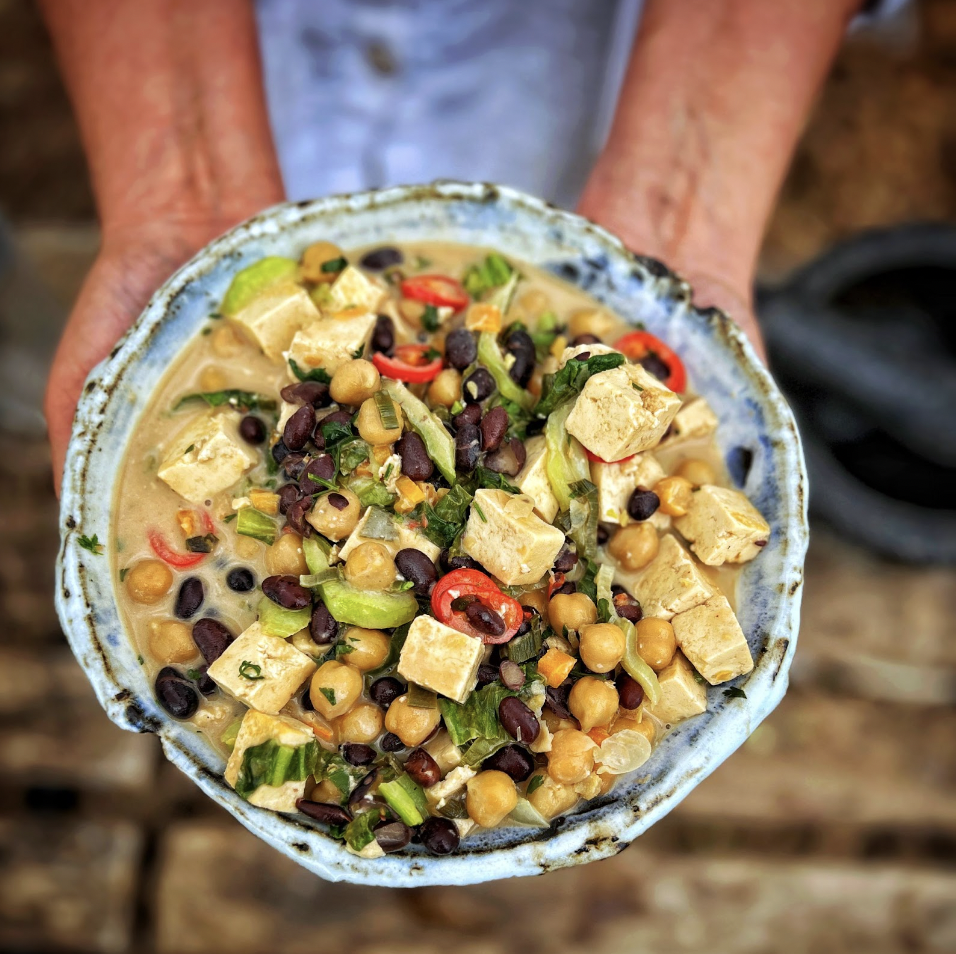
Thai Style Curry with Tofu and Beans
Takes 27 minutes
Serves 2
Ingredients
For the paste:
- 1 stick lemongrass
- 1 thumb-sized piece of ginger
- 2 cloves garlic
- 1 red chilli
- 1 tbsp coconut sugar (or brown sugar)
- Juice of 1/2 lime
- 2 tbsp tamari
For the curry:
- 250 g firm tofu
- 2 tbsp tamari
- 1 x 400 g tin of chickpeas
- 1 x 400 g tin of black beans
- 1 head pak choi
- 1 carrot
- 4 scallions
- 200 ml light coconut milk
- 200 ml water
- 15 g coriander
Instructions
- Make the paste:Cut the nub off the lemongrass and finely dice. Finely dice the 1/2 chilli, ginger, and garlic. Add them to a pestle and mortar or blender, along with the remaining paste ingredients (coconut sugar, lime juice, and tamari). Blend or grind until smooth.
- Prepare the vegetables:Drain and rinse the chickpeas and black beans. Finely dice the carrot, finely slice the scallions, chop the pak choi, and finely chop the coriander.
- Cook the tofu:Add the tofu, carrot, and scallions to a pan and fry for 4-5 minutes, turning the tofu occasionally until it becomes lightly golden on each side.
- Add the curry paste:Stir in 2 tbsp of tamari and mix well. Add the curry paste to the pan and cook for an additional 2 minutes to let the flavours combine.
- Simmer the curry:Pour in the coconut milk and water. Add the drained chickpeas, black beans, and pak choi. Cook for 4-5 minutes until the dish comes together and everything is well mixed.
- Taste and adjust:Taste the curry and adjust the seasoning as needed. Add more salt, lime juice, or coconut sugar/brown sugar to balance the flavours.
- Garnish and serve:Finely dice the remaining 1/2 chilli. Garnish the curry with red chilli and coriander. Serve with your favourite grain, such as rice, noodles, or quinoa. Enjoy!
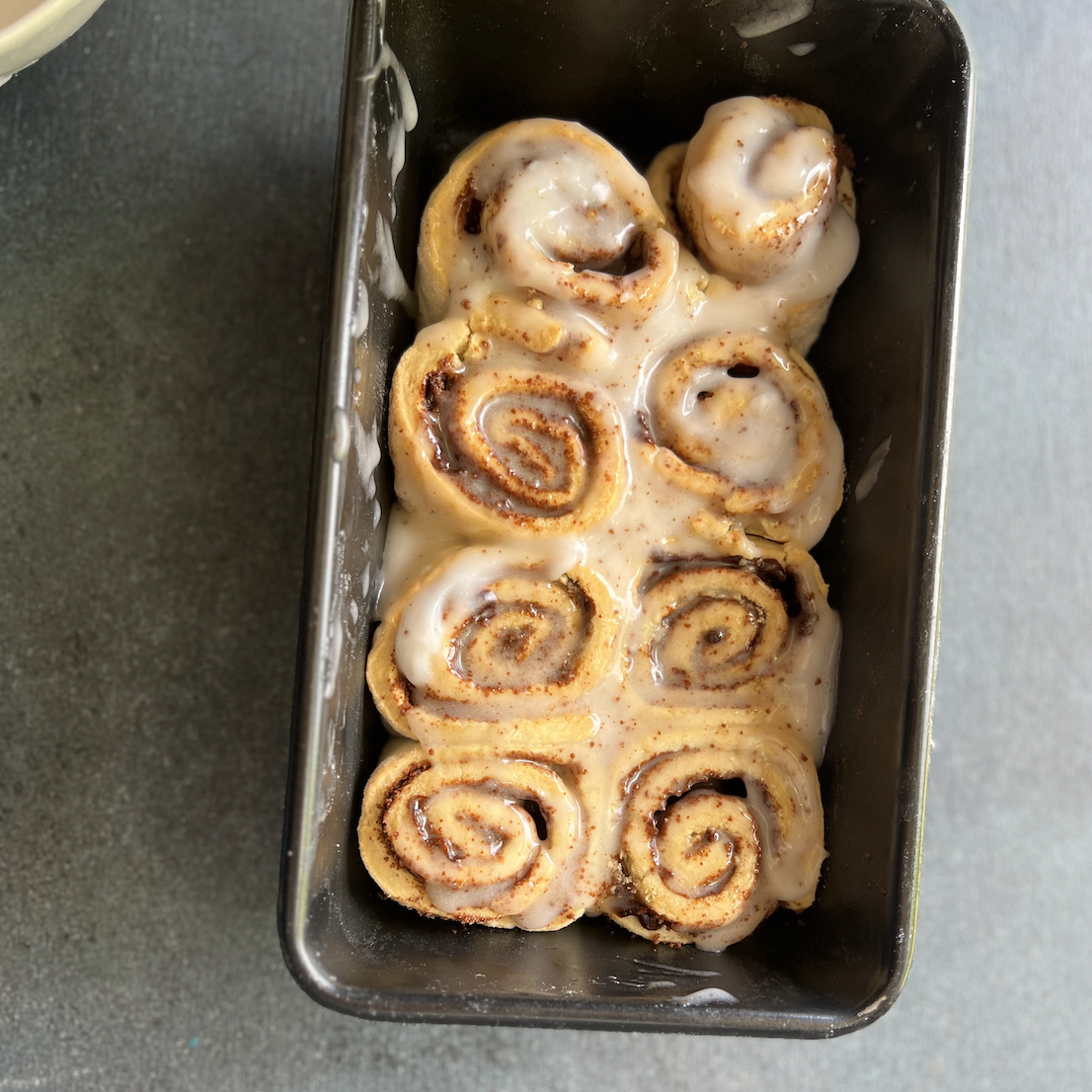
Cinnamon Swirls
Takes 45 minutes
Serves
Ingredients
For the dough:
- 200 g self-raising flour
- 35 g caster sugar
- ¼ tsp salt
- 80 g cold vegan butter (cut into cubes)
- 100 ml oat milk
For the cinnamon filling:
- 2 tbsp vegan butter (melted)
- 90 g brown sugar
- 1 tsp ground cinnamon
For the cream cheese frosting:
- 4 tbsp vegan cream cheese
- 65 g icing sugar
- ¼ tsp vanilla extract
- 1 tsp oat milk
Instructions
- Preheat and preparePreheat the air fryer to 160°C using the bake function. Grease a 2lb loaf tin (approx. 900g).
- Make the doughIn a mixing bowl, combine the self-raising flour, caster sugar, and salt. Add the cold vegan butter and use your fingers to rub it into the flour mixture until it resembles damp sand or breadcrumbs.Stir in the oat milk until the dough comes together into a soft clump. Lightly coat the dough in flour to make it easier to handle.Dust your counter with flour and place the dough on the surface. Roll it out into a rectangle, approximately 45cm x 30cm.
- Prepare the cinnamon fillingMelt the vegan butter. In a separate bowl, mix the brown sugar and ground cinnamon together.Spread the melted butter evenly over the rolled-out dough, making sure to bring it right to the edges. Sprinkle the cinnamon-sugar mixture evenly over the buttered dough.
- Roll and cutStarting from the long edge (45cm side), tightly roll the dough into a log.Cut the log in half, then halve each piece again, and repeat once more to end up with 8 pieces.Place the cinnamon swirls into the greased loaf tin.
- BakePlace the loaf tin in the preheated air fryer drawer and bake for 18-20 minutes until golden and crispy.
- Make the frostingWhile the cinnamon rolls are baking, make the cream cheese frosting. In a bowl, mix the vegan cream cheese, icing sugar, vanilla extract, and oat milk. Use a fork to break down the mixture and stir until smooth and creamy.
- ServeRemove the cinnamon rolls from the air fryer and drizzle the frosting over the top.Serve warm and enjoy!
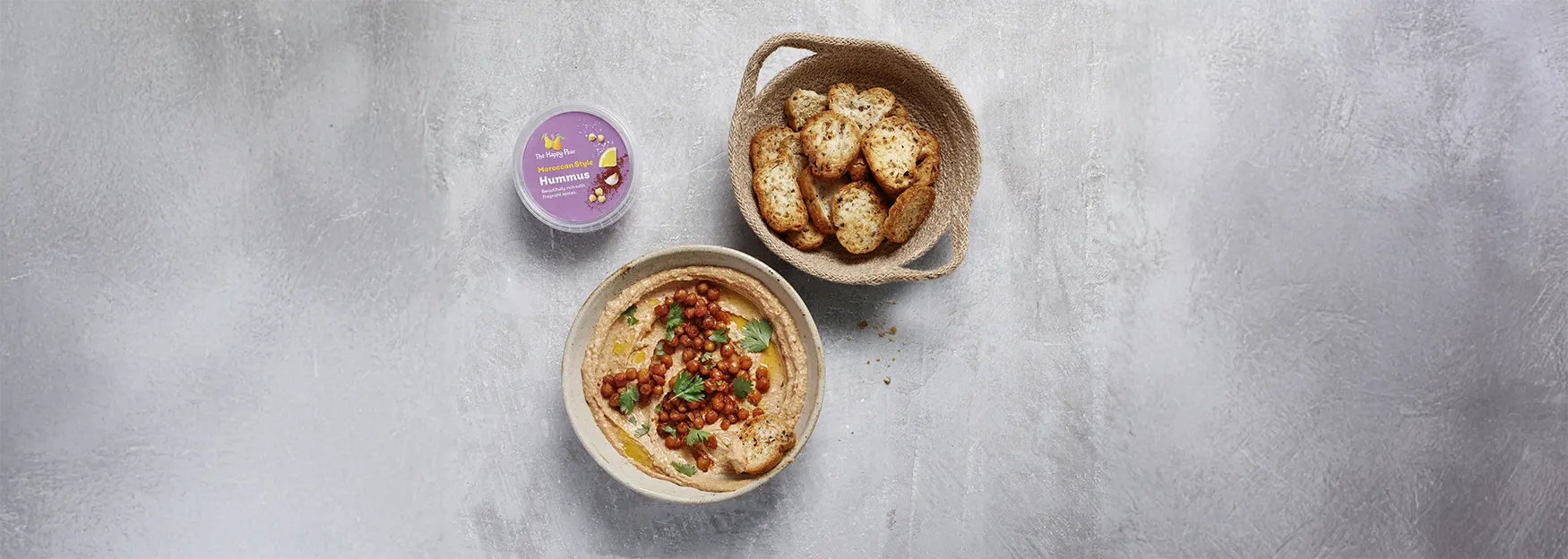
This is a beautifully rich fragrant hummus that is absolutely more-ish and we love that it’s made without using any artificial preservatives.
INGREDIENTS
Cooked Chickpeas (44%) [Chickpeas, Water], Rapeseed Oil, Tahini (15%) (SESAME SEEDS), Water, Sultanas (6%) [Sultanas, Sunflower Oil], Garlic, Lemon Juice Concentrate, Sea Salt, Smoked Paprika, Rowanberry Extract, Ground Coriander, Cumin, Cinnamon, Chilli Flakes
ALLERGEN INFORMATION
For allergens, see ingredients highlighted.
May contain traces of nuts.
NUTRITIONAL INFORMATION
| Typical | per 100g |
|---|---|
| Energy | 1497kJ |
| 361kcal | |
| Fat | 29.0g |
| of which: Saturates | 2.7g |
| Carbohydrates | 15g |
| of which: Sugars | 4.9g |
| Fibre | 4.5g |
| Protein | 7.8g |
| Salt | 1.2g |
The Happy Pear Podcast
This week we are joined by the incredible Dan Saladino, a renowned food journalist and presenter. Dan’s latest book, ‘Eating to Extinction,’ takes centre stage in this discussion as they explore the vital link between our food choices and the preservation of our planet.
Episode 118
A passionate advocate for sustainable food systems, Dan Saladino is a familiar name in the world of food journalism and presenting. With his wealth of knowledge and experience, Dan has been a driving force in raising awareness about the environmental impact of our food choices.
Get ready to be inspired as Dan unveils the motivation behind his powerful book, ‘Eating to Extinction.’ Discover the profound connection between our diets and biodiversity loss, and how simple shifts in our food choices can contribute to a more sustainable future. From embracing plant-based diets to supporting local and organic farming, Dan offers practical strategies to make a lasting impact.
Join us as we discuss overcoming barriers to change and fostering a sense of community support along the journey to sustainable food choices. Together, we explore the significant role that both the food industry and policy play in creating a sustainable food system.
A brilliant episode! Every meal is an opportunity to make a positive impact on our planet, so let’s embrace sustainable food choices and create a brighter and more sustainable future together!
Lots of Love,
Dave & Steve
To learn more about Dan & his work check out: @eating2extinct & www.fooddiversityday.com
This episode is sponsored by Vivobarefoot Footwear. Vivobarefoot Footwear have given our listeners an exclusive 15% discount when you enter the code HAPPYPEAR15
Genuinely these are the only shoes you will see Dave & Steve wearing!
Produced by Sean Cahill & Sara Fawsitt
Available now from all good podcast providers:
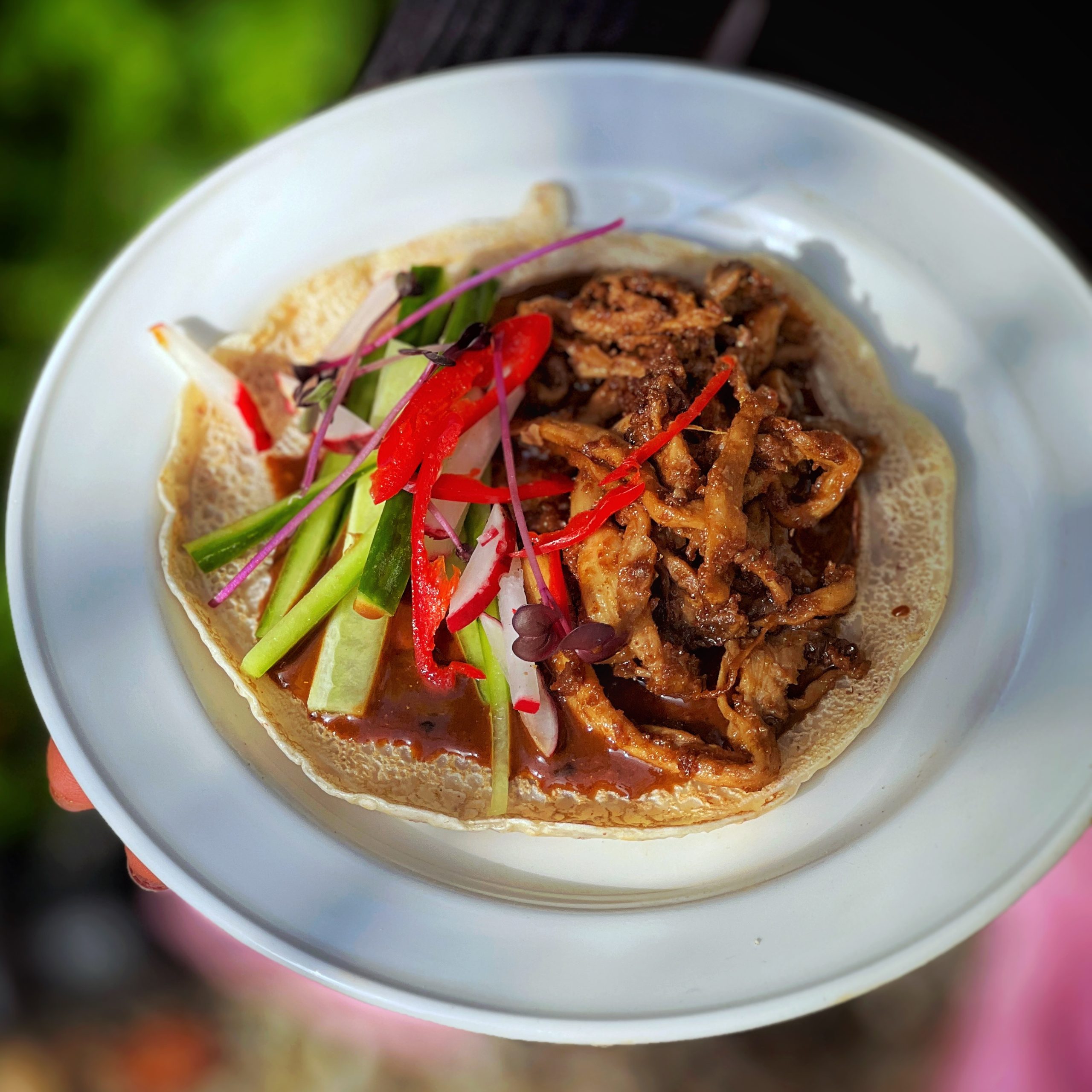
Vegan Hoisin Duck Pancakes
Takes 30 minutes
Serves 2
Ingredients
- 250 g oyster mushrooms
Marinade
- 3 tbsp tahini
- 5 tbsp water
- 1 tbsp miso paste
- 3 tsp brown sugar
- 1 tsp chinese 5 spice
- 1/2 tsp chilli powder
- 2 tbsp rice wine vinegar
- 2 tbsp tamari
Pancakes
- 150 g plain flour
- 300 ml water
- 2 tsp ground flax
Garnish
- 1/2 cucumber
- 1/2 bunch spring onions
- 1 red chilli
- 1 tbsp sesame seeds
Instructions
- Preheat the ovenPreheat the oven to 180°C.
- Prepare the mushroomsCut the oyster mushrooms into thin, long strips.
- Make the marinadeWhisk all the marinade ingredients (tahini, water, miso paste, brown sugar, Chinese five spice, chilli powder, rice wine vinegar, and tamari) in a medium-sized bowl. Add ¾ of the marinade to the mushrooms and mix well, ensuring all the mushrooms are coated. Set aside to marinate while you prepare the pancake batter.
- Make the pancake batterAdd all the pancake ingredients (plain flour, water, and ground flaxseed) to a blender and blend for 30 seconds until smooth. Set aside for 2-3 minutes to allow the flaxseed to thicken.
- Bake or fry the mushroomsTo bake, spread the marinated mushrooms onto a baking tray in an even, single layer to allow the edges to crisp.Bake for 20 minutes.To fry, for a crispier version, heat a wide-bottomed non-stick pan on high heat.Add 2-3 tbsp of oil and fry the mushrooms, stirring constantly, until they brown all over, about 5 minutes.Remove from the pan once they are crispy and taste fantastic!
- Prepare the garnishWhile the mushrooms are cooking, prepare the cucumber, spring onions, and chilli. Cut the cucumber into 10 cm long thin strips. Slice the spring onions diagonally into thin slices. Slice the red chilli (remove the seeds if you prefer less heat).
- Cook the pancakesHeat a medium non-stick pan on high heat. Once hot, add a thin layer of pancake batter (about 40-50 ml per pancake) to make a 15 cm pancake.Reduce the heat to medium. Cook for 1 minute, then carefully turn the pancake over with a silicone spatula and cook for a further minute. Repeat until all the batter is used. Keep the pancakes warm in foil while you cook the rest.
- Assemble the pancakesTo assemble, spread 1 tsp of the remaining hoisin sauce on each pancake.Add 2-3 tbsp of the cooked mushrooms, 3-4 cucumber strips, and sprinkle with spring onions, chilli slices, and sesame seeds. Wrap and enjoy!
Nutrition
Tofu is something people either love or hate, but these two methods will turn any hater into a lover! Packed with flavour, air frying makes it easy to achieve that crispy exterior, taking it to the next level.
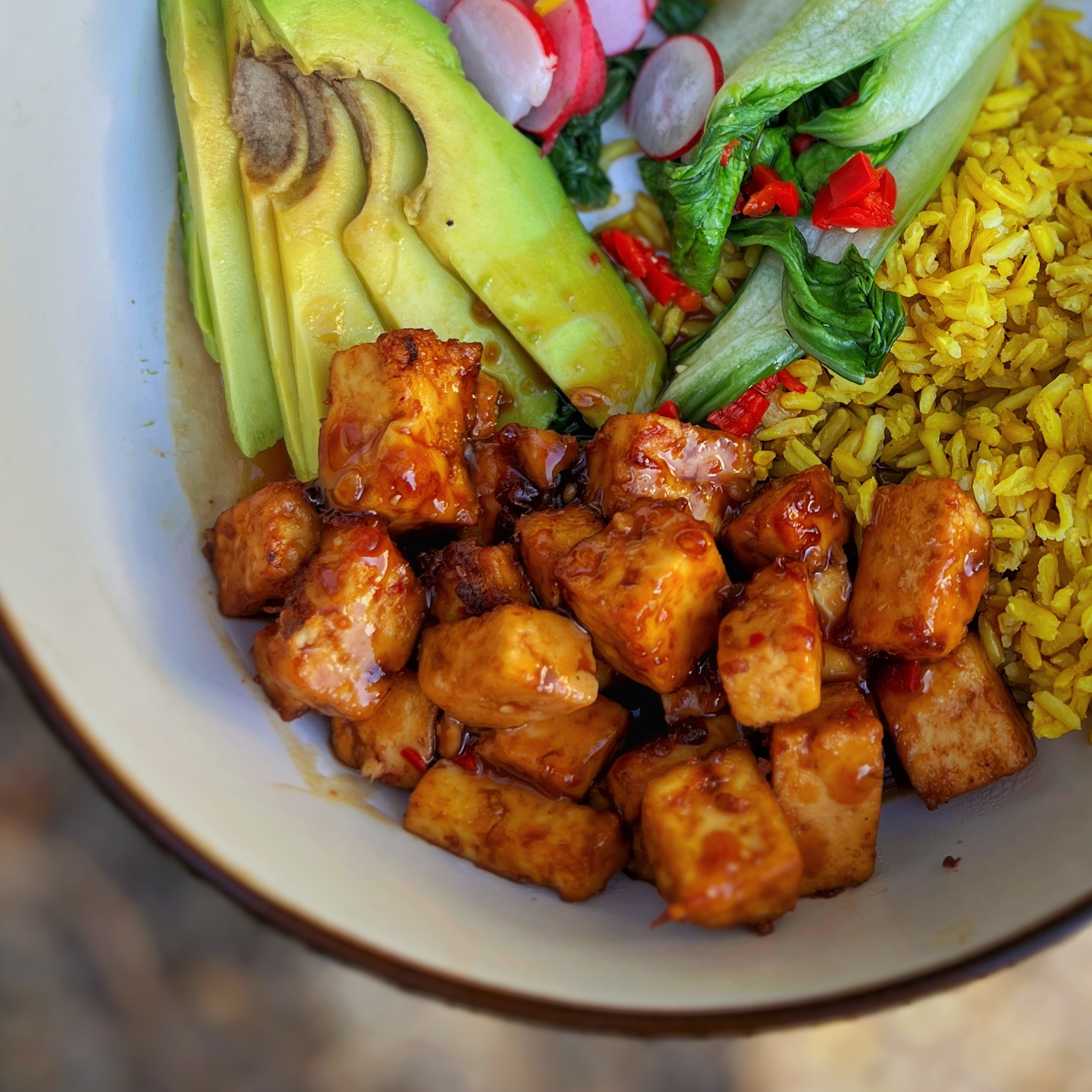
Sticky spicy barbeque nuggets
Takes 20 minutes
Serves 2
Ingredients
For the Tofu
- 250 g firm tofu
- 1 tbsp oil
- 2 tbsp cornstarch (or flour)
- 1/2 tsp garlic powder
- Pinch of black pepper
- 2 tbsp tamari or soy sauce
- 1 tbsp water
For the Spicy Sticky Sauce
- 4 tbsp maple syrup
- 1 clove garlic (or 1/2 tsp garlic powder)
- 1- inch piece of fresh ginger (or 1 tsp ginger powder)
- 1/2 tsp chilli flakes
- 2 tsp tomato puree
- 3 tbsp tamari or soy sauce
- 1 tbsp vinegar
- 2 tsp cornflour (or flour + 1 tsp water mixed)
Instructions
- Start by pressing the tofu to remove excess water. This will help it achieve a crispier texture when fried.
- Cut the tofu into small cubes, roughly 1.5 cm in size. If using fresh garlic and ginger, finely dice them.
- In a bowl, toss the tofu cubes with the cornstarch (or flour), garlic powder, and black pepper, making sure the cubes are well coated.
- Heat 1 tbsp of oil in a wide, non-stick pan over high heat. Once hot, add the tofu cubes, frying on each side until they begin to char and develop a golden sear. This should take about 5-6 minutes.
- While the tofu is frying, mix together all the ingredients for the sauce—maple syrup, garlic, ginger, chilli flakes, tomato puree, tamari or soy sauce, vinegar, and the cornflour-water mixture.
- Stir well to ensure the sauce is smooth and lump-free.
- Once the tofu is seared on all sides, add 2 tbsp of tamari or soy sauce and 1 tbsp of water to the pan.
- Stir to ensure each piece of tofu absorbs some of the tamari.
- Pour the spicy sticky sauce over the tofu, stirring to coat each piece evenly. Cook for an additional 1-2 minutes until the sauce becomes thick and sticky. Remove from the heat.
- Your sticky, spicy tofu nuggets are ready to enjoy!

Sesame teriyaki tofu
Takes 20 minutes
Serves 2
Ingredients
- 250 g of tofu
Sauce/marinade:
- 3 tbsp tamari
- 2 tbsp maple syrup
- 1 tsp vinegar of choice (or mirin)
- 1 tsp garlic powder
- 1 tsp ginger powder
- 1 tsp fresh chilli (finely chopped)
For glaze:
- 2 tbsp coconut sugar
- 1 tbsp cornstarch (or cornflour)
Instructions
- Cut the tofu into 1 cm thick rectangles, approximately 3 x 6 cm.
- Mix together the sauce/marinade ingredients. Marinade the tofu in ¾ of the sauce for 1-2 minutes, turning to coat well while the air fryer preheats.
- Bake the tofu in the air fryer at 200°C for 10 minutes.
- While the tofu is baking, add the remaining ¼ of the marinade, coconut sugar, and cornstarch to a saucepan.
- Cook over medium heat, whisking constantly until the sauce thickens and reduces.
- Be careful not to burn it! If it thickens too much, add 2 tbsp of water and mix through. Remove from heat and set aside.
- Take the tofu out of the air fryer and coat it in the glaze, ensuring all pieces are covered. Drizzle any remaining glaze over the tofu.
- Return the tofu to the air fryer and bake again at 200°C for 5 minutes.
- Sprinkle with sesame seeds and enjoy!
We literally make tonnes of granola each week and here we show how easy, accessible and delicious it is to make. The basic framework for granola that we follow is 50% oats of choice, 10% sweetener, 10% fat of choice, 10% nuts, 10% seeds and 10% dried fruit. Here we make it in an instant brand airfryer, we find them brilliant. Link here to get 15% off with the code: HAPPY
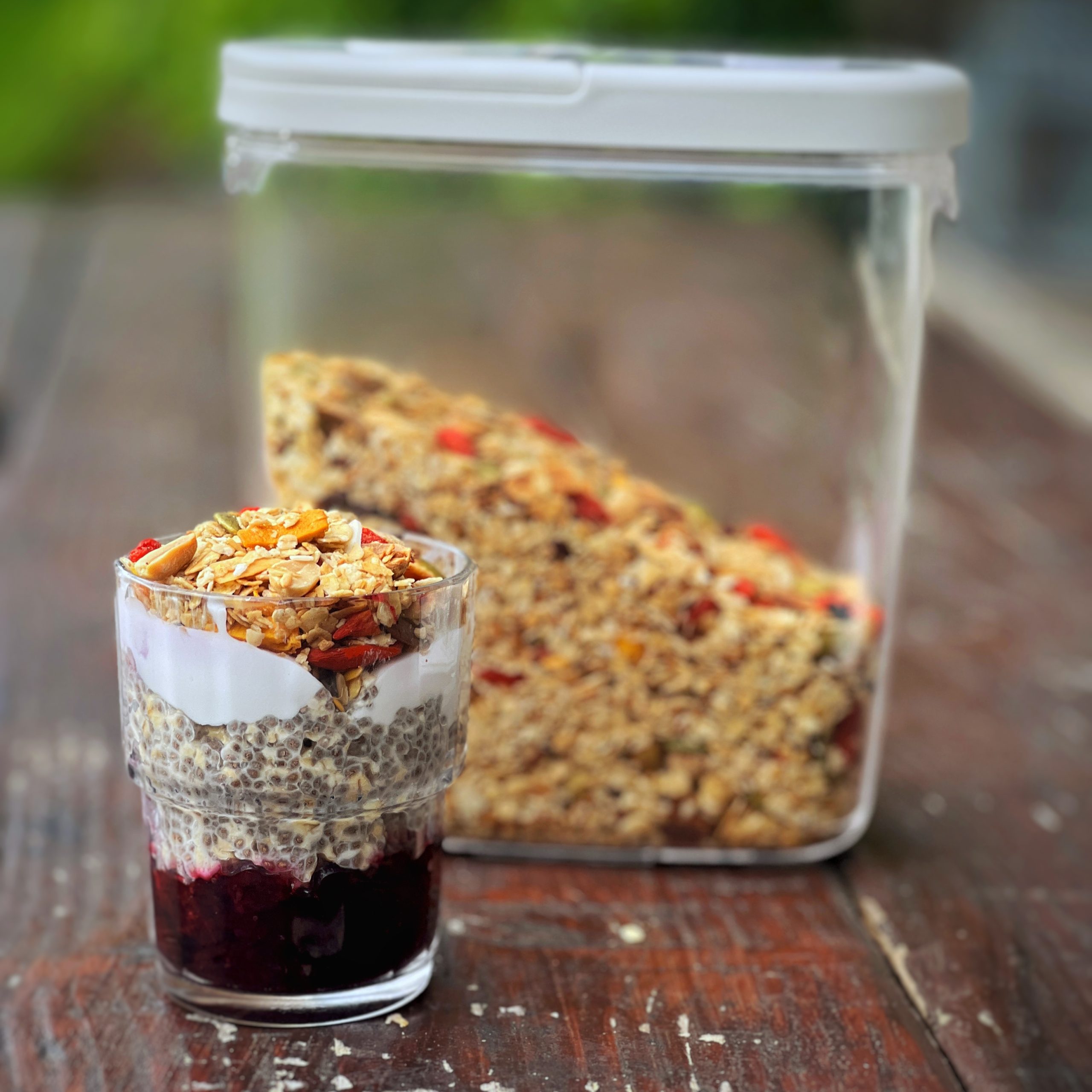
Healthier Granola in an airfryer
Takes
Serves
Ingredients
- 250 g Jumbo oats
- 50 ml Maple syrup
- 50 g Coconut oil or other neutral tasting oil such as sunflower
- Pinch of salt
- 25 g Dried mango
- 10 g Dessicated coconut
- 25 g Goji
- 40 g Cashews
- 10 g Flaked almond
- 10 g Sunflower seeds
- 40 g Pumpkin seeds
Instructions
- Method
- Preheat the oven to 160℃.
- Melt the coconut oil by putting in a small pot on a medium heat till melted (about 3 minutes).
- In a large bowl, mix all the dry ingredients together – oat flakes, nuts, seeds, desiccated coconut with a tiny pinch of salt. Make sure to leave the dried fruit as they will be mixed at the very end once the granola is cool. If you prefer to eat your nuts raw, then leave them aside with your dried fruit, otherwise include them for a crunchier more flavourful nut.
- In a separate bowl/jug, mix the wet ingredients – the maple syrup and the oil together into a wet mix.
- Add the wet mix into the dry mix bowl and mix thoroughly so that each flake, nut and seed gets an even coating.
- Transfer the mix to the air fryer basket and spread it out evenly in a thin layer. (If it is not spread out evenly it will steam as well as bake and result in some soft and some crunchy bits in your granola).
- Put basket in air fryer and cook for 20 minutes in the preheated air fryer at 180C.
- While your granola is baking in the oven, get your dried fruit ready in a bowl. If you are using the dried mango you will need to cut it with a scissors/knife into bite size pieces.
- Once the granola is baked, leave it to cool for 20 minutes. Then add the dried fruit and mix.
- Once properly cooled, store in an airtight container for up to 6 months.
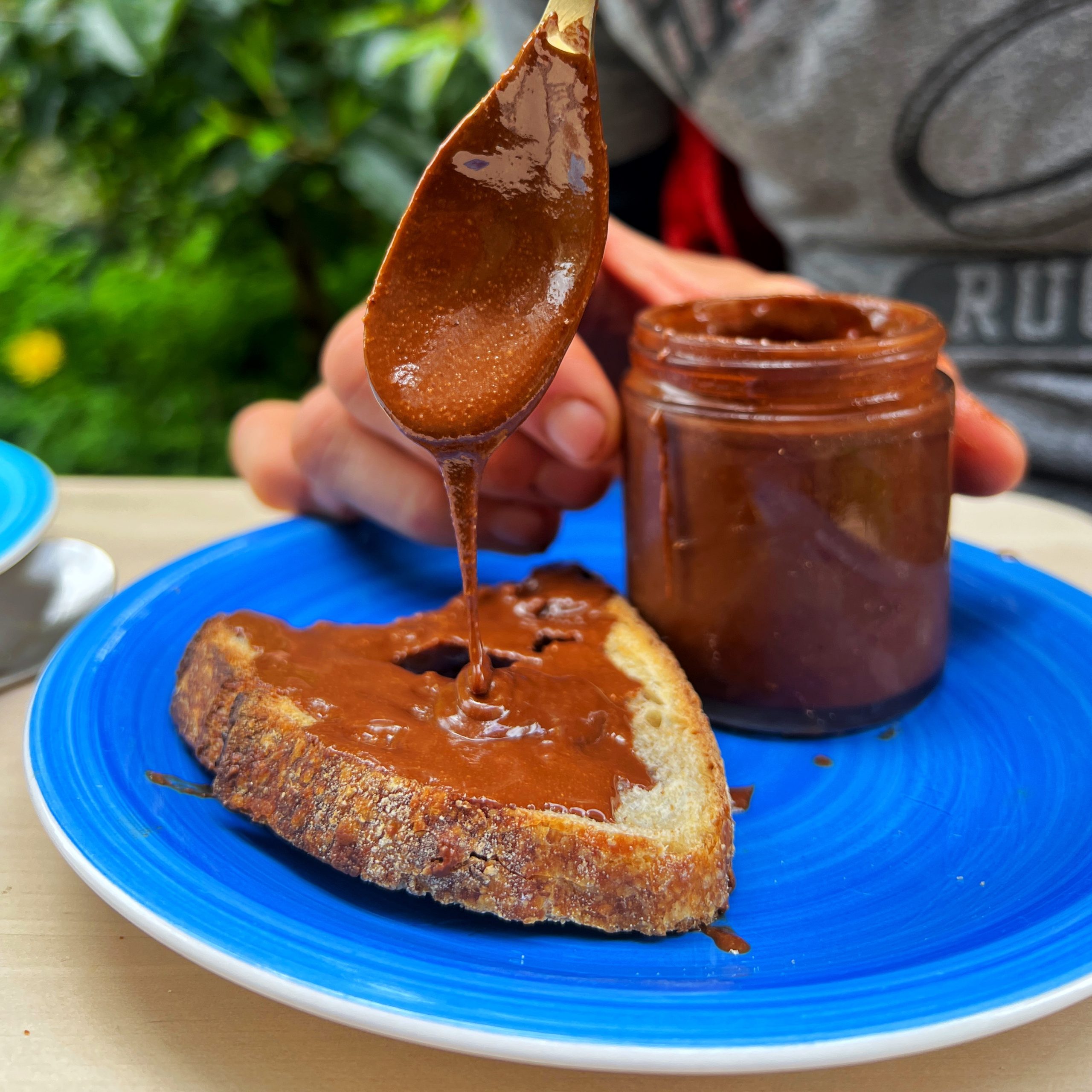
Easy 4 Ingredients Homemade Nutella
Takes 20 minutes
Serves 10
Ingredients
- 200 g hazelnuts
- 1/2 tsp vanilla
- 1/3 tsp salt
- 60 g chocolate
Instructions
- Preheat the oven:Preheat the oven to 180°C.
- Roast the hazelnuts:Spread the hazelnuts on a baking tray and roast them for 10-12 minutes until the skins turn dark brown.
- Remove the skins:Pour the roasted hazelnuts into a clean tea towel and rub them for 1-2 minutes to loosen the skins. Discard the skins and keep the roasted hazelnuts.
- Make the hazelnut butter:Add the de-skinned hazelnuts to a food processor or high-speed blender and blend until they begin to turn into nut butter. This may take 2-4 minutes, depending on your machine. If your appliance starts to overheat, stop and allow it to cool down to avoid damaging the motor.
- Melt the chocolate:Melt the chocolate using a bain-marie (double boiler) or microwave.
- Blend the ingredients:Add the melted chocolate, salt, and vanilla extract to the hazelnut butter.Blend until the mixture is super smooth.
- Store and enjoy:Transfer the Nutella to a sealed jar and store it in the fridge for 1-2 weeks. Enjoy it on toast, pancakes, or straight from the spoon!
Nutrition

FARM VEG BOX
Organic, fresh, seasonal produce directly from our regenerative farm to you!
What is The Happy Pear Organic Farm?
The Farm is a 4 acre regenerative organic farm growing seasonal fruit & veg and supplying it direct to the local community via a weekly veg box scheme.
The Goal
The farm exists to connect the local community to its food and to create a financially viable blueprint for small scale farms that is easily replicable for others to do.
We are now offering the best organic veggies direct to your door. The veg is grown using organic and regenerative techniques just off the main street in Kilcoole, Co Wicklow.
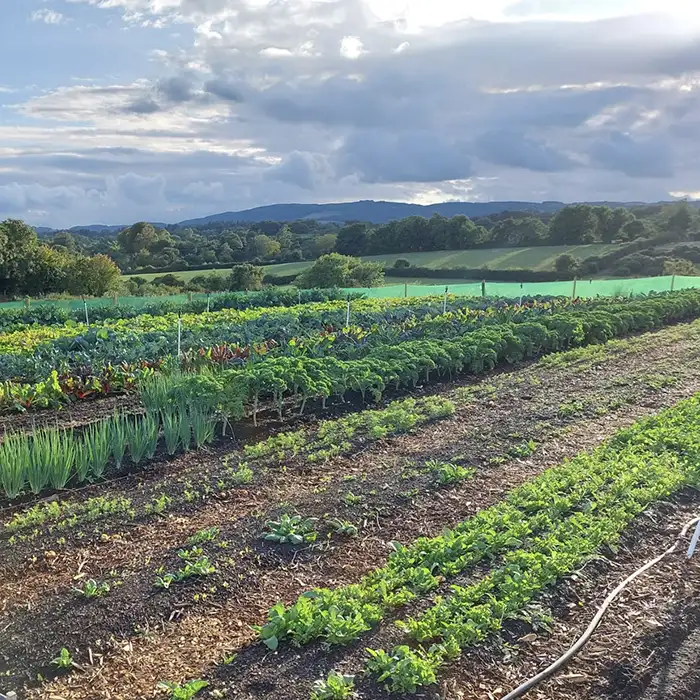
Choose Your Veg Box
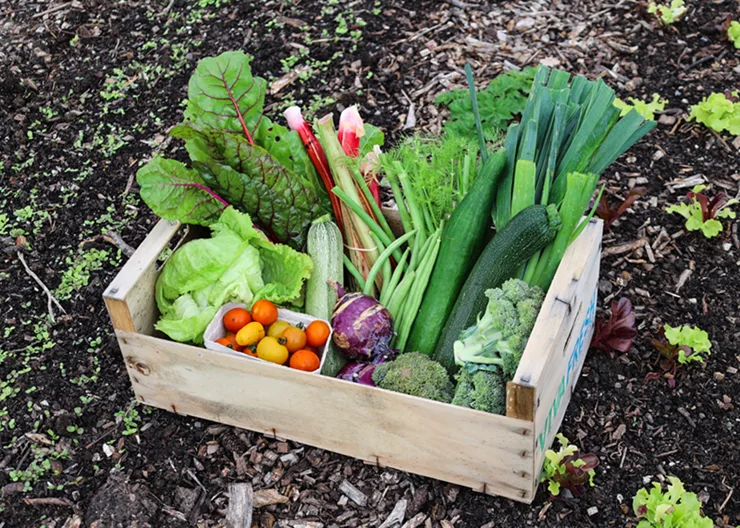
Large Veg Box
A changing selection of 9-10 organic seasonal veggies. For an idea of what to expect, take a look at next week’s box contents

Medium Veg Box
A changing selection of 8 organic seasonal veggies. For an idea of what to expect, take a look at next week’s box contents
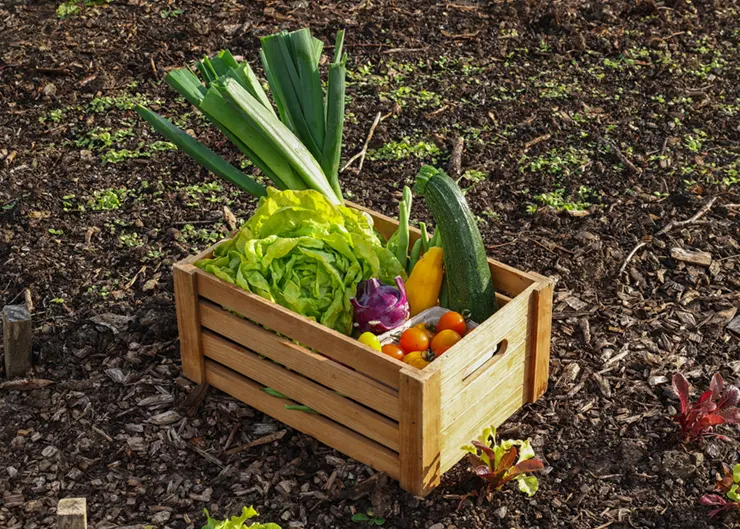
Small Veg Box
A changing selection of 5-6 organic seasonal veggies. For an idea of what to expect, take a look at next week’s box contents

Weekly Veg Box
Sign up to a weekly subscription of the Seasonal Organic Farm Produce
Each week, you’ll receive:
- The best and freshest seasonal veg that’s available on the farm. Choose to have it delivered to your door for a small extra fee or click here for more details on the pickup location options.
- A weekly newsletter filled with photos from the farm, seasonal recipes featuring the veg that’s in the box, inspiration, and cooking tips for the produce
- Invitations to events at the farm.
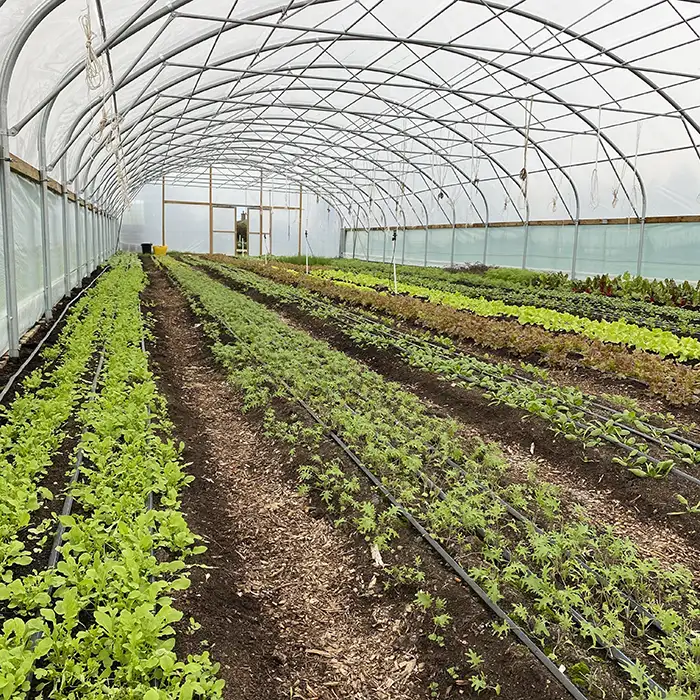
Frequently Asked Questions
You can read our FAQ on our Farm Veg Box here
About The Happy Pear Organic Farm
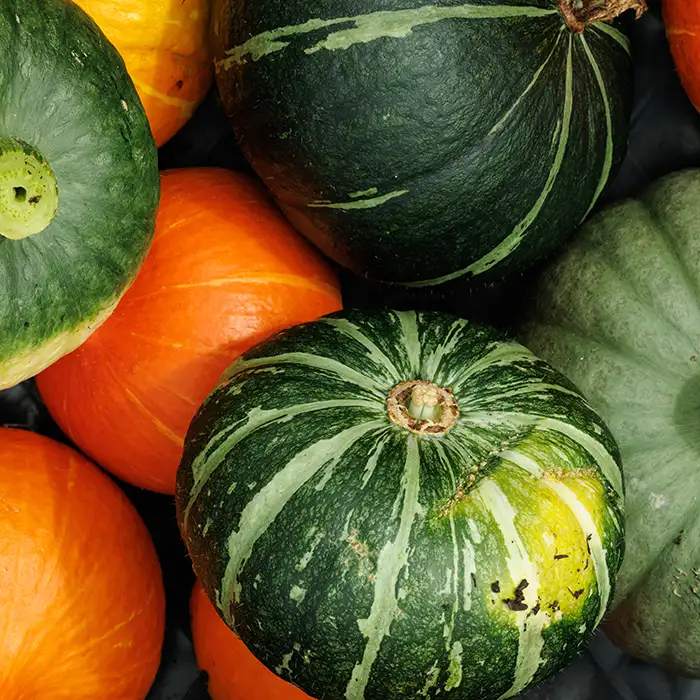
The Happy Pear farm is a 4 acre organic, regenerative farm based in Kilcoole, Co Wicklow just 10 mins south of Greystones, focused on minimum till or no dig practices where we not only adhere to the current organic growing standards but also focus on improving the soil microbe health and increasing the biodiversity around the farm through planting a mix of different pollinator species.
We produce up to 40 different crops across the full year and we provide these through a number of different channels. Our central focus is on our weekly veg box scheme where you can subscribe to receive a weekly veg box of the freshest local and in season veg and can collect it from a number of different collection points in the local area or have it delivered to their door.
We provide as much organic veg to The Happy Pear kitchen and shop in Greystones as we can across the year, we provide fresh herbs to our production facility and we sell a number of crops to local stores around the wider Greystones area.
We also have a purpose built indoor farm specialising in growing the most nutrient dense foods on the planet namely living sprouts, micro greens and wheatgrass which are available across Ireland through SuperValu, Centra and through leading foodie stores such as Nolan’s of Clontarf, Fresh supermarket, The Hopsack etc.
We began this venture in 2009 and have been using certified organic seeds since the beginning and in 2018, our Bean Mix and Alfalfa sprouts have become certified organic products themselves.
Each sprout we grow has a range of different benefits. Our Organic Bean Mix is high in protein and high in fibre. Our Organic Alfalfa Sprouts are great for stabilising blood sugar levels and are packed full of digestive enzymes making them easier to digest and absorb. Our Super Sprout Mix not only tastes great but is high in protein and a great source of fibre.
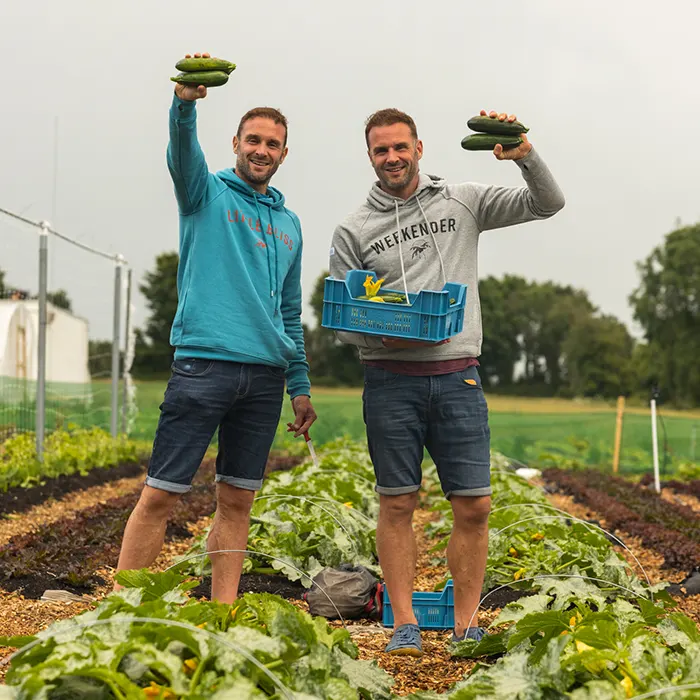
Choose Your Veg Box
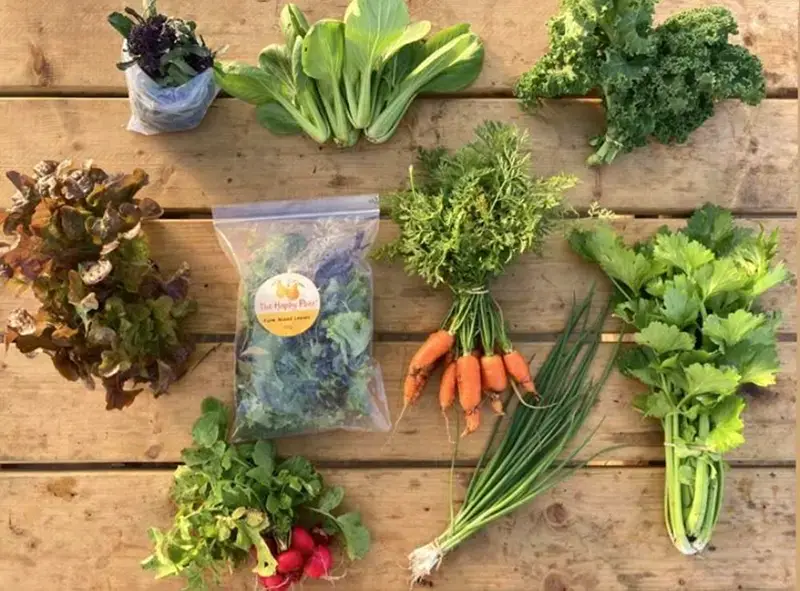
Large Veg Box
A changing selection of 9-10 organic seasonal veggies. For an idea of what to expect, take a look at next week’s box contents
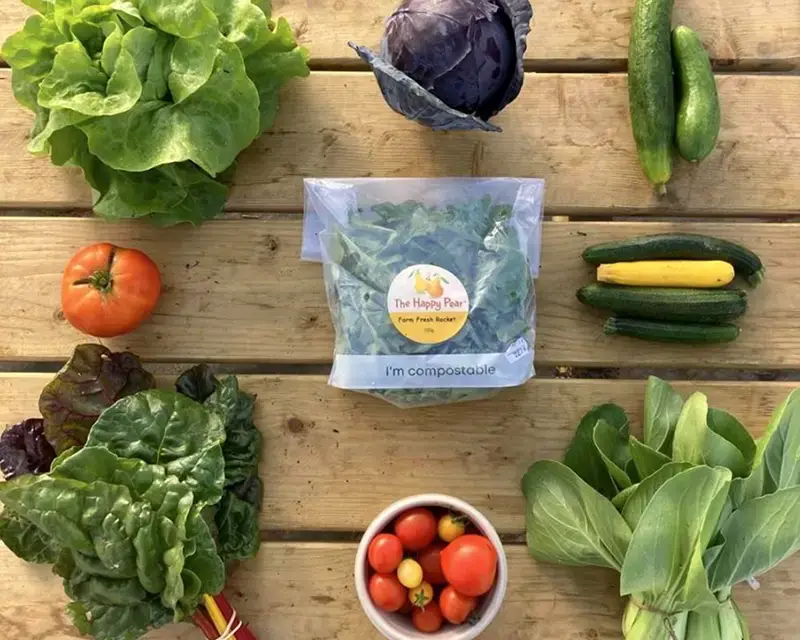
Medium Veg Box
A changing selection of 8 organic seasonal veggies. For an idea of what to expect, take a look at next week’s box contents
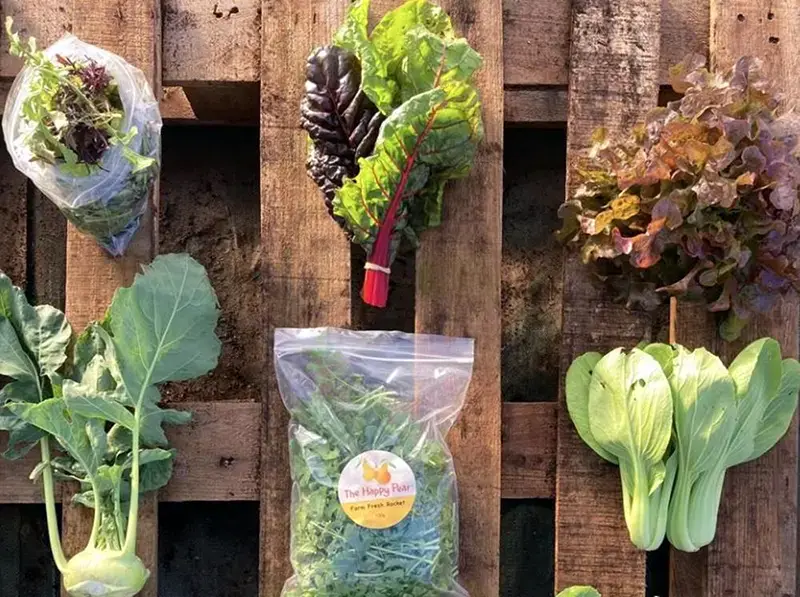
Small Veg Box
A changing selection of 5-6 organic seasonal veggies. For an idea of what to expect, take a look at next week’s box contents
The Happy Pear Podcast
We’re super excited to share this episode with you, where we chat with Nicole Masters, a soil health expert and agro-ecologist.
Episode 117
We’ve always been passionate about sustainability and living in harmony with nature, so talking to Nicole was a dream come true for us. She really knows her stuff when it comes to healthy soil, and we learned so much from her about how we can make a positive impact on the environment through regenerative agriculture and composting.
One of the things we loved about this episode was how Nicole made such a complex topic so accessible and interesting. We asked her all sorts of questions about soil health, from the benefits of cover crops to the importance of microbial diversity, and she had so many great insights to share.
We hope you enjoyed this episode as much as we did!
Lots of Love,
Dave & Steve
This episode is sponsored by Vivobarefoot Footwear. Vivobarefoot Footwear have given our listeners an exclusive 15% discount when you enter the code HAPPYPEAR15
Genuinely these are the only shoes you will see Dave & Steve wearing!
If you would like to find our more, Nicole at Integrity Soils has a range of self-directed online courses so you can read the health of your soil like a pro! Deepen your knowledge and hands-on skills to measure soil health at any scale. If you’ve been unsure about current on-farm practices and are looking to make sense of the endless recommendations that may not “add up,” these courses will give you the foundations to support you in making informed decisions to improve the health of your soil.
The Soil Horse Course: LINK
Soil Health Masterclass: LINK
Produced by Sean Cahill & Sara Fawsitt
Available now from all good podcast providers:

Focaccia Pizza in an Air Fryer
Takes
Serves 2
Ingredients
- 250 g white flour
- 200 ml warm water
- 7 g dried active yeast
- 15 g sugar (optional for a sweeter dough and more caramelisation)
- 9 g salt
- 5 tbsp olive oil
- 50 g veg toppings (mushroom, pepper and olives work great!)
Instructions
- Prepare the Dough:In a large bowl, combine the lukewarm water and yeast, stirring until well mixed. Add the flour, sugar (if using), and salt. Carefully bring the mixture together in the bowl. Knead for about 10 minutes to develop gluten. The dough will start off sticky and wet but will come together after working it for 10 minutes, becoming similar to sticky chewing gum. Alternatively, you can use a stand mixer with the dough hook on medium speed for 6-8 minutes
- First Proofing:Grease a 1lb loaf tin with 1 tbsp of olive oil, then add the dough to the tin. Cover with a towel to retain moisture and leave the dough in a warm spot to proof until it doubles in size—this should take 1-2 hours, depending on the room temperature. If using an air fryer, you can proof the dough on the "reheat" setting at 49°C for 45 minutes until it doubles or even triples in size.
- Prepare the Toppings:Thinly slice the vegetables you're using as toppings.
- Top and Dimple the Dough:Once the dough has doubled in size, sprinkle the prepared vegetables over the dough, followed by 4 tbsp of olive oil and a generous pinch of salt. Coat your fingers with a little oil to prevent sticking, and begin to "play the focaccia piano" by dimpling the dough. The vegetables should press into the dough as you create thick indents.
- Second Proofing:Cover the dough with a towel and allow it to proof a second time until it doubles in size again. Alternatively, you can speed up the process by proofing in the air fryer on the "reheat" setting at 49°C for 20 minutes.
- Bake the Focaccia:Lightly grease your fingers with some oil, then add 1 tbsp of olive oil to the dough. Dimple the dough again and sprinkle with a pinch of salt. Preheat the air fryer to 170°C and bake the focaccia for 15 minutes.
- Add the Pesto:Remove the focaccia from the air fryer, spoon over 2 tbsp of pesto, and bake for a further 5 minutes at 170°C. Take out and leave to cool before serving.
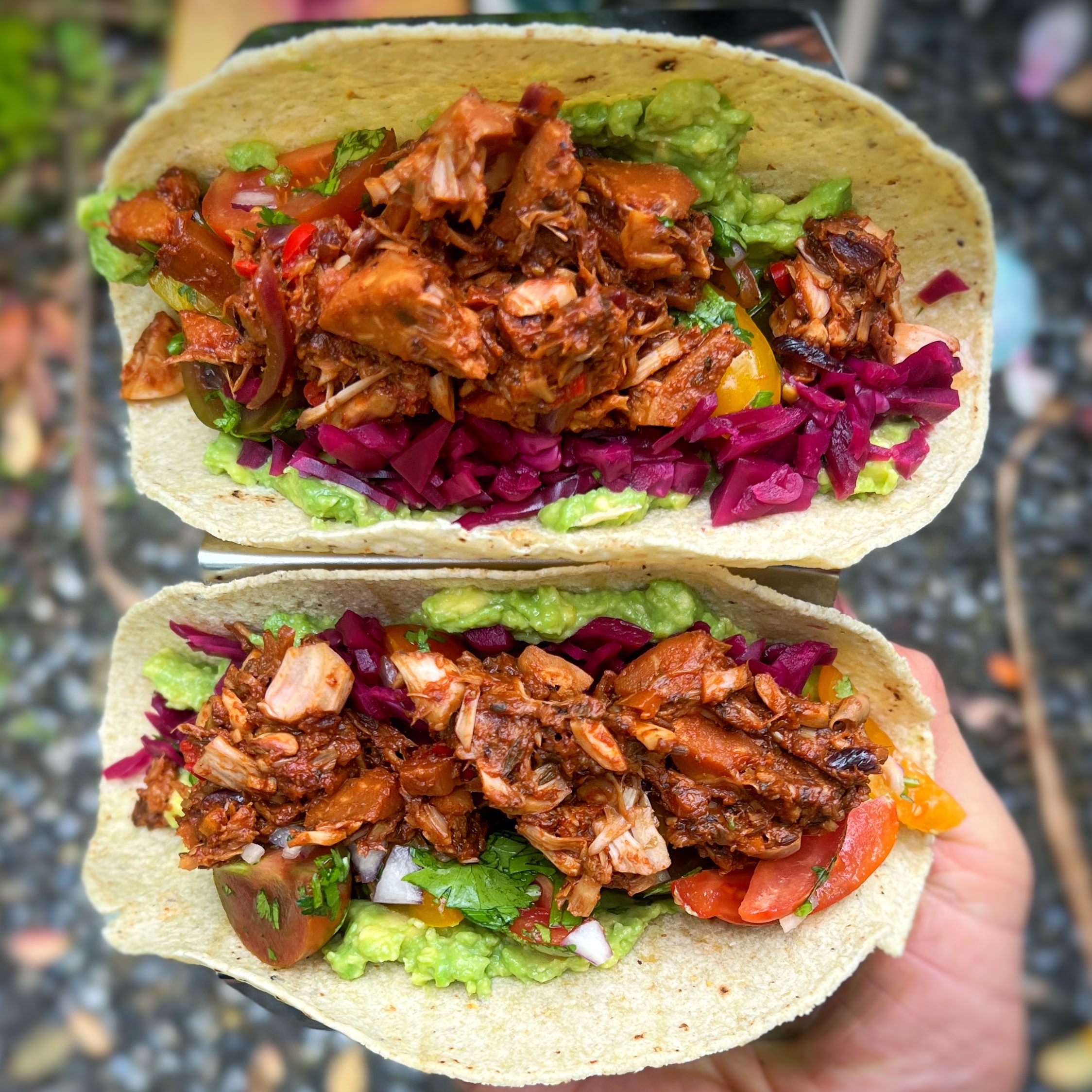
Jackfruit Carnitas with Mango Salsa
Takes
Serves 2
Ingredients
Jackfruit carne
- 1 small red onion
- 1 clove garlic
- ½ fresh red chilli
- 400 g jackfruit
- 1 tbsp cumin seeds
- 1 tbsp dried oregano
- 2 bay leaves
- 2 tbsp tamari
- 1 tsp salt
- 3 tbsp tomato puree
Smashed Avocado
- 1 ripe avocado
- ½ a lime
- Pinch of salt
Charred Mango Salsa
- 1 ripe mango
- 200 g cherry tomatoes (ideally assorted colours)
- ½ red onion
- 15 g fresh coriander
- ½ a lime
Other Ingredients
- 50 g pickled cabbage (sauerkraut)
- 6 corn or wheat tacos
Instructions
- Prep the ingredients for the jackfruit carne:Peel and dice the red onion and garlic.Finely dice the red chilli.Drain, rinse, and finely chop the jackfruit.
- Fry the base flavours:Heat 1 tsp of oil in a wide-bottomed pan on high heat.Add the cumin seeds, diced onion, and chilli. Fry for 3-4 minutes until softened.
- Add garlic and jackfruit:Add the diced garlic and chopped jackfruit to the pan.Fry for an additional 4-5 minutes, stirring occasionally.
- Incorporate the spices and liquids:Stir in the oregano, bay leaves, tamari, tomato purée, and salt.Mix well until all the flavours are evenly combined.
- Braise the mixture:Add 2 tbsp of water and allow the mixture to braise, stirring to deglaze any bits stuck to the pan.Taste and adjust the seasoning as needed. Remove from the heat and set aside.
- Make the charred mango salsa:Cut the cheeks off the mango and char them in a hot pan until golden on the flesh side.Remove the skin and cut the flesh into small pieces.Quarter the cherry tomatoes, peel and finely dice the red onion, and finely chop the coriander.Mix these ingredients together with the juice of half a lime.Season with salt and black pepper to taste.
- Prepare the smashed avocado:Remove the flesh from the avocado and mash it with the juice of the remaining lime half and a pinch of salt.Mash until smooth, then taste and adjust the seasoning.
- Char the tacos:Lightly char the corn or wheat tacos in a dry pan until slightly crispy.
- Assemble the tacos:Spread a layer of smashed avocado on each taco.Add the mango salsa, pickled cabbage, and jackfruit carne.Repeat for the remaining tacos and fillings.Serve and enjoy!

Creamy Tomato and Wild Garlic Pasta
Takes 30 minutes
Serves 2
Ingredients
- 300 g pasta (we used Casarecce)
- 250 g cherry tomatoes
- 150 g oyster mushrooms
- 340 g roasted peppers
- 2 tbsp tamari
- 1 red onion
- ½ chilli
- 35 g wild garlic or 3 spring onions
- 2 sprigs rosemary
- 200 g yoghurt
- 2 tbsp olive oil
Instructions
- Cook the pastaFill and boil the kettle. Once boiled, fill a large saucepan with the hot water and a generous pinch of salt. Add the pasta and cook according to the packet instructions. Once cooked, drain the pasta and rinse, reserving 1 cup (approx. 240ml) of the pasta water.
- Prepare the vegetablesPeel and finely dice the onion.Quarter the cherry tomatoes.Finely dice half the chilli.Shred the oyster mushrooms using a fork until they are completely torn apart.Finely dice the wild garlic or scallions.Remove the rosemary leaves from the stalks and finely chop.
- Cook the vegetablesHeat a non-stick frying pan on high heat. Add the olive oil and, once hot, fry the diced onion for 3-4 minutes until it starts to brown around the edges.Add the shredded mushrooms and rosemary to the pan, cooking for another 4 minutes. Then, stir in the tamari (or soy sauce), ensuring each mushroom absorbs the flavour.Add the quartered cherry tomatoes and wild garlic/scallions, along with a pinch of salt, and mix well. Cook while you finely chop the roasted red peppers.
- Add the roasted peppersDiscard any brine from the roasted peppers (or save it for pickling), then add the chopped peppers to the pan. Mix well and cook for 2-3 minutes.
- Create the creamy saucePour in half of the reserved pasta water (approx. 100ml), along with the yoghurt. Stir through and let it simmer for 2 minutes. Taste and adjust the seasoning as needed.
- Combine pastaAdd the cooked pasta to the pan and mix well to coat in the sauce. Serve immediately – and if possible, enjoy in the sunshine for an extra-special meal!
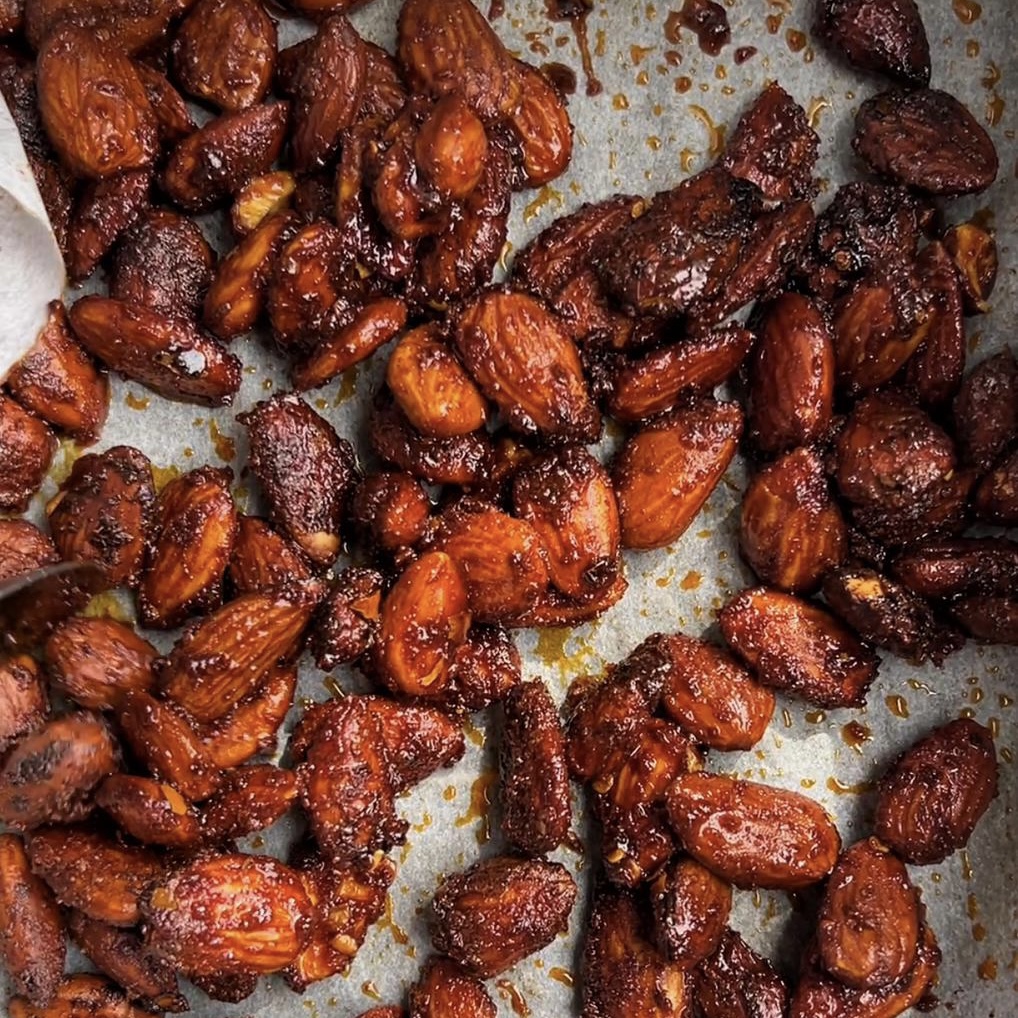
Roasted Spiced Almonds
Takes
Serves
Ingredients
- ½ tbsp oil (10 sprays)
- 100 g raw almonds
- 1 tbsp tamari
- 1 tbsp maple syrup
- ¼ tsp garlic powder
- ¼ tsp smoked paprika
- ½ tsp sweet paprika
- ¼ tsp chilli powder
- Pinch of salt
Instructions
- Preheat the air fryer to 180°C.
- Place the almonds in a bowl.
- Add the oil, tamari, and maple syrup to the almonds, mixing well to ensure they're evenly coated.
- Sprinkle the garlic powder, smoked paprika, sweet paprika, chilli powder, and salt over the almonds.
- Mix well to coat the almonds with the spices.
- Transfer the almonds to the air fryer and bake for 5 minutes at 180°C.
- Once done, remove the almonds from the air fryer and allow them to cool.
- Enjoy!
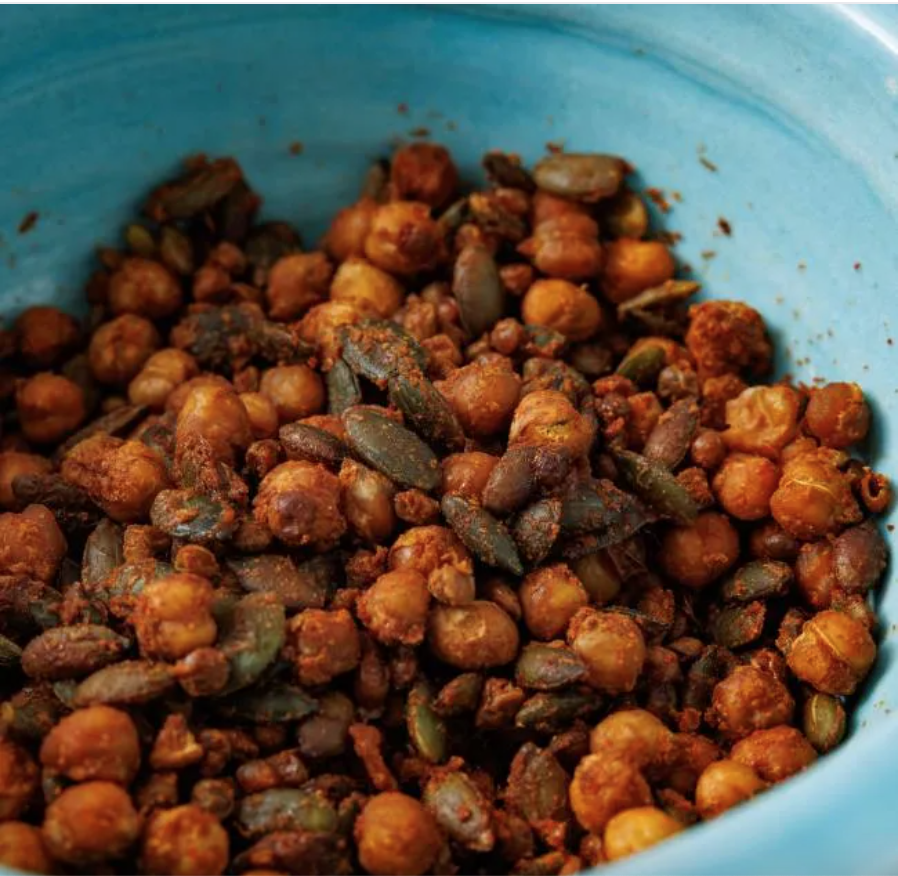
Crispy Cajun Spiced Protein Pulses
Takes 13 minutes
Serves
Ingredients
- 150 g cooked chickpeas
- 100 g cooked lentils
- 50 g pumpkin seeds
- 4 tbsp tamari
- 4 tbsp nutritional yeast
- ½ tsp garlic powder
- ⅓ tsp chilli powder
- 1 tsp smoked paprika
- Good pinch of salt
- 10 sprays oil
Instructions
- Preheat the air fryer to 180°C.
- If using tinned chickpeas and lentils, drain and rinse them (no need to dry).
- In a bowl, combine the chickpeas, lentils, pumpkin seeds, tamari, nutritional yeast, garlic powder, chilli powder, smoked paprika, and salt.
- Mix well to ensure everything is evenly coated.
- Transfer the mixture to the air fryer basket.
- Cook for 15 minutes at 180°C.
- Once done, remove from the air fryer and allow the pulses to cool.
- Enjoy!
The Happy Pear Podcast
Today we had an amazing conversation with the wonderful author of 14 parenting books, Sarah Ockwell-Smith.
Sarah studied psychology and after becoming a mother began to dive deep into the psychology and science of parenting. She has recently re-released her book: The Gentle Parenting book
Episode 115
In this episode we started off by discussing the history of parenting advice and how it has evolved over time. Sarah explained how in the past, parenting was much more community-based, with family members and neighbors providing support and guidance. However, with the industrial revolution, families became more isolated and parenting advice began to be sold as a commodity.
We then delved into current parenting trends, such as attachment parenting and positive parenting, and how these approaches have become more popular in recent years. Sarah emphasized that while it’s great to have a framework to work within, ultimately a parent’s own intuition is the most important part of parenting.
We also talked about the importance of empathy and understanding in parenting, and how it can be challenging to stay calm and patient in the face of difficult behavior from our children. Sarah provided some great tips on how to handle these situations with grace and compassion.
Overall, it was an incredibly insightful conversation and we learned so much from Sarah. We hope you enjoy listening to this episode as much as we enjoyed recording it!
Enjoy!
Lots of Love,
Dave & Steve
This episode is sponsored by Instant Vortex Plus VersaZone Air Fryer . Currently on special offer: now £159.99 a saving of £60 until 8th May. Follow this link to find out more: https://bit.ly/3KPCiEj
Produced by Sean Cahill & Sara Fawsitt
Available now from all good podcast providers:
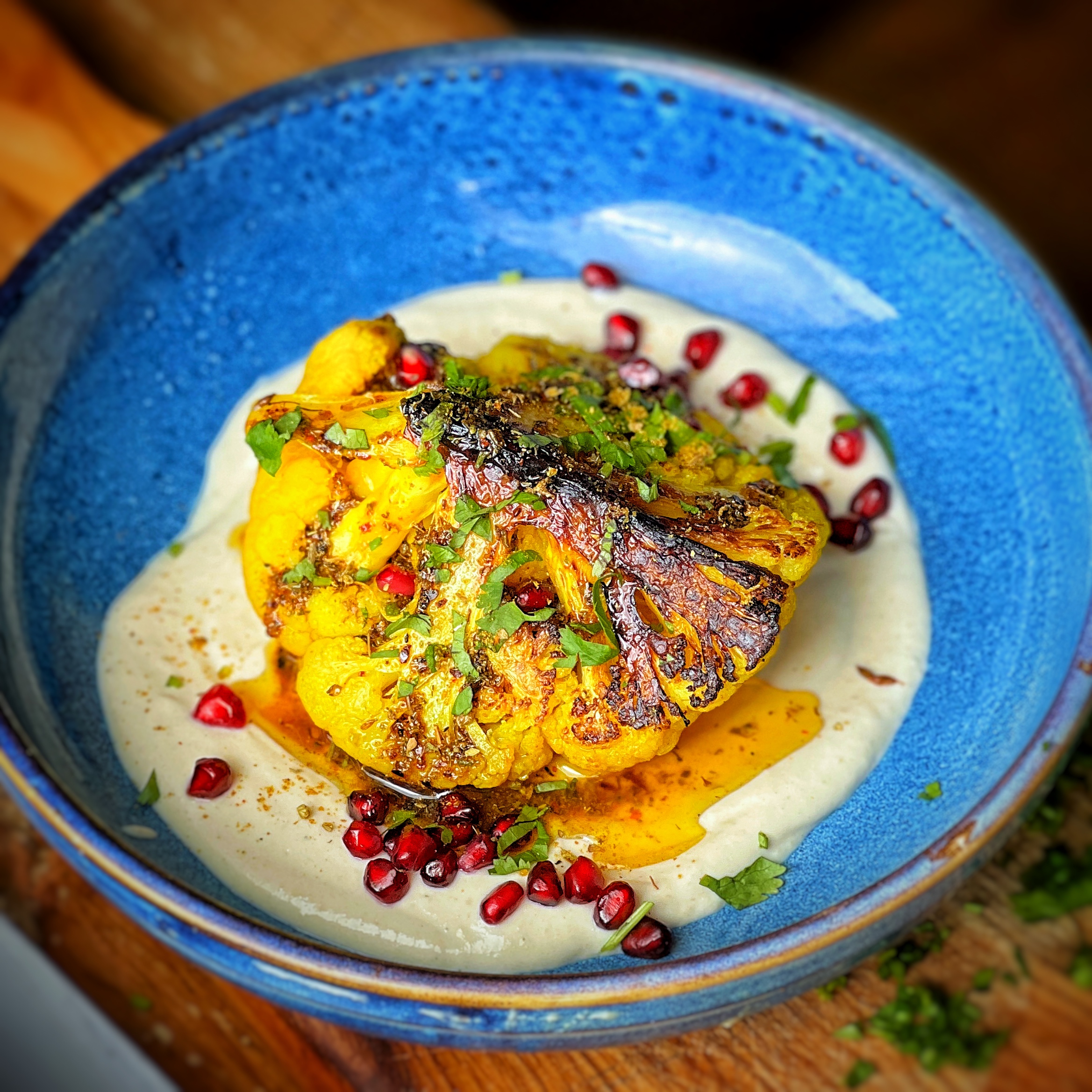
Za’atar Charred Cauliflower with Tahini Cream
Takes 25 minutes
Serves 3
Ingredients
Cauliflower
- 1 cauliflower
- 1 tbsp ground turmeric
- 2 tbsp cumin seeds
Tahini Cream
- 500 g soy yoghurt
- 8 tbsp light tahini
- 1 lemon (juiced)
Za'atar glaze
- 2 tbsp za'atar
- 2 tbsp tamari
- 1 tbsp maple syrup
- 3 tbsp oil
- ½ tbsp smoked paprika
To serve
- 1 pomegranate
- Fresh coriander (or flat parsley)
Instructions
- Fill and boil the kettle. Cut the cauliflower into 4 even quarters, including the leaves, and give it a good wash.
- Remove the tender, smaller leaves and cut them in half lengthwise.
- Place the cauliflower and leaves in a large saucepan, then fill it with the just-boiled water, a generous pinch of salt, and 1 tbsp of ground turmeric.
- Cook on high heat for approximately 8–10 minutes until the cauliflower is cooked but still firm enough to hold its shape.
- Drain and rinse the cauliflower, allowing it to dry for a minute.
- For the tahini cream, mix together the tahini, soy yoghurt, lemon juice, and a pinch of salt until well combined and creamy.
- Heat a wide-bottomed, non-stick pan on high heat and add 2 tbsp of oil. Once hot, add the cumin seeds, then carefully place the cauliflower quarters cut-side down in the pan. Cook each side until golden brown and charred.
- While the cauliflower is cooking, mix together the ingredients for the za’atar glaze until well combined.
- Finely dice the fresh coriander and deseed the pomegranate.
- To serve, spread a generous amount of tahini cream on the bottom of a plate or a wide-bottomed bowl.
- Place a charred cauliflower quarter, cut-side up, on top of the tahini cream.
- Drizzle 2–3 tbsp of the za'atar glaze over the cauliflower, then garnish with pomegranate seeds and chopped coriander.
- Serve and enjoy!
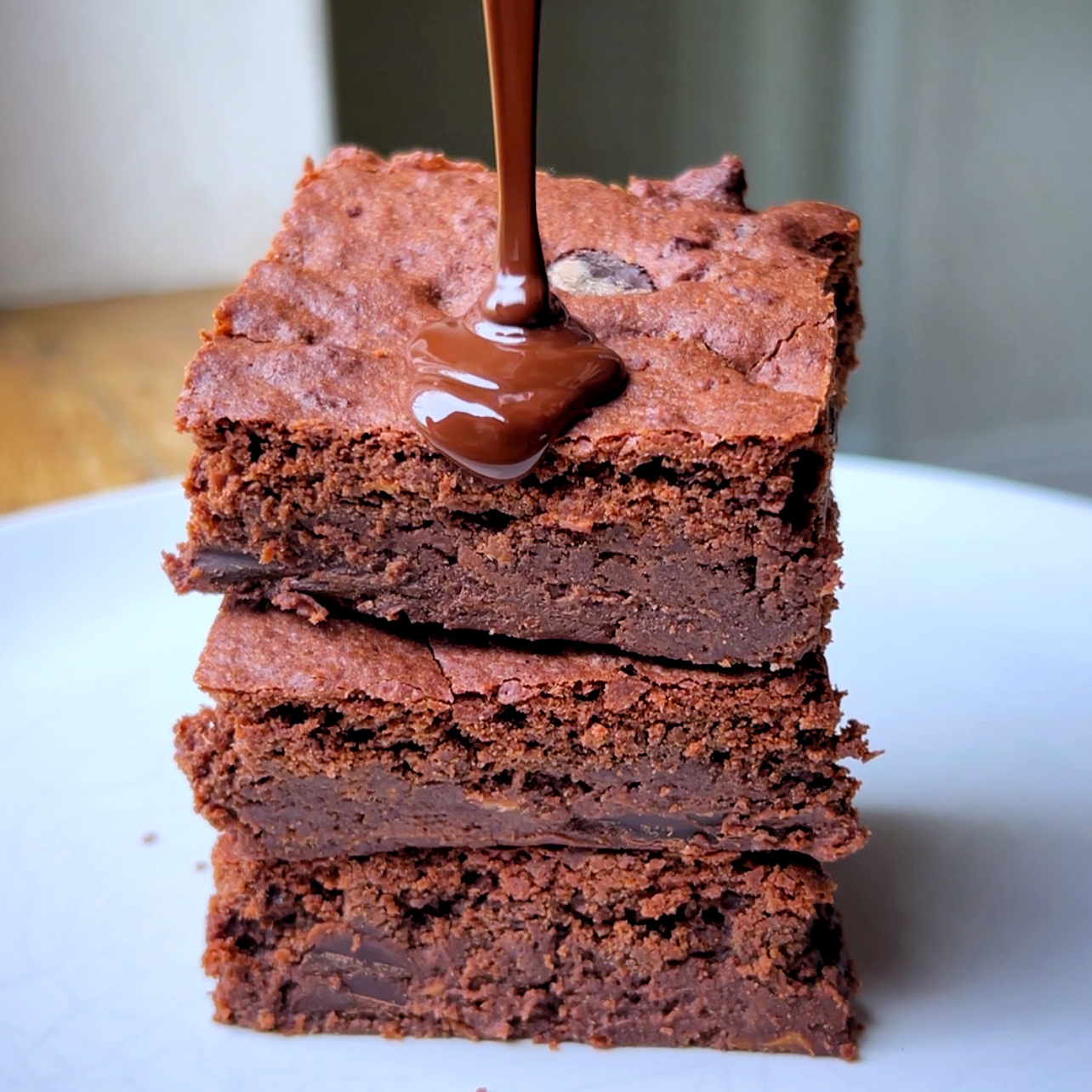
Sweet Potato Fudgy Brownies
Takes 45 minutes
Serves 8
Ingredients
- 200 g sweet potato (50g cooked)
- 65 g vegan butter
- 100 g chocolate
- 75 ml water
- 75 g self raising flour
- 30 g cornstarch
- 150 g caster sugar
Instructions
- Prepare the Sweet Potato:Peel and chop the sweet potato into small bite-sized pieces. Place the sweet potato in a 1 lb loaf tin (approx. 450 g tin with high sides) and bake in the air fryer at 160°C for 15 minutes.
- Melt the Chocolate and Butter:Break the chocolate into small pieces (similar to chocolate chips). Melt the vegan butter over a bain-marie (water bath). Once the butter is almost melted, add in half of the chocolate and the water. Stir until fully melted, then remove from the heat.Add the baked sweet potato to the chocolate mixture and blend until super smooth. You can use a blender, stick blender, or food processor for this step.
- Combine Dry and Wet Ingredients:In a separate bowl, mix the self-raising flour, cornstarch, and caster sugar together. Make a well in the centre and pour in the blended chocolate and sweet potato mixture. Stir until well combined.Gently fold in the remaining chocolate pieces.
- Bake the Brownies:Line the loaf tin with baking paper and pour in the brownie batter.Bake in the air fryer at 170°C for 25 minutes.Once baked, leave the brownies to cool and set for 1 to 2 hours before slicing. Though waiting is difficult, it’s well worth it!
The Happy Pear Podcast
Mary is a reformed internationally acclaimed landscape designer who launched her career at the Chelsea flower show in 2002, being the youngest contestant to win gold. The story of which was made into a 2016 movie called “Dare to be Wild”.
Episode 114
She is a bestselling author, inspirational speaker, occasional television presenter and founder of the global movement “We are the ARK”, a practical groundswell movement who’s aim is to shift the environmental game in nature’s favour.
“The time for gardens as canvases for our creative pleasure is over. Everything must change and if we are to save the planet, then we must start with our own patches of it. It’s time to reimagine our work as gardeners, to become leaders in the race to save our beautiful planet, to save ourselves.”
We had the privildege of recording this episode in person, it was truly inspiring, chilling and brilliant. Mary is wonderful!
Enjoy!
Lots of Love,
Dave & Steve
To find our more about Mary, her book and her work, visit: https://marymary.ie/
Produced by Sean Cahill & Sara Fawsitt
Available now from all good podcast providers:
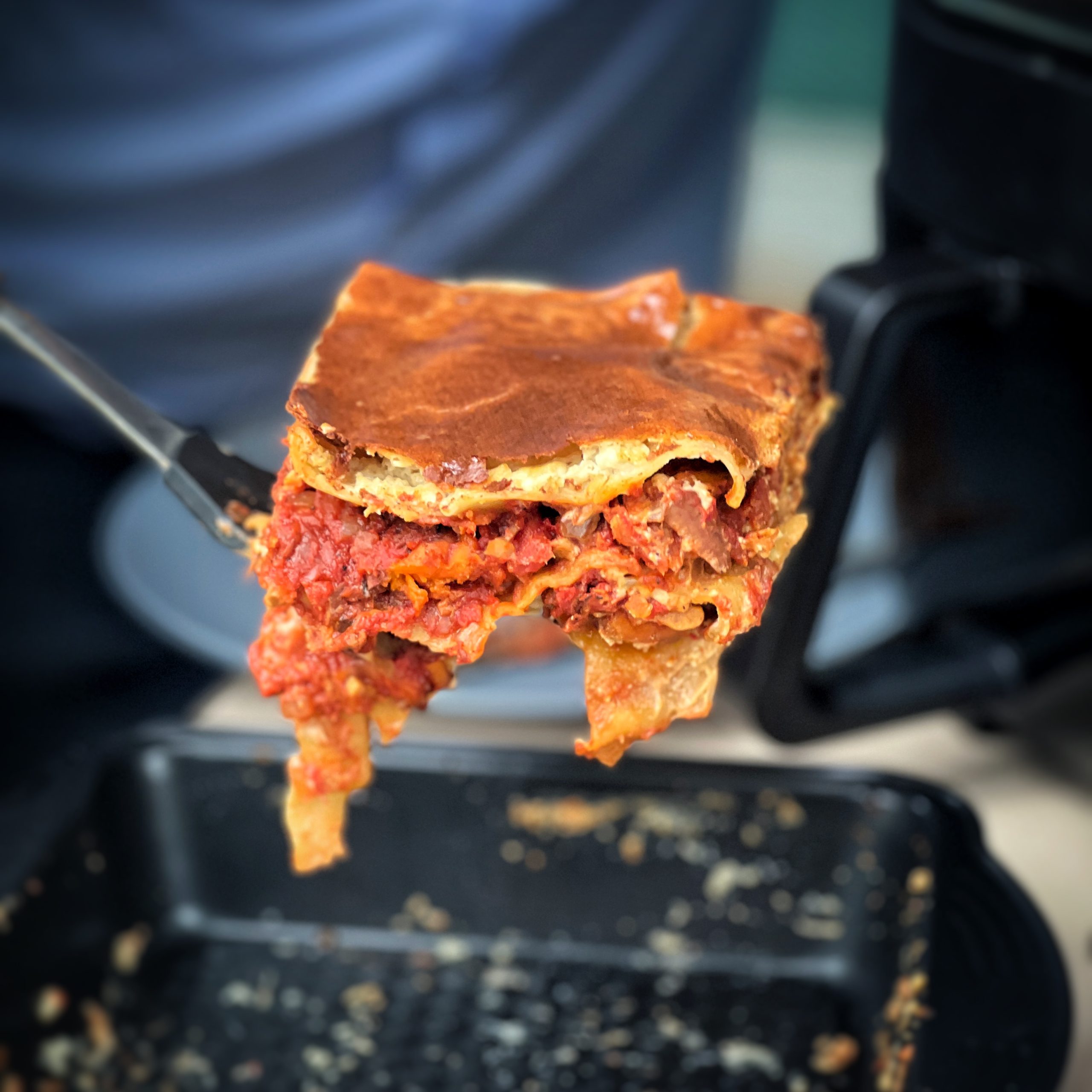
Easy Air Fried Lasagne
Takes
Serves 6
Ingredients
For the Lasagne
- 250 g lasagne sheets (½ pack)
For the White Sauce (Cashew Cream)
- 150 g raw cashew nuts
- 300 ml oat milk
- 3 tbsp nutritional yeast (optional)
- 1 tsp lemon juice
- ⅓ tsp salt
- ½ tsp black pepper
- ½ tsp garlic powder (optional)
For the Tomato Sauce
- 1 onion (peeled and finely chopped)
- 3 cloves garlic (minced)
- 1 medium carrot (grated)
- 150 g mushrooms (finely sliced)
- 1 sweet potato (350g, cut into bite-sized pieces)
- ½ red chilli (finely chopped, omit if you prefer less spice)
- 2 x 400g tins chopped tomatoes
- 100 g tomato purée
- 1 tbsp maple syrup
- 1 tsp salt
- ½ tsp black pepper
- 2 tbsp tamari or soy sauce
Instructions
- Preheat the Air FryerPreheat the air fryer to 180°C.
- Cook the Sweet PotatoChop the sweet potato into bite-sized pieces. Place them in the air fryer with a pinch of salt and 5 sprays of oil (or ¼ tsp).Bake for 20 minutes, then set aside.
- Make the Cashew CreamPlace the cashew nuts in a small pot and cover with boiling water. Simmer for 10 minutes to soften them. Once softened, drain and rinse the cashews.Put all the cashew cream ingredients (oat milk, cashews, nutritional yeast, lemon juice, salt, black pepper, and garlic powder) into a blender. Blend until smooth, which should take about 2 minutes. Taste and adjust seasoning if needed.
- Make the Tomato SauceHeat a wide non-stick pan on high heat. Once hot, add a few sprays of oil, then the chopped onion, mushrooms, and a pinch of salt. Cook for 5 minutes, stirring regularly. If the vegetables start to stick, add 1 tbsp water or a few sprays of oil to deglaze the pan.Add the tamari/soy sauce and mix to coat the vegetables. Next, add the grated carrot, garlic, and chilli. Cook for 3 minutes, stirring regularly. If any vegetables start to stick, add water or oil as before. Cook until the onions begin to brown at the edges and the mushrooms are reduced.Add the chopped tomatoes, tomato purée, maple syrup, salt, black pepper, and the baked sweet potato. Bring to a boil, then reduce heat and simmer for 10 minutes. Taste and adjust seasoning if needed. Set aside.
- Assemble the LasagnePreheat the air fryer to 180°C again. Spread a thin layer of cashew cream on the bottom of a lasagne tray.Add a layer of lasagne sheets, breaking some to fit and ensuring no overlaps (overlapping sheets won't cook properly).Spread half of the tomato sauce evenly over the lasagne sheets.Add another layer of lasagne sheets on top of the tomato sauce.Spread half of the remaining cashew cream over the lasagne sheets.Add the rest of the tomato sauce and spread evenly.Add another layer of lasagne sheets.Finally, top with the remaining cashew cream.
- Cook the LasagnePlace the assembled lasagne in the air fryer and cook at 180°C for 20 minutes.
- ServeOnce cooked, allow the lasagne to cool slightly. To cut the lasagne easily, use kitchen scissors. Serve and enjoy!
Nutrition

Caramelised Banana Cake with Chocolate
Takes 1 hour
Serves 12
Ingredients
- 3 bananas (for caramelised topping)
- 150 g caster sugar
- 2 tbsp water (for caramel)
- 100 g chocolate chips
- 200 g self-raising flour
- 1½ tsp ground cinnamon
- 120 ml sunflower oil
- 150 g maple syrup
- 2 tbsp ground flaxseeds
- 6 tbsp water (for flax egg)
- 3 bananas (for the cake batter)
- 50 g walnuts (roughly chopped)
Instructions
- Preheat the oven:Preheat your oven to 160°C (fan) / 180°C (conventional).
- Prepare the cake tin:Line a 9-inch springform tin with baking parchment. Slice the 3 bananas for the topping lengthwise and place them, cut side down, in the prepared tin.
- Make the caramel:In a wide saucepan, heat the 150g caster sugar over medium heat. Add the 2 tbsp water and stir just once. From this point, avoid stirring and simply swirl the saucepan occasionally. Allow the sugar to melt and turn golden, forming a smooth caramel. Stir towards the end if necessary to achieve a smooth consistency. Remove from heat before the caramel turns too dark, as it can quickly burn. Pour the caramel evenly over the bananas in the tin and leave to cool.
- Prepare the flax egg:In a small bowl, mix the ground flaxseeds with 6 tbsp water. Leave to sit for 5 minutes, allowing the mixture to thicken and coagulate.
- Prepare the cake batter:In a large bowl, combine the self-raising flour, ground cinnamon, and chopped walnuts.In a blender, combine the 3 peeled bananas, sunflower oil, maple syrup, and the flax egg mixture. Blend until smooth.If you don't have a blender, mash the bananas in a separate bowl and whisk together with the oil, syrup, and flax egg until well mixed.Add the wet mixture to the dry ingredients and stir until you achieve a smooth batter. Fold in the chocolate chips.
- Assemble the cake:Pour the cake batter over the caramel-coated bananas in the tin, spreading it evenly.
- Bake the cake:Place the cake in the preheated oven and bake for 35-45 minutes, or until a skewer inserted into the centre comes out clean.
- Flip the cake:Once baked, run a palette knife around the edges of the tin to loosen the cake.Place a flat plate or board on top of the tin, then carefully flip the cake so that the caramelised bananas are on top. If any bananas stick to the tin, gently scrape them off and arrange them back on the cake.
- Cool and serve:Allow the cake to cool slightly before slicing. Serve and enjoy!
Nutrition

A mighty Korma bursting with wholesome veggies, coconut & chilli. 2 of your 5 a day and only 307 kcals per pot.
INGREDIENTS
Coconut Milk (21%) [Coconut Extract, Water], Tomatoes (15%), Water, Carrots (9%), Yellow Split Peas (8%), Peas (8%), Onions, Red Peppers, Coconut Flakes, Spring Onion, Spices, Garlic Purée, Corn Starch, Ginger Purée, Rapeseed Oil, Agave Syrup, Desiccated Coconut, Salt, Red Chillies (0.4%), Coriander, Garlic Powder, Mustard
ALLERGEN INFORMATION
For allergens, see highlighted ingredients.
May contain traces of Nuts.
NUTRITIONAL INFORMATION
| Typical | per 100g |
|---|---|
| Energy | 330kJ / 80kcal |
| Fat | 5.2g |
| Of which Saturates | 4.1g |
| Carbohydrate | 4.5g |
| Of which Sugars | 3.5g |
| Fibre | 3.2g |
| Protein | 2.1g |
| Salt | 0.55g |

A creamy fusion of tomato, coconut milk and aromatic spices & brown rice. 2 of your 5 a day and only 337 kcals per pot.
INGREDIENTS
Coconut Milk (20%) [Coconut Extract, Water], Tomatoes (16%), Water, Carrots (10%), Onions, Red Peppers (6%), Sweet Corn, Yellow Split Peas, Brown Rice (3%), Spinach, Tomato Paste, Spices (1%), Garlic Purée, Agave Syrup, Rapeseed Oil, Ginger Purée, Corn Starch, Paprika, Salt, Red Chillies, Coriander, Ginger Powder, Garlic Powder, Mustard
ALLERGEN INFORMATION
For allergens, see highlighted ingredients.
May contain traces of Nuts.
NUTRITIONAL INFORMATION
| Typical | per 100g |
|---|---|
| Energy | 373kJ / 89kcal |
| Fat | 4.0g |
| Of which Saturates | 2.7g |
| Carbohydrate | 9.7g |
| Of which Sugars | 4.5g |
| Fibre | 3.0g |
| Protein | 2.1g |
| Salt | 0.6g |









